

Cover price US & CAN $9.95 Regionally in New Mexico Display until Spring 2024 Newsstand display until September 30, 2023 POWER AND POETRY The Art of Rose B. Simpson SANTA FE ALBUQUERQUE TAOS ABIQUIU Plus ten more dazzling photo essays by some of our best artists behind the lens LOOKBOOK ANNUAL 2023 VOLUME 24

WOODS DESIGN | BUILDERS CONSISTENTLY THE BEST
and building the finest homes in Santa Fe for over 46 years photography
Designing
: © Wendy McEahern | Architectural Design and Construction
WOODS DESIGN BUILDERS 302 Catron Street, Santa Fe, New Mexico 87501 • 505.988.2413 • woodsbuilders.com
: Woods Design Builders and Lorn Tryk



MICHAEL VIOLANTE & PAUL ROCHFORD 401 Paseo de Peralta, Santa Fe, NM 87501 505.983.3912 | vrinteriors.com convenient parking at rear of showroom
photo © Wendy McEahern


DAVID PEARSON PATRICIA CARLISLE FINE ART, INC. PEARSON STUDIO & SCULPTURE GARDEN 5 SCULPTURE | SANTA FE, NM 87508 505-820-0596 | CARLISLEFA.COM ADDISON DOTY (2)


Call to schedule a studio/showcase visit. Open 6 days a week. Closed on Thursdays.





STAN BERNING Stan Berning’s ART BOX | 901 Canyon Road | Santa Fe, New Mexico 87501 stanberningstudios.com | stan@stanberning.com | 928-460-2611 Abiquiu Inn / Cottonwood Grove, watercolor/gouache, 18” x 24”, 2023

 View to Pojoaque / 8 AM, watercolor/gouache, 18” x 24”, 2021 Black Mesa / Clarified, watercolor/gouache, 18” x 24”, 2023
View to Pojoaque / 8 AM, watercolor/gouache, 18” x 24”, 2021 Black Mesa / Clarified, watercolor/gouache, 18” x 24”, 2023










SANTA FE SOPHISTICATION Santacafe.com 231 Washington Avenue 505.984.1788






Coyotecafe.com 132 West Water Street 505.983.1615


ETHELINDA Ghost Dance Lady - Southern Arapaho 60x40 oil on canvas 123 West Palace avenue 505.986.0440 info@manitougalleries.com


ETHELINDA Dutch 50x66 oil on canvas 123 West Palace avenue 505.986.0440 WWW.manitougalleries.com











SOFAS / CHAIRS / LIGHTING / CUSTOM UPHOLSTERY THROW PILLOWS / DINING / RUGS COLLECTIBLE & WALL ART / MIRRORS & MORE N EVER O RDINARY Always Extraordinary 530 South Guadalupe Street In the Historic Santa Fe Railyards 505.230.7000 Mon-Sat 10am-5pm / Sun 11am-4pm

1512 Pacheco St. A103 Santa Fe, NM 505.365.2687 VictoriaatHome. com Home Furnishings and Interior Design Retail and to the Trade
DANIEL NADELBACH

Wiford Gallery Art As Emissary www.wifordgallery.com | @wifordgallery SCIENCE BECOMES ART Come and see A NEW GENRE OF FINE ART from the Father of "vibrant toning on copper" TIM CHURCH exclusively at Wiford Gallery Santa Fe Opening July 21 at 5PM; through July 30, 2023 403 Canyon Road | (505) 577 - 0888


BETTE RIDGEWAY RED ON RED Santa Fe Palm Desert Carmel-by-the-Sea Sausalito Ft. Lauderdale Delray Beach Jupiter Naples Dallas Seattle Atlanta Charleston, SC RidgewayStudio.com PURE SENSUOUS COLOR

Euro-Asian Modernist We Dress Your Life 101 W. Marcy Street, #2 Downtown Santa Fe tokosantafe@gmail.com 505-470-4425 tokosantafe.com

DAN NAMINGHA 125 Lincoln Avenue • Suite 116 • Santa Fe, NM 87501 Monday–Saturday, 10am–5pm 505-988-5091 • nimanfineart@namingha.com • namingha.com • Representing Dan, Arlo, and Michael Namingha
HOPI HORIZON #29 Acrylic on Canvas 30˝ X 48˝ Dan Namingha ©2023

 Jennifer & Kevin Box Studio & Sculpture Garden
Jennifer & Kevin Box Studio & Sculpture Garden
OPENING THIS SUMMER July 10 – October 13
Hero’s Horse, 2022 18’ x 18’ x 18’
Powder coated fabricated stainless steel KevinBoxStudio
New Mexico Landscape mixed media, 56" x 56"
KATE RIVERS
600

INGRAHAM
LINDA
Canyon Road Santa Fe, NM kaycontemporaryart.com


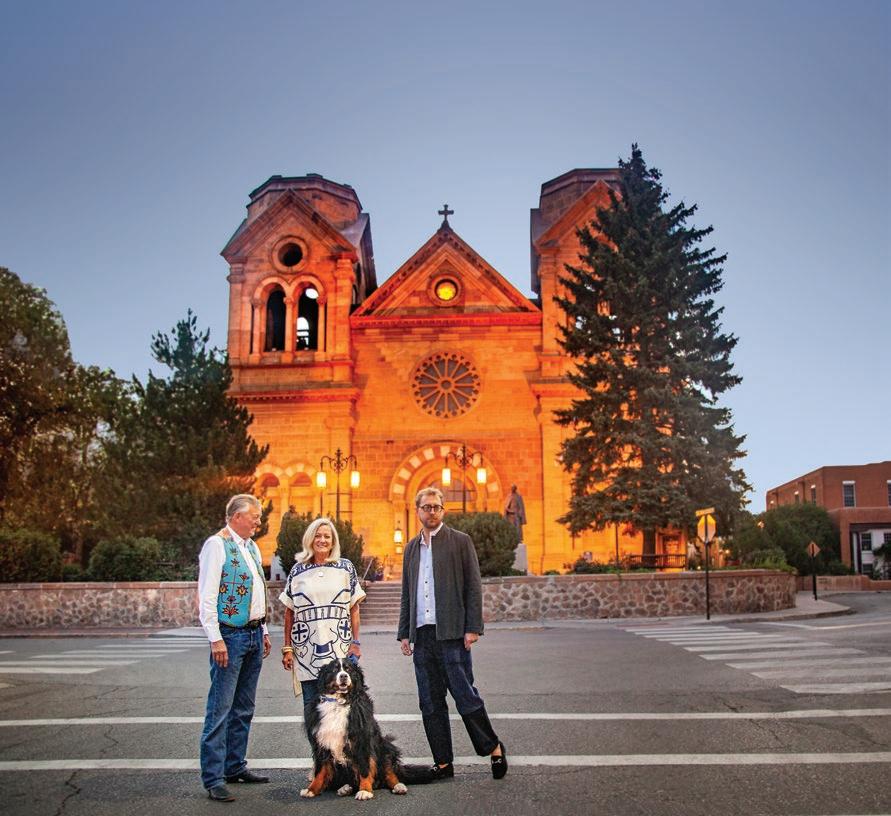
© 2023 Sotheby’s International Realty, 505.988.2533. All Rights Reserved. Sotheby’s International Realty® is a registered trademark and used with permission. Each Sotheby’s International Realty office is independently owned and operated, except those operated by Sotheby’s International Realty, Inc. All offerings are subject to errors, omissions, changes including price or withdrawal without notice. Equal Housing Opportunity. HEADQUARTERED ON THE HISTORIC SANTA FE PLAZA SINCE 1972 WEBSTERSANTAFE.COM | 505-954-9500 | THE PLAZA | 54 ½ LINCOLN AVENUE | SANTA FE Specializing in the Most Extraordinary! PROPERTIES, ART, APPAREL — PAST, PRESENT, FUTURE Chris, Patti, and Christopher Webster
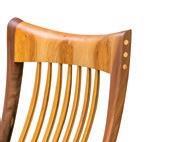


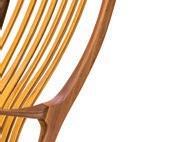


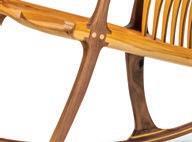



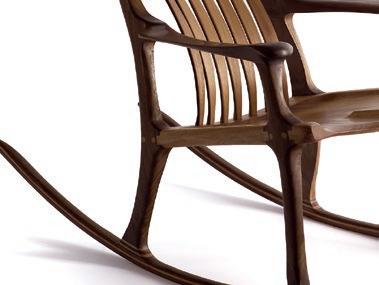




sf rockers.com | RBWing | 505-490-9003 Repose, Relax, Reset | Maloof-inspired | Solid Wood Rockers Unique & Comfortable | $6,000 + tax santa
ocker
fe r
s


belt buckles + jewelry + gifts 662 canyon road | santa fe, nm 87501 505.986.9115 | johnrippel.com
PHOTO: © WENDY MCEAHERN FOR PARASOL PRODUCTIONS
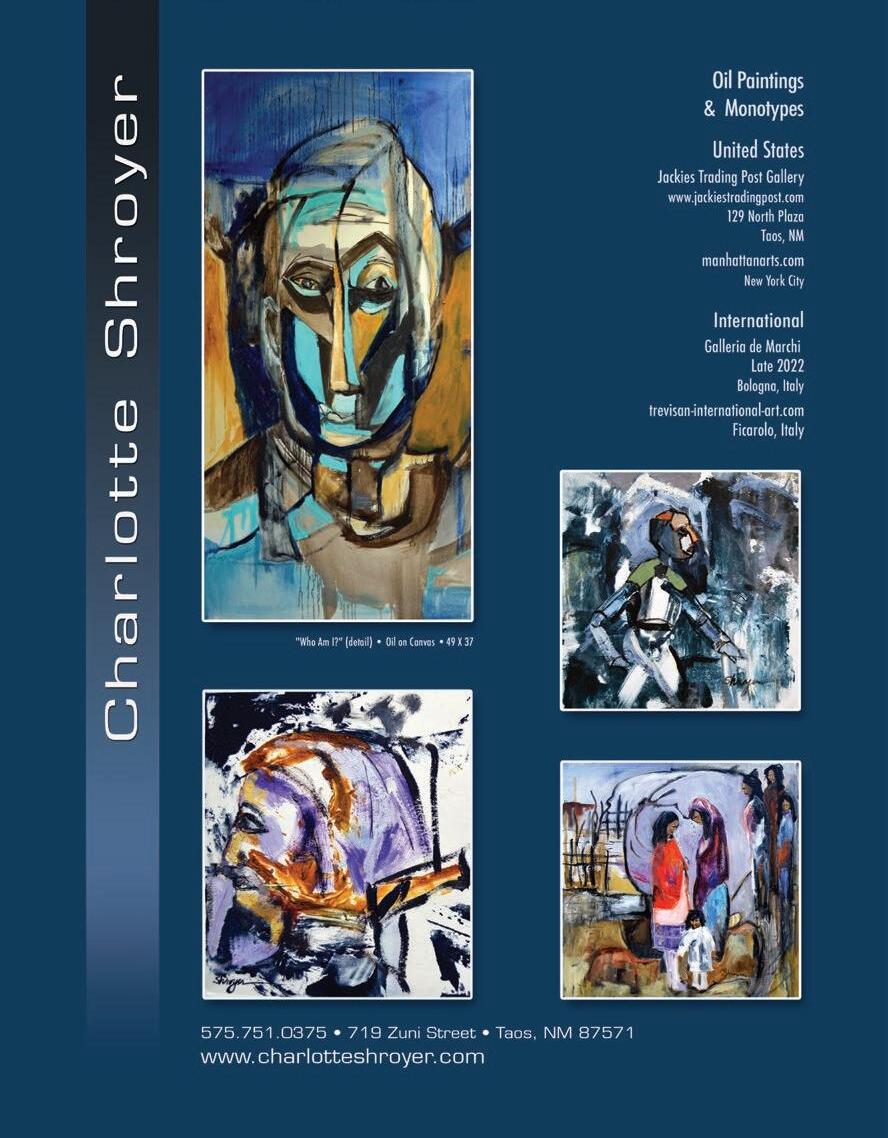
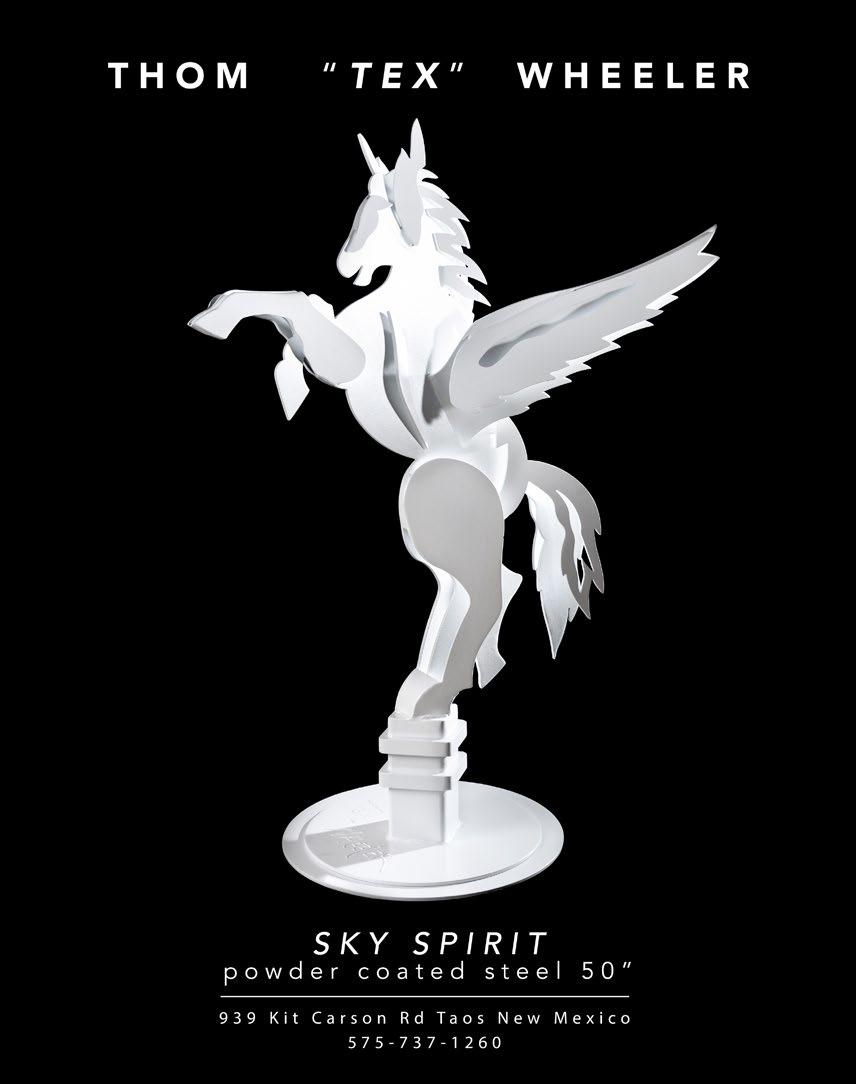
190
features
50 My New Mexico
A photographer is caught in the spell of the Old Southwest.
B y K evin Moloney
78 Worldly
In this picture suite, longtime New York Times photojournalist Lonnie Schlein takes you everywhere you ever wanted to go.
B y Su S an Spano
94 Nudes and Landscapes
A frequent Trend contributor contemplates and celebrates the female nude.
B y peter o gilvie
110 Another Day in Albuquerque
Photographer Eric Draper taps the city’s relaxed vibe, small-town feel, mingled traditions, and dash of the strange.
B y SiMon roMero
120 Life’s Work
A well-known gallerist and curator explores the work of Janet Russek and David Scheinbaum, the couple who helped to make photography a principal part of the Santa Fe art scene.
B y Stuart a . a ShMan
138 Audacity (What I Want to Say to Santa Fe)
Photographer Kate Russell observes the work of celebrated mixed-media artist Rose B. Simpson.
B y ro Se B. SiMp S on
150 Wanenmacher’s World Trend previews the deep, droll work of one of Santa Fe’s most spellbinding artists with photos by Kate Russell.

B y Cyndy tanner
160 Elusive Taos
A renowned photographer shares compelling words and pictures about a place few people really know.
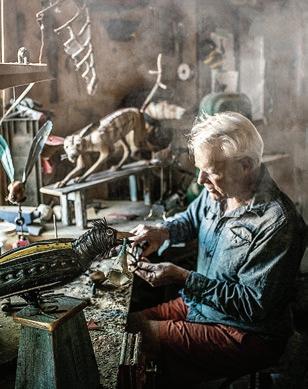
B y B ill Curry
170 Quartet
Photographer Audrey Derell and four area artists make beautiful music in the studio.
B y gu SS ie Fauntleroy
190 In the Garden
170
Miraculous art photos by Nancy Sutor and Lonnie Schlein grounded in the nurture and intimate observation of a wild and wonderful New Mexico garden.
B y l u C y r . lippard
30 TREND art + design + culture 2023
Artist Geoffrey Gorman in his studio, photographed by Audrey Derell. Top: Nancy Sutor, November 5, 2022 (with cactus flower and hawthorn) from the series, Second Nature.
Otter Medicine
Troy Sice, Zuni Pueblo


The elements of both Earth and Water are present in otter medicine, which is connected with the primal feminine energies of life in balance.
Otter teaches us to reawaken our inner child, to share and to express joy for others.
Become like otter and move gently and playfully through the river of life.
Since 1981 Fetishes Jewelry Pottery 227 Don Gaspar, Santa Fe Keshi.com 505.989.8728
Carved shed elk antler with silver whiskers and pen shell and lapis eyes. Otters range in size from 7” long x 5” tall to 3” tall by 1 1/4” wide.
By Janna Lopez
201 DESIGN SOURCE
206 Robert Reck and the Rise of Southwest Regional Architecture
A master photographer and an architectural historian help us understand how old adobe evolved into some of the most striking contemporary architecture in the West.
 By Elmo Baca
By Elmo Baca
225 PASSION OF THE PALATE
226 Off-the-Beaten Plate
Here’s something for people who’d like to eat their way around the Sangre de Cristo Mountains.
By Susan Spano
230 Chef Olea’s Legacy Grace, dedication, and passion prove to be his life’s secret ingredients.
By Vani Rangachar
Photography by Daniel Quat
239 Ever Evolving:
The Cuisine of New Mexico
Four dynamic restaurants prove that nothing ever stands still when it comes to food and fine dining in and around Santa Fe
By Esther Tseng
Photography by Peter Ogilvie
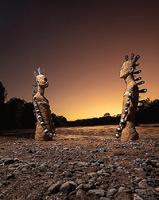
250 Of Farm Stands and Food Security
Sustainable food production begins with compost, education, and joy at Reunity Resources in Agua Fria Village.
By Susan Spano
252 AD INDEX
34 TREND TEAM/MASTHEAD 35 FROM THE EDITOR 36 FROM THE PHOTO EDITOR 37 FROM THE PUBLISHER 38 CONTRIBUTORS 40 ART MATTERS The Contemporary Side of Things The New Mexico Museum of Art moves from modern to contemporary at a new companion showcase, the Vladem By Kathryn M Davis 42 FILM Silver Bullet Productions A not-for-profit gives Native American filmmakers a voice and prepares them for careers in a booming New Mexico industry.
Robert Reck, Reimers residence (2011) in Montana, designed by Eddie Jones.
departments 206
ON
THE COVER:
Rose B. Simpson, River Girls (2019).
32 TREND art + design + culture 2023
photo By K ate ruSSell

PUBLISHER
Cynthia Marie Canyon
EDITOR-IN-CHIEF
Susan Spano
ART DIRECTOR
Janine Lehmann
PHOTO EDITOR
Lonnie Schlein
COPY CHIEF
Vani Rangachar
PRODUCTION MANAGER & ASSOCIATE DESIGNER
Jeanne Lambert
CREATIVE CONSULTANT & MARKETING DIRECTOR
Cyndy Tanner
PHOTO PRODUCTION
Boncratious
CONTRIBUTING WRITERS
Stuart A. Ashman, Elmo Baca, Bill Curry, Kathryn M Davis, Gussie Fauntleroy, Lucy R. Lippard, Janna Lopez, Kevin Moloney, Vani Rangachar, Simon Romero, Rose B. Simpson, Susan Spano, Cyndy Tanner, Esther Tseng
CONTRIBUTING PHOTOGRAPHERS
Bill Curry, Audrey Derell, Eric Draper, Kevin Moloney, Peter Ogilvie, Daniel Quat, Robert Reck, Janet Russek, Kate Russell, David Scheinbaum, Lonnie Schlein, Nancy Sutor
REGIONAL SALES DIRECTOR
Mara Leader, 505-470-6442
ACCOUNT REPRESENTATIVES
Duncan Walker, 505-470-6442
Jaira Stewart, 505-470-6442
Anya Sebastian, 505-470-6442
NORTH AMERICAN DISTRIBUTION
Disticor Magazine Distribution Services, disticor.com
NEW MEXICO DISTRIBUTION
Ezra Leyba, 505-690-7791
ACCOUNTING AND SUBSCRIPTIONS
Patricia Moore
SOCIAL MEDIA MARKETING
Janna Lopez
PRINTING
Publication Printers
Denver, Colorado
Manufactured in the United States
Copyright 2023 by Santa Fe Trend LLC
All rights reserved. No part of Trend may be reproduced in any form without prior written consent from the publisher. For reprint information, please call 505-470-6442 or email santafetrend@gmail.com. Trend art+design+culture ISSN 2161-4229 is published online throughout the year and in print annually (20,000 copies), distributed throughout New Mexico and the US. To subscribe, visit trendmagazineglobal com/subscribe-renew. To receive a copy of the current issue in the US, mail a check for $17.99 to P.O. Box 1951, Santa Fe, NM 87504-1951or go online to subscribe to the next issue at trendmagazineglobal.com/subscribe. Find us on Facebook at Trend art+design+culture magazine and Instagram @santafetrend

We’re seeking new and diverse voices! If you are a writer or photographer interested in contributing, please visit trendmagazineglobal.com/contribute and send your story pitches to santafetrend@gmail.com.
Trend, P.O. Box 1951, Santa Fe, NM 87504-1951 505-470-6442, trendmagazineglobal.com
34 TREND art + design + culture 2023
EDITOR
After living abroad—Paris, Beijing, Rome, Armenia, Rwanda, and Vietnam for 20 years, working as a travel writer, editor, and teacher—I landed almost by accident in Las Vegas, New Mexico, about 60 miles northeast of Santa Fe. Little Las Vegas, I say, to distinguish it from the other one. It’s among the towns on the eastern flank of the Sangre de Cristo Mountains that suffered so terribly from last year’s Calf Canyon/Hermits Peak fire, which scorched 341,471 acres of some of the state’s most beautiful northern territory.
I taught writing at New Mexico Highlands University for a while and tried to open an ice cream shop near the Vegas Plaza, but nothing stuck until Trend ’s wonderful new photo editor, Lonnie Schlein, brought me to the magazine. We’re both New York Times alums. I launched the “Frugal Traveler” column before moving to the Los Angeles Times

I’m still learning Santa Fe, its culture and art. I’m still learning the hugely idiosyncratic state of New Mexico. But I must say I was encouraged when Governor Michelle Lujan Grisham, in some of the most beautiful cowgirl boots I’ve ever seen, stopped in Las Vegas during a Fourth of July parade last summer to pet my dog. Izzie is a little black Lab born on a ranch up in Cleveland.
My mandate at Trend, given to me by our publisher and fearless leader Cynthia Canyon, has been to seek out great, new writers to go along with the breathtaking photography in this issue.
Well, we found them. I’m proud to have New York Times National Correspondent Simon Romero, well-known feminist art writer Lucy R. Lippard, Santa Fe curator extraordinaire Stuart A. Ashman, and Southwestern art and architecture specialist Elmo Baca adding their distinctive voices to Trend. At the same time, I’ve been gratified to get to know and work with frequent Trend contributors like Peter Ogilvie, Cyndy Tanner, and Gussie Fauntleroy, not to mention talented magazine staff members.
When you put these writers and photographers together, you get a feast. You take in one photo essay—say Nancy Sutor’s luminous garden images or Peter Ogilvie’s striking nudes—and then must try another. It could be Kevin Moloney’s photographic ode to New Mexico or Eric Draper’s edgy, action-packed pictures of Albuquerque’s people. And then you must try another, and another.
Every one of these photo essays has been assembled with editorial care and pleasure. That is to say, my pleasure. I hope you enjoy them as much as I do.
—Susan Spano
FROM THE
35 trendmagazineglobal.com
Photo by Lonnie Schlein
After 40 years working as a photojournalist—mostly at The New York Time s—you’d think that I’d be ready to call it quits and move to a life of total relaxation. NOT!

Part of what drives me to keep going—aside from the sheer joy of looking at great photographs— is the satisfaction of being a part of a talented team, with everyone working toward the same goal. It was like that when I was part of the editorial team that won a 2002 Pulitzer Prize for a special Times section, A Nation Challenged, which covered the September 11, 2001, terrorist attacks against the US. Later, the series was published as a book, crediting me as chief photo editor. It was a bestseller.
So, when publisher Cynthia Canyon, asked me to take on the prestigious position of photo editor for Trend magazine, I couldn’t say no. I wanted to be a part of a great team fulfilling a mission.
I certainly lucked out big time. What could be better for a photo editor than getting the chance to find multiple sensational photographers to shoot their own features, chiefly on New Mexico-related subjects. Each one would get a prodigious display of six to 12 pages. On top of that, Cynthia wanted me to contribute one of the photo essays. I could not imagine a more exciting assignment than working closely with them to produce stunning photo essays for an outstanding, elegant magazine.
My work for Trend is obviously now done. Working together with Cynthia, a woman of extraordinary vision, our very talented art director/designer Janine Lehmann, and our outstanding writer/editor Susan Spano (a New York Times alum) has been a very special experience for me. The magazine you’re holding in your hands reflects our various enterprises.
Throughout the process, I’ve so admired and have grown to like each and every one of the photographers represented in this issue. They are all professionals of the highest order, wonderfully talented and creative people: Peter Ogilvie, Robert Reck, Kate Russell, Audrey Derell, Eric Draper, Bill Curry, Kevin Moloney (who worked so very closely with me for years when I was the national photo editor of The Times), and the team of David Scheinbaum and Janet Russek (whom I’d known a lifetime ago and rediscovered working on Trend).
Through it all, I’ve made a bunch of round-trip driving excursions between the Dallas area and Santa Fe. And wow! I have grown to adore not only the state of New Mexico but also the city of Santa Fe. I now understand the extraordinary light of the area that so many photographers and artists have celebrated. No place in the United States bears any resemblance to this enchanting and beautiful world. There’s a great deal more learning ahead for me, but I am well on the way to a more complete understanding of what this place is really about.
Despite my total immersion in my work for Trend, I continue to be a political animal and news guy, preoccupied with the state of our world. Just as COVID-19 seemed to be winding down, Putin launched his outrageous genocide against the Ukrainian people. Tensions are growing between the US and China, and humanity’s pollution of our planet continues unabated. Fake news continues to spew forth its utter nonsense on social media, with Fox News leading the charge with anchors misleading the public about the results of the 2020 election, putting our democracy in jeopardy.
But truth matters! We still have a free press and some terrific magazines to peruse, like Trend. The magazine, which reflects the continued vibrancy of American art and culture, has more than survived through the most challenging of times for the print media. Many similar ventures throughout the country, especially in “artsy” towns, have closed shop. Next year Trend will celebrate its 25th anniversary and that’s quite an accomplishment. If you love art, design, and culture, Trend is certainly the place to go.
Cynthia has always believed in the value of print, and I agree. Although the magazine has an attractive website, it’s a pure delight to hold Trend in one’s hands, appreciating the very feel of it, the perceptible smell that comes from a stylishly produced journal. Even the ads—most of them from galleries and museums throughout the area—are a pleasure to look at.
So, my advice is simple: Get your hands on a copy of Trend and enjoy the pleasures contained therein.
Lonnie Schlein
FROM THE PHOTO EDITOR
36 TREND art + design + culture 2023
Lonnie Schlein in South Korea in November 2022 (photo by Oren Schlein).
In the last few years, I’ve been thinking a lot about legacy and what that means for me now that my son has grown and gone off to college.
I spent the last quarter of a century envisioning and creating a magazine that matters for my community. For me this meant learning about integrity in publishing, so crucial as the media evolves in these turbulent and confusing times.
Often it was against all odds that I learned how to publish in print, providing a level of excellence and beauty that few magazines can meet today. I never anticipated that print prices would double in 2022/23, forcing many magazines out of business. But tenacity and creativity have kept Trend going, regardless of the challenges.
This is a very special issue, as you will see, because I reached out to a photo editor, Lonnie Schlein, whose New York Times experience and expertise blew my mind. He, in turn, found longtime editor-writer, Susan Spano, who lives in Las Vegas, New Mexico, not far from Santa Fe. Their worldly perspective has taken Trend down new paths that you will appreciate in this issue.
I started on a life path in the arts through photography when I was in college. I had a very special photography teacher at Santa Monica City College near Los Angeles who had spent a lot of time taking pictures in Vietnam. He taught me how to feel, how to know from within what I was shooting, making it my own art. My final project for the class focused on laser light, which I shot at L.A.’s Griffith Observatory planetarium, replicating the look of nebulas and sacred geometrical shapes. I made it into a slideshow synced to the soundtrack of Stanley Kubrick’s 2001: A Space Odyssey. Patterns in science and nature have always moved me, as reflected in Trend magazine. I never imagined that the path I chose all those years ago would take me here publishing one of the best reads and magazines in the country in print, with Trend thriving, each issue better than ever.
— Cynthia Marie Canyon

Next year I will be celebrating 25 years in print with Trend. The 2024 issue will mark the occasion by reflecting back on the best stories we have published over the last 25 years. It will run more than 400 pages and be offered as a hardbound book. Looking back and celebrating the art+design+culture that is our legacy is as important as the work we do to find brand-new Trends to reflect each year.

To order a special first-print, hardbound copy of our June 2024 25th anniversary issue, and have it mailed to your home in the US, please send a check to Trend for $250.00 to P.O. Box 1951, Santa Fe, NM 87504.
LA MESA OF SANTA FE

FROM THE PUBLISHER
225 Canyon Road • Santa Fe NM 505-984-1688 • lamesaofsantafe.com
Christopher Thomson outdoor sculptures
Photo by Lonnie Schlein
37 trendmagazineglobal.com





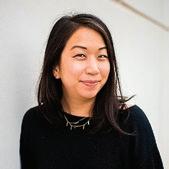



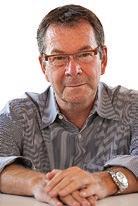

CONTR IB UTORS
38 TREND art + design + culture 2023
Top, from left: Lucy R. Lippard (photo by Lonnie Schlein); Esther Tseng (photo by Linda Nguyen); Stuart A. Ashman (photo by Lonnie Schlein). Middle, from left: Simon Romero (photo by Eric Draper); Cyndy Tanner (photo by Kate Russell); Rose B. Simpson (photo by Kate Russell). Bottom, clockwise from left: Peter Ogilvie (photo by Bill Stengel); Vani Rangachar (photo by Barry Stavro); Audrey Derell (photo by Audrey Derell); Elmo Baca (photo by Lonnie Schlein); Kate Russell (photo by Kate Russell).
Stuart A. Ashman has long been part of the New Mexico arts scene as a photographer, museum director, and curator. He has coauthored books, like Abstract Art and Photography New Mexico, and was appointed Cabinet Secretary of the New Mexico Department of Cultural Affairs in 2003. He grew up in Matanzas, Cuba, forging a lifelong interest in the Caribbean nation and its art. Last year he and his wife, Peggy, opened Artes de Cuba, a gallery on Lena Street in Santa Fe.
New Mexico-born Elmo Baca is a historic preservationist and author; his books include Rio Grande High Style and Santa Fe Design. He has served as program associate for New Mexico MainStreet, an organization that works to preserve historic townscapes throughout the state. In his hometown of Las Vegas, he restored a landmark 19th-century building near the plaza as a 50-seat, first-run movie theater. He is chairman of the Las Vegas New Mexico Community Foundation.
Audrey Derell’s lifelong journey in the arts began as a child in Finland. She lived and studied performing and visual arts in the Philippines, Belgium, France, Spain, and finally New Mexico. After a 20-year career in dance arts, Audrey transitioned into photography. Twelve years ago a pollenladen bee in the heart of a desert bloom captivated her mind and heart. Derell specializes in macro-botanical studies and dance imagery, and she enjoys meeting the fascinating artists whose portraits and oeuvre she captures for Trend magazine.
Lucy R. Lippard is a writer, activist, sometime curator, and author of 25 books on contemporary art activism, feminism, place, photography, and archaeology, most recently Undermining: A Wild Ride Through Land Use, Politics and Art in the Changing West, and Pueblo Chico; Land and Lives in the Village of Galisteo Since 1814. She is cofounder of several activist and feminist organizations, and lives off
the grid in Galisteo, New Mexico, where she has edited the monthly community newsletter for 26 years.
Raised in Southern California, Peter Ogilvie studied Art and Architecture at University of California at Berkeley, then pursued documentary filmmaking, and finally still photography, both fine art and fashion. “My passion for photography grew out of my love of looking at images,” he says. “Since I was a child, magazines and books full of pictures were magic worlds for me. I love capturing and creating those moments of the absurd and the divine that tell us the stories of who we are.”
Vani Rangachar, a longtime journalist, has written and edited many articles for leading US newspapers and publications on two coasts. She was deputy travel editor at the Los Angeles Times and most recently served as senior digital editor for Westways and AAA Explorer, magazines published for members of AAA. She serves on the board of directors for the Society of American Travel Writers (SATW) Foundation.
Simon Romero, born and raised in New Mexico, is a national correspondent for The New York Times, covering the Southwest. Based in Albuquerque, he travels widely to bring stories alive with on-the-ground reporting on issues, including energy politics, Indigenous sovereignty, the US-Mexico border, immigration, and climate change. Before joining The Times, he worked at Bloomberg News in Brazil, where he opened the news agency’s bureaus in Brasília and Rio de Janeiro. He is a recipient of the Maria Moors Cabot Prize for reporting on Latin America and the Caribbean, and the Robert Spiers Benjamin Award for best reporting in any medium in Latin America.
Kate Russell is a photographer based in Santa Fe, New Mexico. The subjects she
has covered are as varied as her background and include action, architecture, art, circus, fashion, food, friends, life, and travel. Kate also worked with New Mexico’s Meow Wolf as an artist, collaborator, photographer, and director of photography. Her photos define the Meow Wolf brand. Her work has been featured in Art Forum, New Mexico Magazine, Rolling Stone, The New York Times, and many others.
Rose B. Simpson is a mixed-media artist who lives and works in her ancestral homelands of the Santa Clara Pueblo, about 25 miles north of Santa Fe. She has degrees in art and creative writing from the Institute of American Indian Arts and in ceramics from the Rhode Island School of Design. Her work is held by the Denver Art Museum and New York’s Guggenheim Museum and has been exhibited at a host of museums and galleries, including Mass MoCA, the University of South Carolina School of Art and Design Museum, and the Wheelwright Museum of the American Indian in Santa Fe.
Cyndy Tanner is a Santa Fe-based freelance writer and co-owner of Parasol Productions, an events and photo styling company. Visual and verbal branding, book projects, and social media campaigns for clients keep her busy. Road trips, thrift stores, and mostly successful baking endeavors keep her happy.
Esther Tseng is a food, drinks, and culture writer based in Los Angeles, as well as a judge for the James Beard Foundation awards. Her work has appeared in The New York Times, Los Angeles Times, Bon Appétit, Food & Wine, and more. When not dining out, she enjoys snowboarding, Pilates, bike packing, and tending to her plot and leadership duties at her community garden. To unwind, she loves spending time at home with a book or streaming television accompanied by her cat, Chester. R
39 trendmagazineglobal.com
BY KATHRYN M DAVIS

At its inception, the New Mexico Museum of Art was a contemporary museum. Opened on the historic Santa Fe Plaza in 1917— long before such distinctions as “modern” and “contemporary” had specific meaning in the art world—the museum was intended to exhibit works by the new colony of artists living and working along Canyon Road.
More than 100 years later, a new moment in New Mexico’s artistic evolution is on the horizon and it has a new showcase. Slated for its grand opening in the summer of 2023, the Vladem Contemporary will focus on the contemporary side of New Mexico art. Dated roughly from the 1970s to the present, contemporary American art is distinguished by theorists from Modernism, which is typically seen as lasting from the mid-20th century to the 1960s and 1970s. By the 1980s, the art world was a different place, and the Vladem will reflect that.
Executive Director Mark White says that the New Mexico Museum of Art will
The Contemporary Side of Things
The New Mexico Museum of Art moves to include contemporary art in its focus by opening a new showcase at the super-cool Santa Fe Railyard

remain a singular institution, with dual campuses: the historic plaza site and the Vladem in the Railyard. Although each location’s exhibitions may be different visually, these paired establishments present a continuum of New Mexico’s significant trajectory within the history of American art.
The inaugural exhibition at the Vladem’s Railyard site will further that continuum. Shadow and Light focuses on New Mexico’s indefinable yet incredible light, which has attracted “artists and photographers to the region for decades,” as the museum’s assistant curator Katie Doyle says in her exhibition prospectus. She has selected artworks by such luminaries as Larry Bell and Ron Cooper of the Light and Space movement, renowned Earthworks artist Nancy Holt, installation superstar Yayoi Kusama, and Agnes Martin, whose deliberately quiet paintings are said to pulse with meaning.
Susan York is creating a graphite piece to be installed for the exhibition. Doyle has also chosen one of James Drake’s
most stunning video pieces, Tongue-Cut Sparrow. The exhibition will feature the striking Indigenous futurism of Cochiti Pueblo’s Virgil Ortiz, feminist icons Judy Chicago and Harmony Hammond, and self-described “culture witch” Erika Wanenmacher. In all, more than two dozen artists have been selected for this inaugural exhibition.
Designed by the architectural firm DNCA + Studio GP of Albuquerque and Santa Fe, the Vladem complex offers exhibition, storage, and education spaces, as well as a gift store on the Railyard side of Guadalupe Street. The new museum is named after Ellen and Robert Vladem, who made the lead contribution in a recent private-public fundraising campaign. (Steps from the Vladem, the Santa Fe Depot, the northernmost terminus for the Rail Runner commuter line, is receiving a facelift.)
A second entrance to the Vladem on Montezuma Street provides access to the spacious classrooms. Shadow and Light premieres in Gallery One on the
ART MATTERS
40 TREND art + design + culture 2023
Top, from left: Yayoi Kusama, Pumpkin, 2015 (courtesy of the Tia Foundation); Angela Ellsworth, Pantaloncini Double Untitled, 2019 (courtesy of the artist and Modern West Fine Art).
first floor, with nearly 5,000 square feet of exhibition space. Upstairs, Gallery Two comprises some 4,000 square feet of raw exposition space. An artist-inresidence area and 4,100 square feet of open storage allow visitors a perspective of the backstage functions of a contemporary museum.
With plenty of valuable wall space— not only necessary for exhibitions but also to keep the natural light from harming artworks on display—there is an abundance of our state’s celebrated light saturating the museum. Windows are thoughtfully situated, as are scrims.
And speaking of windows, the public will be able to see several of the Vladem’s ongoing installations during nonbusiness hours. The Windowbox Project on the northern side of the complex consists of an eight-foot-byeight-foot storefront window. Analogous to the Museum of Art’s previous—and well-attended—alcove shows, the Windowbox Project is designed to showcase regional artists, who will display their work quarterly. The museum is partnering with community-based Vital Spaces for the first year of window exhibitions.
Artists Cristina González and Morgan Barnard are scheduled for 2023.
A video window faces Guadalupe Street. The mural by Gilberto Guzmán that was on that side of the Halpin State Archives Building (formerly the Charles Ilfeld Company Warehouse) is to be permanently re-created by the artist inside the museum. Finally, always accessible to those who approach from the Railyard will be a light sculpture in the breezeway above the gift shop and the south entrance. At press time, artist Leo Villareal was completing the site-specific piece.
Together, the dual campuses of the Museum of Art will elevate the place of New Mexico in the narrative of American art. Santa Fe has long drawn visitors and residents, artists and their audiences alike. The Vladem will solidify New Mexico’s place in the art of today and our multicultural past as we look forward to an inclusive future. R
Hat Ranch Gallery is the most refreshing approach to acquiring art we have ever experienced Drive out to the beauty of the high desert, enter a home and learn about the artists, their methods and their subjects Don't miss the Hat Ranch Gallery ~ Marlene Elliot (Chicago , IL )


The most amazing experience we've ever had at a gallery The selection is wonderful and the customer service is over the top A MUST SEE when you're in Santa Fe
~ Sheri Autrey (Dallas , TX )
Hours: Thurs–Sun, 11 – 5 | 27 San Marcos Road W, Santa Fe, NM 505-424-3391 | hatranchgallery org | IG & FB @ hatranchgallery Private groups and appointments welcome
trendmagazineglobal.com 41
DANIEL QUAT PHOTOGRAPHY
S I LVER BULLET PRODUCTIONS
A not-for-profit gives Native American filmmakers a voice and prepares them for careers in a booming New Mexico industry
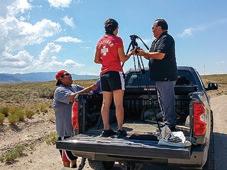
Native American sovereignty is a concept with deep individual and cultural significance. It entails autonomy, liberation, and recognition. Sovereignty for children, teachers, elders, tribal leaders, and community members is at the heart of Silver Bullet Productions, a not-for-profit educational film company.
For nearly 20 years, volunteer board members, tribal advisors, and unpaid staff from Silver Bullet Productions have worked alongside individuals from 20 of New Mexico’s Native American communities, teaching the art of storytelling through filmmaking. More than 55 documentaries have been completed, some nationally recognized and aired on PBS.

However Wide the Sky: Places of Powe r, which won a regional Emmy Award, explores the history and spirituality of Indigenous people and places of the American Southwest. It was directed by David Aubrey and written by Conroy Chino and Maura Dhu Studi. According to Silver Bullet, “The film transports viewers to Chaco Canyon, Bears Ears, Zuni Salt Lake, Mount Taylor, Santa Ana Pueblo, Taos Blue Lake, Mesa Prieta, and Santa Fe, and is narrated by Indigenous actress Tantoo Cardinal.”
Such Silver Bullet films are partnerships with Native American communities, creating invaluable
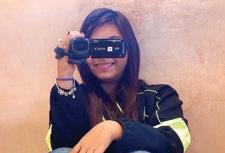 BY JANNA LOPEZ
BY JANNA LOPEZ
connections across generations. They share the uniqueness of each pueblo’s language, history, culture, and traditions, serving as archives of sovereign representation and truth.
The filmmaking is collaborative, taking as long as a year to complete, unifying leaders, teachers, elders, and children in the process. “Together, we decide the stories the community wants to explore and share,” says Pam Pierce, a lawyer, former teacher and charter school director, and cofounder of Silver Bullet Productions. “The intention is to preserve the voices of each tribe’s elders, illuminate a depth of heritage most people don’t know, and braid together unique languages, art, the beauty of the land, and teachings.”
Once a connection has been made between a community and Silver Bullet Productions, conversations about film projects begin, with students, teachers, and tribal leaders involved the entire time. Participants are asked: What question do you want your film to answer? Which stories do you want to tell? How will you approach historical complexities? And how will you best honor your culture?
Silver Bullet Productions provides the equipment and hands-on learning which give students professional career skills and opportunities for expression. They also get access to industry stars like Wes Studi, Maura Dhu Studi, Chris Eyre, and many other Native American film directors, producers, actors, and screenwriters.
FILM
42 TREND art + design + culture 2023
Silver Bullet Productions offers students from Indigenous communities yearlong educational and creative filmmaking opportunities. Equipment and professional industry guidance support communitywide project collaboration (photos courtesy of Silver Bullet Productions).
Film professionals commit to mentoring each community’s new filmmakers for a year.
“Silver Bullet Productions uses filmmaking to educate and spark discussion about culture and place,” director Eyre says. “Their teaching and documentaries help to grow Native American filmmaking and provide an avenue for authentic Native voices and storytelling.”
Adding to the authenticity are each project’s unpaid cultural advisors. Matthew Martinez, PhD, has been a board member and film project advisor for 12 years. He is a member of the Ohkay Owingeh tribe, a former New Mexico lieutenant governor, and past director at the Museum of Indian Arts and Culture.
“Advisors are a critical piece to our projects,” Martinez says. “We rely on community educators, scholars, and tribal leaders to provide input in the development process of our documentaries. Advisors are key to helping set up site locations and identifying graphics, music, and other voices that help convey a narrative.” With great sensitivity, they guide the themes of
documentaries, which include such topics as the inherent power of Indigenous women, the warrior in past and modern times, tribal leadership, and sovereignty. “Silver Bullet Productions will not include footage or recordings that cross cultural boundaries or may be perceived as questionable,” Martinez says.


Looking ahead, Silver Bullet Productions plans to raise awareness and needed funds to engage smaller, more rural communities in educational, student-centric, collaborative films across New Mexico. Each project includes classroom discussion guides related to culture and thoughtful representation. Workshops are immersive and include panel discussions in which the whole community participates.
Silver Bullet Productions wants to guide a rapidly accelerating New Mexico film industry in a way that is inclusive and honors and sustains Indigenous cultures. Its mandate is to give the power of voice to Native American people so that they can tell their own stories in ways that protect and preserve their sacred cultures and lands. R


tierramargallery.com 225 Canyon Rd, Santa Fe, NM 505.372.7087 JARRETT WEST SCULPTURES 43 trendmagazineglobal.com
Director Chris Eyre, actor Zahn Tokiya-ku McClarnon, and Pueblo of Zuni Tribal Council members attend Silver Bullet Productions annual fundraiser (photos by Janna Lopez).





COMING SOON Autumn 2023 $449,900 - $489,900 STUDIOS AT PARKWAY studiosatparkway.com 1189 Parkway Drive palosantodesigns.com 505-988-7230 Giorgetti Real Estate Leslie Giorgetti Owner / Broker 505-670-7578 Commercial Condos, 1490 sf, Rufina and Siler FOR SALE OR LEASE DISTINCTIVE SPACES FOR WORK AND PLAY in Santa Fe’s Creative Center & Opportunity Zone






 Trevor Mikula
Travis Bruce Black
Trevor Mikula
Travis Bruce Black
New Brow Contemporary Art 125 Lincoln Avenue Santa Fe, NM www.popsantafe.com 505.820.0788
Judy Shreve
SAMUEL DESIGN GROUP

LIVABLE. MODERN. LUXURY
WENDY MCEAHERN (3) 46 TREND art + design + culture 2023

ADVERTISEMENT 47 trendmagazineglobal.com
Stunningly seamless integration of space, light, and heart is a trademark differentiator of designer Lisa Samuel. Her company is founded on this premise. At its core, integration is an aim for inhabited spaces to elevate our life experiences. Samuel, president of Samuel Design Group in Santa Fe, utilizes credentials in design, architecture, and construction to extend imagination into internationally award-winning design projects; projects that promote life-enhancing power.

Samuel is proud to introduce the talents of Clayton Brandt, architect and interior designer, as her partner.
The Samuel team shares this express belief: “The design of spaces we occupy can have profound ‘life-enhancing’ power when the project is approached from a reverent heart space where everyone involved in the project is treated with kindness and respect.” This factor is essential to the collective philosophy of Samuel Design Group.
48 TREND art + design + culture 2023
Designing interiors and exteriors of homes is where Samuel believes the environment can truly be seen, felt, and expressed. She says, “Our home environment is, and has been, the foundation for a healthy life. The aesthetic beauty can positively enhance our living and supply us with a foundation for health. One’s home should be a space that encourages the best version of yourself. Even the most beautifully appointed room is truly empty unless the intrinsic energy and personal meaning is graciously curated.”
Samuel believes that healthy business environments are equally essential. Commercial lighting and interior design projects integrate every passionate detail for luxury hotels, resorts, galleries, and restaurants. Samuel shares, “Design expresses everything a business values: your products, employees, culture, and your customers. We can turn any room into a statement piece to convey the unique heart of your
brand. Fabrics, furnishings, and finishes are selected to express your business’s unique identity. Every element has a purpose related to your company’s essence.”
Design of aesthetically nourishing environments has earned Samuel the highest accolades. Samuel has won local, national, and international awards, including the prestigious International Property Award for Best Interior Design of a Private Residence, “Best of Houzz” for Design, and Customer Satisfaction by Houzz, the leading platform for home remodeling and design.
Samuel concludes by sharing, “When does a house become a home? When does any space envelop you and make you feel good? Is it designed to soothe? Many say that a house is made by hands but a home is made by the heart. In my experience, a space can only become a home when the owners’ personality and heart have been considered in each and every element I design.”

49 trendmagazineglobal.com Santa Fe | 505-820-0239 | samueldesigngroup.com
ADVERTISEMENT
My New Mexico
A photographer digs deep into his archives for images that stir memories of a place he can’t forge t BY
KEVIN MOLONEY
In late January 1998 I stood enchanted, photographing the setting sun’s glow on the modest, weather-beaten monument atop the ruin mounds of San Gabriel de Yunque-Ouinge. That year marked an important anniversary; it had been 400 years since more than a dozen of my soldier-colonist ancestors and their families took over the homes of the Tewa people who lived in this small pueblo. It crouches just across the Río Grande from Ohkay Owingeh, called San Juan de los Caballeros by the Spanish who arrived there in 1598. Throughout that anniversary year I photographed one site after another where my family disrupted the Indigenous world with war, taxation, and disease until they fused with it through intermarriage and collective struggle.
My family is a mix of wanderers, explorers, and refugees who all found themselves in what was long the most remote outpost in North America of any government that claimed it. With names like Márquez, Pérez de Bustillo, Robledo, and Baca, they pushed in with Spanish conquistador Juan de Oñate, became Mexican citizens in 1821, and then Americans in 1848. Their children married into wandering, exploring, refugee Irish and German families. My greatgreat grandfathers founded San Luis, the oldest town in Colorado. To them the state line was just a bureaucratic imposition across which culture and family flowed as unimpeded as the waters of the Río Grande. When I am asked where I am from, I reply that I was born in Colorado. But really, because of my long, deep roots here, I am of New Mexico.
To be of New Mexico is to have a very long memory. Those memories come from a heart swelling with pride or sometimes a stomach knotted with grudge. Like most things in a desert, they last forever. If, as photographer Minor White once wrote, all photo -
graphs are ultimately self-portraits, my New Mexico images are memories that connect my lifetime to a cascade of others—they inhabit my bones. To be of New Mexico is to know that anything that happened in the last 200 years, even the invention of photography, is recent news.
To be of New Mexico is to know that architecture is inhabited by the land rather than simply built atop it. Whether it is the 1,000-year-old Taos Pueblo, Santa Fe’s cherished 1610 chapel of San Miguel, or Mexican modernist Ricardo Legorreta’s Santa Fe Art Institute, valued structures here fuse with the landscape so fundamentally that they could only be replicated soullessly elsewhere. In other cities glass towers and particle-board tract houses sit temporarily atop the ground, waiting to be scraped off by environmental or developmental disasters. To be of New Mexico means that no matter where you live, you long for a home that is cradled by the land.
To be of New Mexico is to have a religion, no matter what that might be. Among those soldier-colonists of 1598 were zealous treasure seekers, dogmatic conquerors, pilgrim refugees of European caste systems, secretive crypto-Jews fleeing the Inquisition, and a handful of Franciscan friars hoping to convert by charm or force the Indigenous people who, despite those efforts, held onto important traditions. From those friars and the self-punishing Penitentes they inspired to ashrams, Sikh enclaves, and Latino Pentecostals, mystical religions abound here. Many of us also find belief and meaning outside established religion, as I have in the vocation of journalism or the priesthood of teaching.
My father, who had the heart and imagination of a mystic, carried that fervor to his own work as a photojournalist and a teacher. His love of land, image, and ritual attracted me irresistibly while I traveled
50 TREND art + design + culture 2023

51 trendmagazineglobal.com
A cross-carrying pilgrim wears a Virgin de Guadalupe rosary enroute to the Santuario de Chimayó in Northern New Mexico on Good Friday. Thousands make a pilgrimage to the 200-year-old shrine every Easter.

52 TREND art + design + culture 2023
The iconic 1878 spiral staircase at the Loretto Chapel in Santa Fe offered elegant access to the choir loft 22 feet above.
with him as a child, making pictures of New Mexico and the West. No matter the mythology or mode, to be of New Mexico is to believe in something passionately and selfsacrificially.


To be of New Mexico is also to understand that eventually your culture will be changed by collision or conflict with another. From prehistoric Clovis people to Ancestral Puebloans, Navajo, Pueblo, and Apache, Indigenous people have arrived, colonized, created, and dissipated here for millennia. They conflicted with ever-larger bands of Europeans, from Spaniards in 1598 and 1692 to blue-coated American soldiers in 1846.
Those soldiers opened routes to St. Louis on the far Mississippi River that my merchant great-great grandfather Dario Gallegos traveled. As a young man he joined the Santa Fe Trail trade and made commercial connections on the other side of the Plains that he later used to stock a mercantile store—still in business—in San Luis. Those wagon
A caretaker sweeps the nave at the Santuario de Chimayó, a revered Catholic pilgrimage site near the Santa Cruz River about 25 miles north of Santa Fe.
Right: George Chavez scrapes wax from the candleholders at the church built by his family. He died in 1989.
53 trendmagazineglobal.com

54 TREND art + design + culture 2023
A full moon rises over the 400-year-old plaza in Santa Fe and its distinctive and controversial Soldiers Monument obelisk.

55 trendmagazineglobal.com
Fragments, shadow art by Kumi Yamashita, at the New Mexico History Museum in Santa Fe.


56 TREND art + design + culture 2023
Tourists at the Oñate Center in Alcade, New Mexico, with a statue of the Juan de Oñate. Its foot was sawed off to protest atrocities against Indigenous people committed by the Spanish. Top: Ohkay Owingeh Puebloans watch a 1998 parade celebrating the 400th anniversary of the 1598 Spanish invasion.



57 trendmagazineglobal.com
Clockwise, from top: Artist Golda Blaise Pickett works on a piece during an art throwdown at Meow Wolf, a Santa Fe center for immersive, interactive art; cinnamon rolls are loaded into a wood-fired horno oven at the historic Acoma Pueblo; acclaimed chef Martin Rios (center) puts the finishing touches on a dish in the kitchen of Restaurant Martin in Santa Fe.

58 TREND art + design + culture 2023

59 trendmagazineglobal.com
An Apache woman walks the ruins at Gran Quivira, part of the Salinas Pueblo Missions National Monument in central New Mexico. By 1678, the once-thriving Native American community was abandoned due to Spanish hostility, epidemics, and Apache raids.


60 TREND art + design + culture 2023
Young Native Americans stretch before sprinting up a desert hill near the Navajo Nation town of Shiprock, New Mexico. Top: An Acoma man at the Mission of San Estevan del Rey on the Acoma Pueblo, which sits atop a 400-foot-tall New Mexico mesa. The pueblo was leveled by Spanish troops in 1598.
trains, then the Santa Fe Railroad and Route 66, brought rare goods, new ideas, and eventually artists and writers seeking distant inspiration. They changed Taos, Abiquiu, and Santa Fe in their wake. To be of New Mexico is to know that more collisions will come, and that Santa Fe will again and again become a “city different.”
To be of New Mexico is to savor each meal as if it is your last. The high desert surrenders little surplus. Until the railroads changed the economics of supply, privation or starvation were only a dry or freezing season away. Here food is celebration, food is art, food is love. Traditional local dishes abound in the terroir of difficulty: earthy, complex, sharp, piquant, and bitter. My Nana’s Depression-era recipe for posole—our Christmas Eve staple still—embodies all of this through only six ingredients: dry hominy and red chiles from Fernandez Chile Company in Alamosa, garlic, oregano, salt, and a lamb or mutton shank simmered atop a stove all day. When local dishes are sweet—natillas, atoles, buñuelos—that sweetness is subtle, as if it is hard-won, and travels in the company of bitterness from cinnamon or anise. To be of New Mexico is to know that your food tells a fraught, complex story.
And yet anyone who considers themselves of a place would argue all these same things. The 1863 bricks of my current home in Indiana were kilned on site from local clay
and its foundation stones were cut from the bedrock strata below. The river that winds past is a stream of long history, change, and conflict. People here are as passionate in their beliefs as my New Mexican family is.
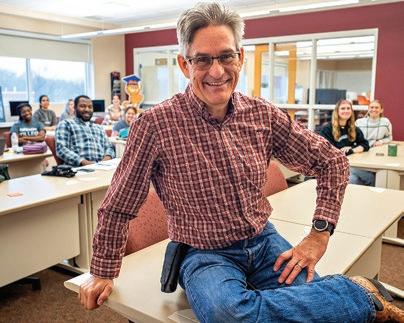
Why, then, is New Mexico different? If you are reading this in Albuquerque, Santa Fe, Abiquiu, Las Cruces, or even across that random and imperceptible bureaucratic line in San Luis, you know that it looks, breathes, and feels different. The air and sun feel as unique as a cool summer evening and as memorable as the incense of a piñon fire. It sneaks up on you like the warm, delicately acrid palate glow of good red chile.
As I write this, I search for the word that describes how New Mexicans, whether transplants or natives, feel about this place. In my photographs I see it in the sharp light of the Jornada del Muerto, the warm colors on the walls of Laguna Pueblo, the open skies above the ruins at Salinas, the dark and miraculous nave at Chimayó, and the ghosts of hundreds of generations who called this home. Is it complexity? Contradiction? Continuity? Many other places can argue the same.
I keep returning to a description of this place coined in 1906 by journalist Lilian Whiting. After a bit of nostalgic, familial, heart-filling consideration, I argue it all comes down to this: To be of New Mexico is to be enchanted. R
 Kevin Moloney, longtime photojournalist for The New York Times, now teaches media design and development at Ball State University in Muncie, Indiana (photo by Sami Hensley).
Left: Casilda Salazar Moloney, “Nana,” on Christmas Day 1959 (photo by Paul F. Moloney).
Kevin Moloney, longtime photojournalist for The New York Times, now teaches media design and development at Ball State University in Muncie, Indiana (photo by Sami Hensley).
Left: Casilda Salazar Moloney, “Nana,” on Christmas Day 1959 (photo by Paul F. Moloney).
61 trendmagazineglobal.com


Changing Woman Between Worlds, Virginia Maria Romero, acrylic on
canvas, 48” x 60”
613 Canyon Road Santa Fe, NM 87501 billhester@billhesterfineart.com
Portrait of David Bowie, James Paul Brown, mixed media on paper, 44” x 30”


Eternal Portals, Susanna Hester, oil on canvas, 18”
A Magical Place Bill Hester Fine Art BillHesterFineArt.com (505) 660-5966 Red Fat Happy, Barrett DeBusk, 4’ and 5’ and 28” tall, powder coated steel
x 24”
YENNY COCQ SCULPTURE



The love that lifelong artist Yenny Cocq pours into her creations has touched collectors all over the world. Through bronze sculptures and stunning elegant jewelry, Yenny expresses ever-evolving connections to family through love. She shares, “Love forms my creations—from my heart through my hands and work—to the embodiment of my sculpture.” Yenny has been internationally recognized for her pieces and has a huge fan base in Europe, where she once had a gallery in Copenhagen. Today, Santa Fe is her home. Yenny states, “It’s important to be connected to my local customers and community. People are always invited and encouraged to visit my Santa Fe studio.” Over the years her work has morphed and as she notes, “Although it’s become larger and wider, the essence of family connections remains the same. It begins with a single figure and then, as times change and relationships grow, perhaps the individual piece gets coupled, or a pet is added, or perhaps children. My work is meant to reflect the nature of people’s families and love.”
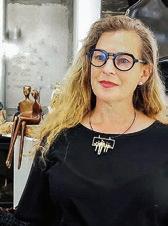
64 TREND art + design + culture 2023
yennycocqsculpture.com | 131 County Road 84, Santa Fe, NM | 505-670-6053
ADVERTISEMENT
In the studio male bronze before patina, 56”; The Two of Us, life-size bronze sculpture couple for outdoors, 56”; The Two of Us, bronze in private collection, 56” TOP THREE PHOTOS: YENNY COCQ; BOTTOM RIGHT PHOTO: KRISTINA KORSHOLM
Tim Wiford’s passion for art, enthusiasm for starting companies, and love for selling inspired the creation of the Wiford Gallery. Everything came together as an experiment to test an economic model based on giving expression to meaningful service; in this case giving heart, mind, soul, and strength to the placement of beauty in the world. “I have always believed that art is an emissary to a better world,” he says.
The formula has succeeded because the Canyon Road gallery, founded more than 20 years ago, is still strong today. The artists represented—currently there are five—have all done something of extraordinary value that sets them apart in the art world.
More than 40 years ago, Lyman Whitaker was the originator of Wind Sculptures™ and Wind Forests™, and is probably the most prominent kinetic artist in the world today. Tim Church has created his own genre called vibrant toning on copper. Trained as a scientist and researcher, he has devoted nearly 20 years of time and effort into researching his unique artistic process, working with acids, bases, and temperatures pushing materials to their limits, creating beautiful art from science. Jeremiah Welsh is the finest low-relief sculptor of his generation and can work in any format, style, or size. Rod Hubble is an exceptional painter who has mastered his genre and inspired people for more than 50 years. Finally, Ryan Steffen’s atmospheric stone sculpture infinity fountains contribute beauty and context to any space, inside or outside.

65 trendmagazineglobal.com WIFORD GALLERY wifordgallery.com | 403 Canyon Road, Santa Fe, NM | 505-577-0888
ADVERTISEMENT
Small Wind Forest™ by Lyman Whitaker, copper and stainless steel wind sculptures™
WIFORD GALLERY
In addition to representing these original living artists, Wiford Gallery also provides a service for collectors interested in acquiring or selling historical works of art. “Not everyone wants to go through the process of getting involved or continuing with art auctions,” explains Wiford. “So we work on their behalf to find what they are looking for and match sellers with suitable buyers.”
Wiford’s passion for art has clearly not diminished one iota since he started the gallery back in 2002. “Putting beautiful art into the world satisfies an essential part of my soul,” he says. “It is our honor to serve our exceptional artists, our collectors whose support of the arts energizes and expands that process, and our team members who connect all the parts that make the existence of Wiford Gallery possible.”
 Spring Arabesque by Rod Hubble, oil on linen, 12” x 12”
Spring Arabesque by Rod Hubble, oil on linen, 12” x 12”
66 TREND art + design + culture 2023



ADVERTISEMENT
67
Clockwise from top left: Sunrise Duo by Ryan Steffens, infinity fountains; Teton Pair by JD Welsh, low relief bronze, 9” x 6”; Daybreak by Tim Church, vibrant toning on copper, 72” x 38”

 Snowstorm over Sangre de Cristo Mountains 2020, Analog Capture on Film, Silver Halide Print on Dibond, 72" by 24"
Below: Cloud Panel 2022, Analog Capture on Film, Silver Halide Print on Dibond, 140" by 70"
Snowstorm over Sangre de Cristo Mountains 2020, Analog Capture on Film, Silver Halide Print on Dibond, 72" by 24"
Below: Cloud Panel 2022, Analog Capture on Film, Silver Halide Print on Dibond, 140" by 70"
ANALOG CAPTURE
Gerd J. Kunde has a long history of deeply exploring artistic pursuits. His interest in photography began at a young age. Growing up in Germany, he taught himself studio and street photography. He spent hours every day taking photographs and making prints in his own darkroom, and won a local photo competition at the age of 18. He went on to study physics and came to the US to pursue a career as a scientist when he was 29. After 20 years in the Southwest, science and art finally came together when he rediscovered the deliberate, detailed art of large-format analog photography.
In his artist statement he quotes photographer Aaron Siskind, who wrote in 1945 that while we see in terms of our experience, photographers must learn to relax those beliefs and capture an emotional experience. “No one else can ever see quite what you have seen,” Siskind penned, “and the picture that emerges is unique, never before made, and never to be repeated.”
Unlike digital images, which are flat and quantized, Kunde captures on analog, traditional film and his use of archival printing processes draws people in and makes his large-scale reproduc-
tions come alive. “I want people to have the same experience I had, being in that place,” he says. “I want them to see what I see and really feel they are part of the scene they are looking at.”
His archival prints are created by hand in the platinum-palladium process (up to 20 inches on Arches paper, an unusually large size for this technique) or laser-scribed on silver halide paper for larger prints. The photographs, all limited editions of 10, can be sized to fit a particular location—the largest reproduction so far has been 8 feet wide.
Moving beyond traditional presentations, Kunde offers what he calls “site-specific art,” working with a client’s expectations and spaces—creating paneled pieces. He invites visits to his studio and gallery in Tesuque, New Mexico. Seeing a photograph or photographic panel by walking 6 to 12 feet from side to side is a unique experience, and reflects the unique aspects of the analog techniques Kunde has mastered.
The large-scale images of boundless vistas extend the space, acting like a window to the sky. “My goal as a scientist is to transcend my training,” Kunde says, “and to touch people emotionally with my black-and-white photography.”

ADVERTISEMENT analog-capture.com | 505-920-9424 | info@analog-capture.com ADVERTISEMENT
69 trendmagazineglobal.com


antiques 608 canyon road, santa fe, nm 87501 (505) 982-8019
claiborne gallery
SWAT VALLEY, CARVED WOOD PANELS, 87” X 22”
SOMERS RANDOLPH
Somers Randolph has been actively pursuing form for most of his life. “I started carving wood, and then stone, in high school,” he recalls, “I was completely captivated by it. I decided at 15 years old that I would be a sculptor. There are magic moments when I can truly ‘see’ a form and they’ve provided the energy for a lifetime of carving.” Fifty years later, Randolph’s pieces are owned by notable collectors worldwide.
Now 67, Randolph creates his one-of-a-kind sculptures in stone from every continent. Marble, granite, alabaster, onyx, and even lapis have yielded unique shapes, with personalities that shift and change as they interact with light. Light bounces off the surface of an opaque sculpture, highlighting and drawing out hidden details, but penetrates deeply into translucent material, making the work glow and come alive. “I try to make each piece perfect in relationship with itself. Balance, proportion, weight, motion, and silhouette are a complicated set of conditions to arrange in a way that they coexist effortlessly,” says Randolph, “My pieces continue to become simpler, more complete, more statement than question.”
If you’re interested in sculpture, you are invited to visit Randolph’s home gallery and studio, just a mileand-a-half from the historic Santa Fe Plaza. Complimentary personal studio tours are available by appointment. Text him at 505-690-9097 or email sculptr@aol.com to introduce yourself and to check availability.
somersrandolph.com | Santa Fe, NM | sculptr@aol.com

ADVERTISEMENT 71 trendmagazineglobal.com
Somers Randolph in his Santa Fe studio
SOMERS RANDOLPH
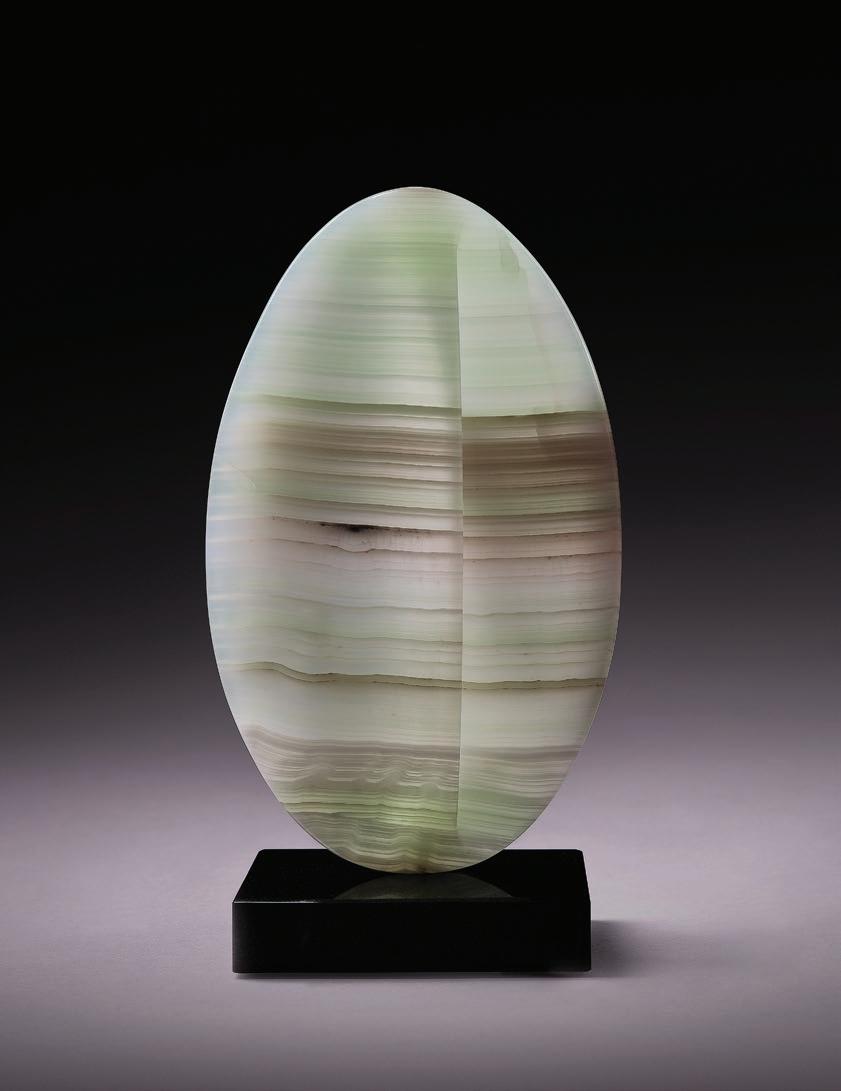
MCEAHERN
72 TREND art + design + culture 2023
Green Durango calcite, 12” tall
WENDY
(4)
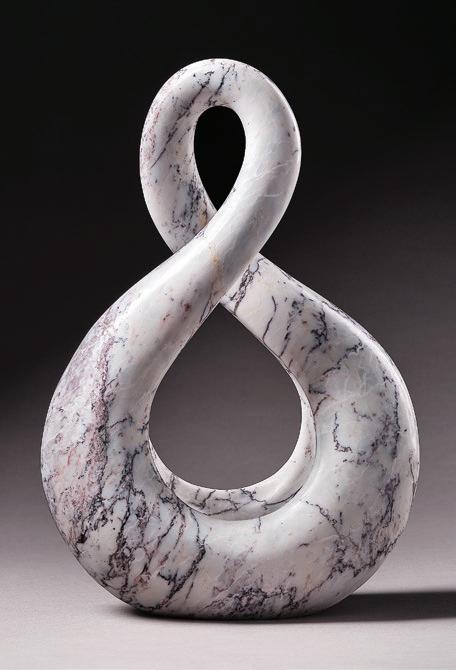


ADVERTISEMENT
73 trendmagazineglobal.com
Clockwise, from left: Turkish marble, 22” tall; Green Durango calcite, 12” tall; orange Utah alabaster, 11” tall; and orange Hannah calcite, 16” tall; Randolph works with a wide range of stone, including (from left) New Mexican marble, green Durango calcite, white Italian alabaster, orange Utah alabaster, and orange Hannah calcite.
PRESCOTT GALLERY and SCULPTURE GARDEN
Fredrick Prescott’s larger-than-life, brightly colored, solid-steel sculptures are truly one of a kind. Engineered to move in the wind or activated by hand, they combine reality with fantasy in an ever-evolving variety of magical images. There are 30-foot-high giraffes alongside pink flamingos, elephants, seahorses, dinosaurs, dragons, and many other real and imaginary creatures.

Everything is created in a 30,000-square-feet studio in Santa Fe. The process is inevitably complex, starting with a drawing transferred to a computer and then on to a machine that cuts sections in steel. The pieces are then powder coated with a spray gun, sandblasted, and then fired in a massive oven that heats the environmentally friendly powder paint up to 500 degrees, melting it into a glossy finish. A final
clear coat protects the work from the weather if it is to be displayed outdoors.
The enormous works are transported all over the country, strapped down on a huge trailer hooked onto a big truck, to be exhibited in museums, public parks, schools, galleries, and private homes. Prescott is also open to commissions and over the years has completed many, including some for celebrities such as Michael Jordan and Steven Spielberg.
The gallery on Agua Fria Street is currently showing a retrospective, with photographs and early works that demonstrate Prescott’s artistic evolution over the years. One may wonder: After a career that spans more than 50 years, has he ever run out of ideas? “Never,” he says. “The problem is too many ideas and not enough time.”
prescottstudio.com | 1127 Siler Park Ln, Santa Fe, NM 87505 | 505-424-8449
TOP:
74 TREND art + design + culture 2023
Prescott kinetic sculptures on safari Opposite left: Free Range Elk, kinetic sculpture, 8’ tall Opposite right: Rockin’ Rooster, kinetic sculpture, 10’ tall
GABRIELLA MARKS PHOTOGRAPHY



ADVERTISEMENT 75 trendmagazineglobal.com
Alvaro Cardona-Hine, a self-taught painter, poet, and musician, was born in Costa Rica and came to the U.S. when he was 13 years old. Later in his life, he settled in Truchas, New Mexico, to devote himself to painting fulltime. He was one of the first artists to bypass the gallery system and represent his own work, opening the Cardona-Hine Gallery in 1988.



Many tourists and art enthusiasts travel through the village of Truchas on their way from Santa Fe to Taos. They come not only to enjoy the wonderful views but also to explore the workshops and studios of artists and artisans along the way. Cardona-Hine’s gallery flourished for almost 30 years until he finally passed in 2016.
A prolific artist, Cardona-Hine painted every day. His works differ widely in style and subject matter, ranging from birds and landscapes to brightly colored abstracts. His determination to remain free, with no recognizable format, is another reason why he opted out of galleries.
His remaining paintings are now in the possession of his daughter, Elena, who is finding homes for the last few hundred. “They really need to be seen, to be hung on walls, and enjoyed,” she says.
Consequently, she has put together an online gallery, cardona-hinegallery.com, so that people can see, enjoy, and purchase her father’s works of art. Sizes, prices, and subject matter vary enormously, so there should be something for everyone. And, as the artist said, “How sad a wall without a painting!”

cardona-hinegallery.com | 505-629-9241 | cardonahinegallery2023@gmail.com
ALVARO CARDONA-HINE
Clockwise, from top left: Bull Totem, acrylic on canvas, 78” x 50”
76 TREND art + design + culture 2023
Alvaro Cardona-Hine portrait Castles in the Air II , oil on acrylic on canvas, 76” x 54”

ADVERTISEMENT
77 trendmagazineglobal.com
Moroccan Evening, acrylic on canvas, 37” x 54”
Worldly
Been everywhere, knows everyone, can pull off anything. Lonnie Schlein, master New York Times photographer-photo editor, shows his stuff.
 BY SUSAN SPANO | PHOTOGRAPHY BY LONNIE SCHLEIN
BY SUSAN SPANO | PHOTOGRAPHY BY LONNIE SCHLEIN
Most of us are deeply compelled—and sometimes fundamentally changed—by the work of photojournalists. Take, for instance, the indelible 1972 picture by AP photographer Nick Ut of a naked child running down a road in Vietnam after a napalm attack. The people who take such photographs roam the world seeking a way to visually express complicated political, moral, and emotional issues. And the right moment—or second—to photograph them. Some do it by instinct. For others, like Lonnie Schlein, getting the most vivid and meaningful shot comes from deep knowledge and broad experience.
Schlein has spent a lifetime looking at photos and shooting them. As a photo editor for some 35 years at The New York Times, he was assigned to the Metro Desk the morning of September 11, 2001, when his editor called him in to the office ASAP. But first he ran to the rooftop of his Midtown Manhattan apartment to capture some of the most achingly tragic images of smoke pluming above the World Trade
Center towers before they fell. With Schlein as photo editor, the paper’s 9/11 coverage won a Pulitzer Prize.
The Times was a lodestar even when he was young. “It was always around the house. I clipped and saved headlines. I have my own archives,” he says. Schlein was born and raised in the Flatbush neighborhood of Brooklyn. He got his first camera, a twin-lens Argoflex, around 1956. At the time, his Uncle Izzy was director of photography at CBS and, as a teenager, Schlein rode the subway from the far reaches of Brooklyn to the television studios in Manhattan, where he hung around the photo lab watching the pre-digital age techs “doing magic,” as he says.
After college, he started at The Times as a copy boy, running across West 43rd Street for cigarettes and coffee at the behest of editors and columnists. As he became one of the paper’s most respected photo editors, he made sure he could keep taking pictures, too. He traveled around the world with a camera. The more he saw, the more he knew.
Sometimes the image would fall in his lap. Right place, right time, as when he shot an ice climber dangling pre -
78 TREND art + design + culture 2023
cariously from a rope in Ouray, Colorado. Or his just-born daughter emerging into the world halfway between womb and obstetrician’s hands. Or the look of indescribable joy on the face of a young Black woman when Barack Obama accepted the nomination for president at the 2008 Democratic National Convention in Denver. Schlein always gives luck its due. Nevertheless, he says, “You must not shoot wildly. Wait for the right moment.”
When you look closely at some of his most powerful images, you see that something more than right-place-right-time is operating. You’ll see a studiousness and informed eye for composition in his photo of a Havana cigar factory worker with a dogeared photo of Che Guevara propped up in the background. The same intensity marks his shot of two boys on a stoop in Ghana who had just escaped from two years of slavery on fishing boats. He couldn’t get them to look at him or into the camera. “They had these empty expressions,” Schlein says. “They were totally destroyed.”
Schlein remembers the decade he was The Times national photo editor as the most exciting time in his tenure at the paper. He convinced Coretta Scott King to let the newspaper use a never-before-seen portrait of the King family and arranged exclusive Times photo ops of then-President Clinton. Getting reluctant subjects to allow photographers to take their pictures became his forte. “Just ask Lonnie,” coworkers would say. “Lonnie can pull it off.”
The story of how he got the last portrait session with John Lennon and Yoko Ono on November 3, 1980—just a month before Lennon’s fatal shooting on December 8, 1980—has passed into Times lore. The famously secretive couple had repeatedly refused the paper’s requests.
Finally, Schlein contacted Yoko and convinced her and John to sit for the portraits, though the paper had to break a cardinal rule and give them photo approval. Moreover, the shoot had to take place at 3 a.m. and only photographer Jack Mitchell was allowed in the studio. When Mitchell finished the contact sheets, Lonnie took them in a cab to The Dakota, where Yoko painstakingly selected 10 shots that she and John agreed the paper could publish. Around 5 a.m. Schlein’s wife, Monique, called. Yoko answered. “I’m sorry I kept your husband so long. He’s on his way home now.”
Photojournalist? Photo editor? Manipulator? Cajoler? There is simply no way of pigeonholing Lonnie Schlein. Never mind. When we look at his images, we see the world recorded by a photographer who has been everywhere, done everything, and seen it all. R

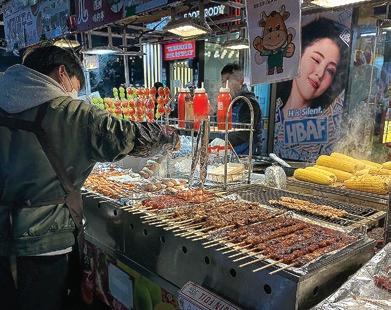 At a market high in the Peruvian Andes about 20 miles north of Cusco, Chinchero village women prepare feasts for visitors.
Top: A street-food chef grills mouthwatering beef and chicken skewers in the red-hot shopping and entertainment district of Myeong-dong in Seoul, South Korea.
At a market high in the Peruvian Andes about 20 miles north of Cusco, Chinchero village women prepare feasts for visitors.
Top: A street-food chef grills mouthwatering beef and chicken skewers in the red-hot shopping and entertainment district of Myeong-dong in Seoul, South Korea.
79 trendmagazineglobal.com
Opposite: The Spanish Coffee Shop and Bookstore on Solny Square in Wroclaw, Poland.

80 TREND art + design + culture 2023
In tiny Oakland Valley, New York, about two hours northwest of New York City, a woman on the banks of the Neversink River takes in the fog and sound of the rushing waters.

81 trendmagazineglobal.com
A visitor takes a break on a visit to Seoul’s ornate Gyeongbokgung Palace, built in 1395 for the Joseon Dynasty, which ruled Korea for more than 500 years.

82 TREND art + design + culture 2023
On a summer day in Copenhagen, a crowd gathers at Nyhavn Harbor to soak up the sun.
Brothers Joe, 10, and Kwame, 12, were sold by their mother to a fisherman in 2014. After two years of hard labor, they returned home and were adopted by a family in Senya

Ghana.
 Beraku,
Beraku,
83 trendmagazineglobal.com
Top: Beached fishing boats line the Gold Coast of Ghana, where “slave castles” built by traders held captured Africans headed to slavery in the Americas. Slavery of other kinds persists in the region.

 A worker strolls past a stone arch along the banks of the fabled Li River in Guilin, China, known for its otherworldly karst mountains and terraced rice paddies.
A worker strolls past a stone arch along the banks of the fabled Li River in Guilin, China, known for its otherworldly karst mountains and terraced rice paddies.
84 TREND art + design + culture 2023
Top: A child wades across a playground flooded after torrential rains in Middletown, New York.

85 trendmagazineglobal.com
Looking up at an eave at 14th-century Jogyesa Temple with Seoul’s electrified cityscape in the background.

86 TREND art + design + culture 2023
In the Libyan Sahara, travelers converse as the sun sets near Ghadamès, a UNESCO World Heritage Site known as “the pearl of the desert.”

87 trendmagazineglobal.com
In one of Havana’s largest factories, a worker rolls cured tobacco leaves, the old method of making cigars by hand.

88 TREND art + design + culture 2023
A joyful delegate at the 2008 Democratic National Convention in Denver learns that Illinois Senator Barack Obama was nominated for President of the United States.
Quick Study
LONNIE SCHLEIN’S YOUTH COULD BE THE PREMISE FOR A VINTAGE MUSICAL COMEDY, not least because his father, Irving Schlein, was a musical director for Broadway shows by the likes of Cole Porter. Dad took the family along on the 1956 national tour of Porter’s Silk Stockings, traveling in luxe railroad sleeper cars. When the company reached a destination, Jan Sherwood, the actress playing the lead, would pose for the press, pulling up her skirt to adjust her garter. After arriving in Los Angeles on the Santa Fe Super Chief, Schlein, a plucky 10-year-old at the time, took a shot and gave the picture to Sherwood. He still has her thank you note saying he was “an excellent photographer.”

With anyone else that would be just an endearing story, but it prefigures Schlein’s longtime fascination with celebrity photography. Over the years, he has photographed everyone from Mickey Rooney to Al Pacino to Paul McCartney.

In the 1980s, as the first photo editor of Arts & Leisure, then one of the fat Sunday feature sections of The New York Times, he and his wife, Monique, were one of the most sought-after couples in New York’s art world.

89 trendmagazineglobal.com
Schlein (far right) and top editors of The New York Times gather on the evening of September 11, 2001, to decide what the next day’s momentous front page will look like.


Thegranddancebeginsagain.Thepullofthemoon mustbeobeyed. - SamScott PieProjectsContemporaryArtishonoredtorepresentthefollowingartists: KATEJOYCE·CAROLINELIU·BRIANMCPARTLON·AUGUSTMUTH DANANEWMANN·EUGENENEWMANN·SAMSCOTT·SIGNESTEWART JUDYTUWALETSTIWA pieprojects.org |924bshooflyst.,santafe,newmexico,usa|505-372-7681
SamScott, HighTideFalling, oiloncanvas,84x120in.


Iamabletocreatefantasticalnarrativesthatsparklarger conversationsofloss,joy,andtheeternityofself. -
PieProjectsContemporaryArtishonoredtorepresentthefollowingartists: KATEJOYCE·CAROLINELIU·BRIANMCPARTLON·AUGUSTMUTH DANANEWMANN·EUGENENEWMANN·SAMSCOTT·SIGNESTEWART JUDYTUWALETSTIWA pieprojects.org |924bshooflyst.,santafe,newmexico,usa|505-372-7681
CarolineLiu
CarolineLiuinherstudio



Nudes and Landscapes
Contemplating and celebrating the female nude in contemporary photography

PHOTOGRAPHY BY PETER OGILVIE
The nude—male or female—has long played a vital role in our perception of beauty, and thus in the fine arts.
From the Apollo Belvedere to Picasso’s Les Demoiselles d’Avignon, it has compelled artists to closely observe, construct, deconstruct, and impart complex meanings to the human form.
In this issue, well-known fashion photographer and frequent Trend contributor Peter Ogilvie takes up the challenge of rendering the nude in landscape, a convention pioneered by 20 th-century photographers like Edward Weston. Ogilvie’s landscapes, though, are different. They are made in the studio out of paper and plastic and set in evocative dialogue with his statuesque female forms.
“I like to create landscapes as environments to reveal and capture the subtlety of the human form,” says Ogilvie. “I have been intrigued by the female nude for as long as I can remember. Female bodies are incredibly various. There is no normal, no standard. The variety is infinite.” R
94 TREND art + design + culture 2023

95 trendmagazineglobal.com


“It is in portraiture and figure studies that photography’s opportunity lies.”
96 TREND art + design + culture 2023
EDWARD WESTON

97 trendmagazineglobal.com

98 TREND art + design + culture 2023
“The Greeks perfected the nude in order that man might feel like a god, and in a sense this is still its function, for although we no longer suppose that God is like a beautiful man, we still feel close to divinity in those flashes of self-identification when, through our own bodies, we seem to be aware of a universal order.”
 SIR KENNETH CLARK
SIR KENNETH CLARK
99 trendmagazineglobal.com
“Does the harmony of the body and soul depend on the ideal beauty that different cultures and times offer us? Rubens preferred fat women, Modigliani thin ones, and Botticelli’s limpet ideal is not the sickly anti-ideal of Egon Schiele. Even so our choice of beauty depends on our concept of beauty. Why is one body more beautiful and another not?”
 CARLOS FUENTES
CARLOS FUENTES
100 TREND art + design + culture 2023

101 trendmagazineglobal.com


102 TREND art + design + culture 2023
“The problem with painting a nude… is that it deepens the transaction. You can scrap a painting of someone’s face and it imperils the sitter’s self-esteem less than scrapping a painting of the whole naked body.”
 LUCIAN FREUD
LUCIAN FREUD
103 trendmagazineglobal.com

“For soul is forme, and doth the body make.”
104 TREND art + design + culture 2023
—EDMUND SPENSER

105 trendmagazineglobal.com




Another Day in Albuquerque
Relaxed vibe, small-town feel, mingled traditions, and a dash of the strange make New Mexico’s big city what it is today
 BY SIMON ROMERO | PHOTOGRAPHY BY ERIC DRAPER FOR TREND
BY SIMON ROMERO | PHOTOGRAPHY BY ERIC DRAPER FOR TREND
Like Victorians out for a spin during the bicycle craze, the couple is dressed to impress. But instead of the baggy-kneed trousers or layered petticoats of the 1890s, their attire consists of flannel shirts, skull rings, a Heisenberg patch, a pink wig. Oh, and their masks: cracked doll-face for her and something that could be hazmat-inspired for him. What’s going on here? Is it Halloween? Or just another day in Albuquerque?
Breezing down Central Avenue on their lowrider bikes, the man and woman captured in a photograph by Eric Draper seem blissfully unconcerned with the hubbub around them. The Mother Road—a.k.a. Route 66—stretching across Albuquerque provides just one stage on which to document human behavior in the city. Draper, who first lived in the city
in the early 1990s as a staff photographer for the Albuquerque Tribune, finds one place after another where he bears witness to what makes this place in the high desert unique.
Sometimes it takes someone like Draper, who has traveled to some 70 countries, to appreciate Albuquerque’s relaxed vibe. Originally from Southern California, he worked for the Associated Press before embarking on an adventure that gave him an exceptional glimpse into the corridors of power. For eight years, he was former President George W. Bush’s official photographer, assigned an office just steps from the Oval Office. Observing the administration’s high and low points, as well as its more mundane moments, all while traveling around the globe at a pace that would fatigue even the most hardened road warriors, Draper and his
110 TREND art + design + culture 2023



111 trendmagazineglobal.com
Clockwise, from top left: Lowrider enthusiasts gather every Sunday on Central Avenue in downtown Albuquerque to show off their vehicles; 18-year-old Ramon Guzman hangs out on the hood of his 1948 Chevrolet delivery panel wagon; a 1954 Classic Chevy Deluxe displayed on Central Avenue. Opposite: A 1,225-square-foot mural by artist Todd Hebenstreit evokes the glory days of Route 66 on the side of an apartment building in Albuquerque.

 Miranda Sanchez, 26, proudly shows off her Day of the Dead costume during the annual Albuquerque Marigold Parade.
Miranda Sanchez, 26, proudly shows off her Day of the Dead costume during the annual Albuquerque Marigold Parade.
112 TREND art + design + culture 2023
Top: Costumed Day of the Dead revelers walk in the parade. On the first Sunday in November, people from all over the city come into the South Valley to remember the living and the dead.
A flight-line referee gives the launch signal during the Mass Ascension at the 2017 Albuquerque International Balloon Fiesta. The referees, also known as “zebras,” always wear costumes with black-and-white stripes to stand out from the crowd.

Top left and right: New Mexico United soccer fans show their passion during a recent home game.


113 trendmagazineglobal.com
Crowds view the Mass Ascension at the 2017 International Balloon Fiesta. For nine days in October the Balloon Fiesta creates an enchanting world in the sky. Top: At dawn, a young couple shares an intimate moment at the fiesta. Weather permitting, hundreds of hot-air balloons launch at sunrise during the Mass Ascension.


114 TREND art + design + culture 2023


115 trendmagazineglobal.com
A bartender serves beer on tap at Albuquerque’s Marble Brewery. The city has become a hotspot for breweries serving craft beer. Top: A tourist tries on a cowboy hat at The Man’s Hat Shop in Albuquerque.

116 TREND art + design + culture 2023
On display at Albuquerque’s National Hispanic Cultural Center is Mundos de Mestizaje, Frederico Vigil’s 4,000-square-foot fresco, which covers the interior of a 45-foot-tall adobe tower and depicts 3,000 years of Hispanic culture.
wife decided they needed a change. They decamped to Rio Rancho on Albuquerque’s outskirts.
“New Mexico is the opposite of DC,” said Draper. “The pace of life here is very manageable.” At the Albuquerque Tribune, Draper worked with Mike Davis, an award-winning photo editor who made the newspaper’s reputation for its innovative use of photography. Draper learned about layout and design at the Scripps-Howard afternoon daily, as well as making the most out of even the lowliest assignments. Davis went on to serve as Draper’s deputy at the White House. The Tribune, like so many other newspapers gutted by the changes sweeping the information industry this century, ceased publication in 2008.
Still, Albuquerque beckons. Indigenous peoples have been living in the area for at least 10,000 years. When the expedition led by the conquistador Francisco Vázquez de Coronado arrived in 1540, they found thriving pueblos of Tiwa-speakers cultivating gardens in the Río Grande’s floodplain. Founded officially in 1706, Albuquerque endured, precariously at times, on the edge of empires. It wasn’t until 1950 that Albuquerque’s population reached almost 100,000; as the postwar boom intensified, the number of residents doubled by 1960 and kept on growing. The sprawling city
now has a metropolitan population of about one million. But as Draper shows, Albuquerque can still feel like a small town, somehow part of the American experience and somehow foreign to it.

Different traditions mingle in Albuquerque. The Balloon Fiesta goes on, filling the skies with the wonder each year. At the same time, new customs take root. For those who grew up in the state’s small towns, where basketball and football have long held sway, the rise of New Mexico United, the Albuquerque-based professional soccer team founded in 2018, reflects how newcomers—and new traditions—are pushing the city to evolve, as Draper shows in his pictures of The Curse, the organization of devoted fans adopting the inclusive motto “Somos Familia.”
Then there’s the Marigold Parade, which draws from traditions that include Mexico’s Day of the Dead. Another couple, costumed to the nines, stands out in one of Draper’s pictures from the South Valley. Like the lowriders, their identities are hidden behind masks and face paint, as if hinting they might still have one foot in the grave. Or are they smiling behind their masks? Is that a hint of a grin? As Draper shows, sometimes it’s hard to tell in Albuquerque, cryptic even until the masks start coming off. R
117 trendmagazineglobal.com
Photojournalist Eric Draper moved to Albuquerque for a slower lifestyle and room for his two dogs after shooting for the Associated Press and major publications, and serving for eight years as chief photographer for President George W. Bush.
The form is always the measure of the obsession.


 ~ Alberto Giacometti
~ Alberto Giacometti

DIEGO J. VELÁZQUEZ
INSTAGRAM: SANTAFEMETAL22 | DIEGOJVELAZQUEZ.COM | SANTAFEMETAL.COM
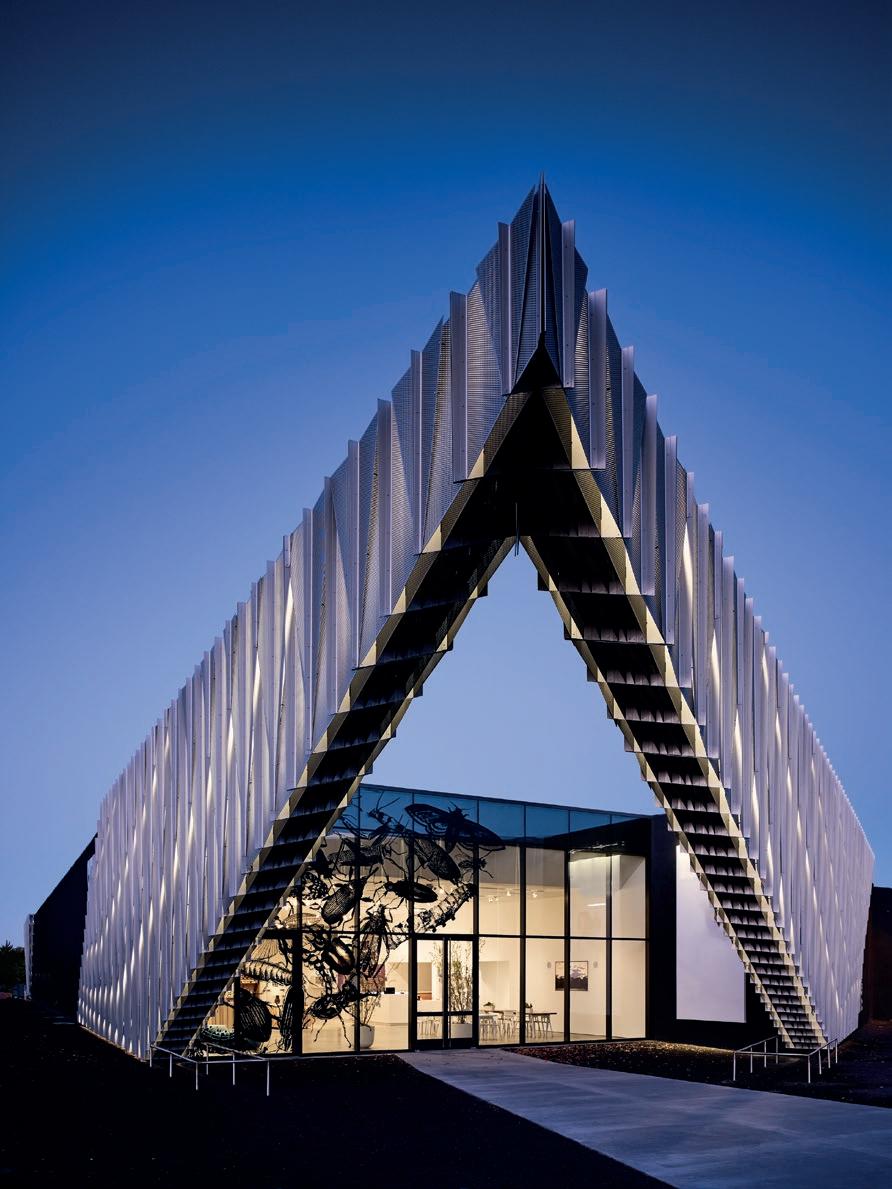
Bruce Nauman His Mark June 2 - September 11, 2023 GOING WITH THE FLOW : Art, Actions, and Western Waters April 14 - July 31, 2023 Deborah Roberts Come walk in my shoes August 11 - November 6, 2023 Rachel Rose Goodnight Moon June 2 - September 11, 2023 ON VIEW AT SITE SANTA FE SPACE FOR CONTEMPORARY ART FREE ADMISSION For a full schedule of programs and events visit sitesantafe.org or call 505.989.1199
life’s work
How two eminent, long-married photographers, archivists, and gallerists changed the artistic landscape of Santa Fe by putting photography at its heart
BY STUART A. ASHMAN PHOTOGRAPHY BY JANET RUSSEK AND DAVID SCHEINBAUM
Perhaps it is the quality of light and the monumental landscapes. Or the diversity of ancient cultures and traditions. Whatever the lure, New Mexico, particularly Santa Fe and Taos, has attracted artists and photographers for millennia.
Native Americans had been making art here for centuries before Europeans arrived. But it was more recently that New Mexico earned its estimable reputation in the art world. In the late 1920s, a group of painters known as “Los Cinco Pintores” made Santa Fe their headquarters, building studios and houses on Camino del Monte Sol. A broken wagon wheel led Ernest Blumenschein and Bert Phillips to remain in Taos to paint and found the Taos Society of Artists. Mabel Dodge Luhan, after settling in Taos, invited writers and artists, including the iconic Georgia O’Keeffe.
Photographers were not far behind. New Mexico attracted Ansel Adams, Paul Strand, Minor White, Willard Van Dyke, Laura Gilpin, Paul Caponigro, Walter Chappell, and William Clift among others. Some visited regularly; others settled permanently.
Janet Russek and David Scheinbaum are two photographers who came from New York City in the late 1970s and, like many artists before them, made New Mexico their home. The dynamic husband-and-wife duo are among the art world’s most important photographers. Though the subjects of their images are sometimes widely different—from pregnancy to Hip Hop—they share parallel masteries of photographic techniques, infinitely careful skills of observation, and intellectual curiosity that make their images beautiful and fascinating.
Parallel, too, are their deep reverence for the great photography of the past and a sense of responsibility about keeping it in front of the public. The impact that they have made as educators and coaches has impacted countless nascent photographers in New Mexico and together they have made an important place for photography in Santa Fe.
Brooklyn born and bred, the couple has shared roots in Jewish families and neighborhoods. “Our families focused on the arts and education,” Russek says, whose family history includes artists and an appreciation for art. “The Brooklyn Museum was a part of our lives from childhood on.”
120 TREND art + design + culture 2023

121 trendmagazineglobal.com
Janet Russek, Amaryllis Stems and Bud (2002).


122 TREND art + design + culture 2023
David Scheinbaum, Cross of the Martyrs, Santa Fe (1979).
Top: Janet Russek, Bridge Mural, Santa Fe (1983).


123 trendmagazineglobal.com
David Scheinbaum, El Rancho de las Golondrinas, Santa Fe (1980).
Top: Janet Russek, Gilbert and Ruff (1984).


124 TREND art + design + culture 2023
Three images from Janet Russek’s series, The Wheelbarrow, photographed over four seasons and several years. Dry Pine Needles (2018) and Floating Pine Cones (2019). Opposite: Isabella and the Wheelbarrow (2020).

125 trendmagazineglobal.com

126 TREND art + design + culture 2023
Janet Russek, Pregnancy III (2006).
Both were educated in New York public schools and graduated from the City University of New York colleges. Russek trained as an archivist and conservator at the Brooklyn Museum. Scheinbaum studied and practiced his photography and, at a very young age, taught photography at Pace University and LaGuardia Community College in New York. They met through mutual friends in Brooklyn in 1978 and married in 1982.
Scheinbaum’s interest in photography led him to New Mexico in the late 1970s. While studying the history of photography, he learned that one of his heroes, Beaumont Newhall, lived in Santa Fe. Widely recognized as “The Father of the History of Photography,” Newhall served as the first curator of photography at New York’s Museum of Modern Art and was a persuasive advocate for the recognition of photography as a legitimate art form.
Scheinbaum’s dream was to work with Newhall, so he made a cold-call. Much to his surprise, Beaumont agreed, and there began a relationship that lasted more than 15 years and changed Scheinbaum’s and Russek’s careers and lives.
“I had visited Santa Fe during a cross-country trip in the early 70s and was quite enchanted with it,” Russek says. “When David decided to move, I was the only friend who supported the plan and even helped him pack.”
Scheinbaum’s first project for Beaumont: Organize his mentor’s library. Drawing on his knowledge and family history in the book business, Scheinbaum successfully devised a system of cataloging and reorganizing Newhall’s collection of precious books. Next, Scheinbaum became the exclusive printer for Newhall’s images, moving the process away from a New York laboratory to Santa Fe. Scheinbaum now serves as the executor of the Beaumont and Nancy Newhall Estate.
Russek joined Scheinbaum in Santa Fe in 1980. “We both were ready for new adventures and Santa Fe was—and still is—a place where you are accepted as artists and you can have dreams that come through with hard work,” she says.
Through the artists’ network in town, Russek was recruited to serve as an assistant to the eminent photographer Eliot Porter. She became his archivist, assistant, collaborator, and good friend. She began by helping Porter mount his color photographs for a 1979 Intimate Landscapes solo exhibition at the Metropolitan Museum of Art in New York. She spent the next three years cataloging some 7,000 of Porter’s photographs, becoming so familiar with the scope of his oeuvre that she inspired several new publications of his work.
Porter’s photographic archive was committed to the Amon Carter Museum in Fort Worth, Texas. In order to continue his legacy in his hometown, Russek suggested to Porter that

127 trendmagazineglobal.com
Janet Russek, People in Paintings (2014).


128 TREND art + design + culture 2023
David Scheinbaum made several long-anticipated pilgrimages to Varanasi, India, which resulted in Varanasi: City Immersed in Prayer, his most recent book. A Family of Devotees Wait for Sunrise on the Banks of the Ganges (2019). Top: Tripura Bhairavi Ghat (2017). Opposite: Chhat Puja, Waiting for Sunrise (2019).
he also leave a representative body of his life’s work to the permanent collection of the New Mexico Museum of Art in Santa Fe. It represented a significant gift to the State of New Mexico, and Russek now serves as the representative of the Eliot Porter Estate.
The seemingly tireless couple turned to another project intended to feature the photographers they most admired. In 1980 they created Scheinbaum & Russek Ltd., a gallery in a modest adobe house in what was then the Westside barrio. The inaugural show featured the work of Willard Van Dyke. Subsequent exhibitions focused on Edward Weston, Diane Arbus, Manuel Carrillo, Manuel Alvarez Bravo, Henri Cartier Bresson, Robert Frank, Gustave Baumann, and many others.
After that success, they moved in 1987 to Guadalupe Street in the area now known as the Railyard and remained there until 1994, after showcasing more than 300 photographers. Then they built a gallery, archive, and library next to their home and continue to represent the highest level of photography internationally.
Scheinbaum also served as a professor of photography at the College of Santa Fe for 33 years, and was awarded the

honorific of professor emeritus. Later at the Marion Center for Photographic Arts, he served as director and subsequently distinguished himself as director and chair of Photographic Studies at the Santa Fe University of Art and Design.
Meanwhile, Scheinbaum and Russek continued to develop significant bodies of their own photographic works and collaborated on several projects and books. Among their collaborations is Images in the Heavens, Patterns on the Earth: The I Ching, Museum of New Mexico Press (2004), a handsome volume of their photographs that enhances the written words in this ancient Chinese classic. “The I Ching is one of our most important projects together as we use the I Ching and its counseling in our lives,” says Russek. “In many ways it is autobiographical.”
Another joint work is Ghost Ranch: Land of Light, Balcony Press (1997), which required the couple to hike for years through hundreds of acres to photograph the landscape and environment that so deeply inspired Georgia O’Keeffe. Later they spent a decade making photographs in New York’s Lower East Side, culminating in the 2017 Radius Books publication Remnants: Photographs of the Lower East Side
“Remnants brought us back to our roots in New York and
129 trendmagazineglobal.com

130 TREND art + design + culture 2023
David Scheinbaum, Two Sadhus at Waterside, Kedar Ghat (2016).


131 trendmagazineglobal.com
From holy India to Hip Hop with David Scheinbaum: Questlove, The Roots, Sunshine Theater, Albuquerque (2003). Top: Gza and Rza, Wu Tang Clan (2007).



132 TREND art + design + culture 2023
Clockwise, from top: Janet Russek, Hat and Coat Hanging (2009); Memories, Typewriter (2009); Dolls, Emma (2008).

133 trendmagazineglobal.com
Janet Russek, Pregnancy I (2005).


134 TREND art + design + culture 2023
Janet Russek, Orchard and Pedernal, Ghost Ranch, NM (1993). Top: David Scheinbaum, Shiprock, NM (1999). Opposite: Photographers, archivists, and gallerists Janet Russek and David Scheinbaum in 2023 (photo by Andra Russek).
the history of immigration and Jewish culture in both our families,” Russek says.
Radius Books also published a monograph of Russek‘s long-term project, The Tenuous Stem, focusing on new life emanating from a seed, bud, or a woman’s pregnant belly.
Hip Hop: Portraits of an Urban Hymn, Damiani (2013), is Scheinbaum’s exploration of the beauty and dynamism of the Hip Hop world. It includes photos that were in the first exhibition of Hip Hop imagery at National Portrait Gallery in Washington, DC, in 2008. His most recent effort, Varanasi: City Immersed in Prayer, George F. Thompson Publishing (2022), beautifully documents the people and ceremonies in this holy city in India.
Having found a vibrant arts culture in Santa Fe when they arrived from the East, Scheinbaum and Russek helped

put photography at its heart. They participated in the Santa Fe Center of Photography, a gathering place and modest exhibition space for New Mexico’s photographers, beginning in the late 1970s. They are also founding members of the New Mexico Council of Photography and Russek is one of the founders of the Santa Fe Children’s Museum.
Russek and Scheinbaum credit their mentors, Eliot Porter and Beaumont Newhall, with teaching them the importance of passing on one’s knowledge to future generations of young photographers, because they were fortunate enough to work with these two giants of photography. Both Russek and Scheinbaum take this responsibility seriously and it serves as the guiding light of their work. Their gallery and personal library of photographic books are testimony to their commitment to this medium and to the artists who work in it. R
135 trendmagazineglobal.com

333 MONTEZUMA, NO. 5 SANTA FE CARA ROMERO PHOTOGRAPHY STUDIO + GALLERY STUDIO+GALLERY+EVENTS+TOURS CARAROMEROPHOTOGRAPHY.COM


ON AUDACITY (What I Want to Say to Santa Fe)
The celebrated mixed-media artist Rose B. Simpson in words and images
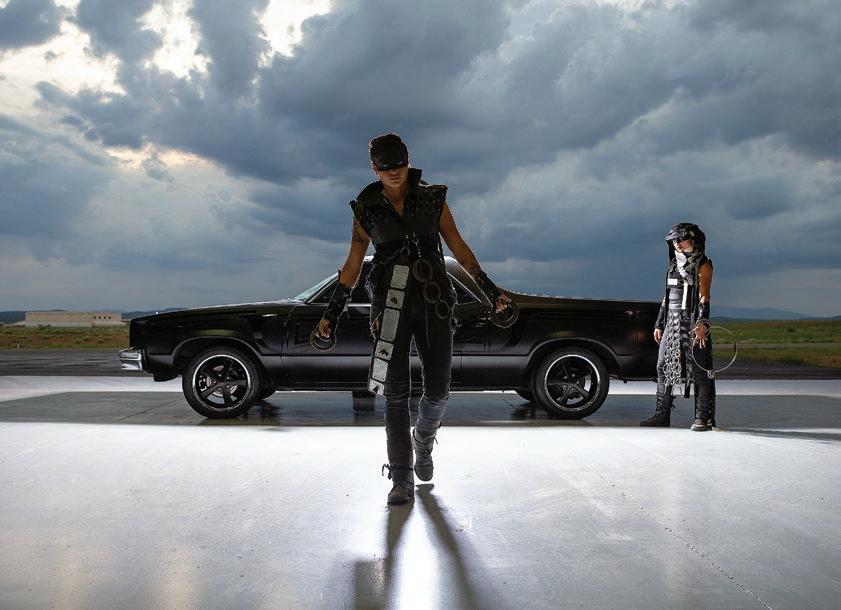
138 TREND art + design + culture 2023
BY ROSE B. SIMPSON
PHOTOGRAPHY BY KATE RUSSELL

It’s a Thursday late afternoon and I’m in a hotel room on 10th Avenue in Manhattan’s Chelsea neighborhood. My black linen shirt is still nicely flattened on the ironing board, a few pieces of jewelry next to it. I’m curled up in the pink chair by the window to gather my thoughts, tracing the leafless branches of the one tree outside with my eyes. Amidst the smattering of New York City street sounds, my phone buzzes. I don’t dare look at it.
I’m missing home. I miss my mama—the sun across her living room floor, the crackle in her wood stove, the smell of bean stew. I miss the silent nights broken only by dog barks and coyote calls. I think of my converse tracks all around the sandy driveway. Proof of life. I close my eyes and I’m suddenly walking the hill behind the house. Stiff yellow grasses twitch through long juniper shadows in a raking afternoon breeze.
My phone buzzes again, and I flip it over to see the numbers on the screen. It is time. I pull the shirt over my head, then lower the strands of heishi beads to my shoulders. I catch my somber reflection in the mirror and take a deep breath. It’s time for this ceremony.
From the street I can see my name in big, vinyl letters through the gallery window. My feet don’t leave tracks on these damp sidewalks, but here, this is one way to make a mark. Before I take the first step into the gallery-opening maw, voices beginning their layering into a monotone chorus, I whisper a small prayer: Guide me, help me to know my way.
139 trendmagazineglobal.com
Simpson’s Dream House at the Fabric Workshop and Museum in Philadelphia. Inverted vessels shaped like bowls and marked with symbols of direction and protection form the ceiling of the final room in the Dream House experience. Opposite: In Simpson’s Maria (1985), a 1985 Chevy El Camino is pictured with the artist and Freyr Acton as post-apocalyptic Indigenous warriors.
I’ve spent my life pondering lots of things; one has been the role of audacity in my becoming.

I was born at the Santa Fe Indian Hospital and spent most of my childhood in my ancestral homelands at Santa Clara Pueblo, with alternating weekend visits to my father’s in Santa Fe. I lived in the very transformer on the utility pole of culture, passing through me back and forth, forever duly noted. My bicultural vantage point, a misfortune/privilege.
My families: psychologically complex, academically sutured, glistening sharp, blissfully haphazard, tortured and innovative, rapturous, headstrong, and notoriously misfitted.… This was what grew me.
For these foundational neural pathways, I give thanks. For the (many) moments of self-righteous justification, I give a chuckle and a thanks. For the stomach drop when the chair collapses under me and I ended back at the bottom of my self-loathing, I give thanks. Who, yes, who do you think you are?! What a ride.
Audacity has taught me to believe my thoughts, deeply. I’ve marched them straight to handcuffs in the backseats of police cars, lengthy art school critiques, drudges, slogs, and eruptions through a plethora of relationship dynamics. These audacious thoughts were my fuel, my ID, my ticket to ride, with a can of Red Bull in hand. My self-righteous victimhood paraded me through the times when the sucking hole in my center might have imploded, but didn’t, and I give thanks. My audacity got me here. My irreverence and my daring, toxic natures made changes happen. My disdain for beliefs that differed from mine pulled, prodded, and whined. I stomped until I got what I thought I wanted. But there was always more. I preyed on audacious discomfort.
My art practice is not a perfect one. I have dared myself to threaten what I was taught was acceptable, to delve into distorted figure, or reality, or imperfection. I have journeyed to find love in the roughage of self. I’ve scratched and clawed at truth. I’ve spat and screamed and sobbed,
140 TREND art + design + culture 2023
Simpson places River Girls (2019, clay, wood, and metal) along the water’s edge. The work was made in response to the Missing and Murdered Indigenous Women and Girls crisis in communities across the continent and beyond.


141 trendmagazineglobal.com
River Girl 1 and River Girl A are punk immortals who have protective metal feathers that run down their backs like the sharp spines of an iguana. Top: The warrior twins have prayer beads for arms.



142 TREND art + design + culture 2023
Clockwise, from top left: Simpson participates in the 2022 Native Guitar Tours New Mexico showcase at the KiMo Theatre in Albuquerque; a Simpson-designed necklace worn by participants; and a Simpson belt.

143 trendmagazineglobal.com
Maria, a 1985 Chevy El Camino, is driven up Canyon Road in Santa Fe flanked by a squad of post-apocalyptic Indigenous warriors and people with queer identities. During the procession, the sound of a heartbeat was broadcast through a 1,000-watt speaker system from the El Camino.


145 trendmagazineglobal.com
Countdown I, II, and III (2020, made of clay, steel, leather, jute string, grout, and adhesives) is installed with a photo of Maria, a 1985 Chevy El Camino, in the group show Ceramics in the Expanded Field at MASS MOCA, North Adams, Massachusetts.


146 TREND art + design + culture 2023
Simpson’s Dream House installation consists of multiple spaces made out of plaster, mud, and lathe, using traditional building techniques found throughout New Mexico and the Santa Clara Pueblo. Each room signifies a part of the process and experience of bringing art into the world. Top: Simpson sits at a table in a Dream room that yields rest and safety, collecting and gathering with the ancestors.


147 trendmagazineglobal.com
A room in Simpson’s Dream House invites community and dialogue. Top: Another room people can enter with shoes off.
and turned the volume all the way up—which might be why my ears ring and my eyes feel so heavy. There are stories in there.
All this digging, chewing and spitting, ripping at myself and everyone around me, and there I was: tired. Breathing hard. Sitting at the head of a massive trail of destruction. Accomplished. Deconstructed.
There I was, so tired I didn’t have the energy to believe myself anymore.
And for once, there was silence. It felt good. Like shadows do.
The justifications dissolved, the bones from my jaw to what was once the soft place in my infant skull unclenched.
Is it still audacity if it is not inherently in a state of opposition? Even the turmoil found a neutral witness. For what, what could I possibly know?
I still might ask, I still might listen, I might just wonder. I might, at times, find solace in an old pattern and get back

to my entitled beating. And this, too, makes some endearing sense.
In all the breaking down, there is rhythm and process. In all the smashing is faith. I might laugh when something breaks, feel the smallness in an exhale and the strata move on an inhale. I might remember that the witnessing goes both ways. I might notice that vulnerability might just be an audacious act in a world reeking of entitlement. Hey, we are not alone. Hey, water flows with the grace of a guest.
My audacity is the squeeze of my lungs to push my breath in prayer as it curls down around my chin and up over my nose, wrapping itself between my eyes and trickling through the strands of my hair. It plops itself to the earth and sieves through the crust. It flaps and lifts higher and higher, and upon hitting sunlight, scatters into thousands of miniature spheres, each popping like soap bubble explosions, turning into the wild.
It is an audacious one, intention in the third dimension. R
148 TREND art + design + culture 2023
With her hands in clay, Simpson builds a sculpture in her studio. Opposite: Counterculture, 12 nine-foot-tall cast concrete figures, sits on the Field Farm in Williamstown, Massachusetts, the ancestral land of the Stockbridge-Munsee Band of Mohicans. The figures are adorned with beaded necklaces made of clay from the surrounding lands.

Wanenmacher’s World
One of Santa Fe’s most spellbinding artists is assembling an exhibition for SITE Santa Fe in the fall of 2024. Trend previews her deep, droll new work.
 BY CYNDY TANNER | PHOTOGRAPHY BY KATE RUSSELL
BY CYNDY TANNER | PHOTOGRAPHY BY KATE RUSSELL

150 TREND art + design + culture 2023
Arusted metal sculpture of a spider with eight reflective glass eyes greets you at the gate of Erika Wanenmacher’s 1,500-square-foot studio in Santa Fe. Wanenmacher has an affinity for spiders, and she has made many out of various materials during her career as a mixed-media installation artist. They are more than just mythic creatures to her: Spiders fascinate her because they weave artistic worlds with their complex webs. Weaving, in the sense of pulling things together and building structures, are at the heart of Wanenmacher’s art.
A Santa Fe multimedia artist for more than 40 years, Wanenmacher attended the Kansas City Art Institute and the Feminist Studio Workshop in Los Angeles before settling here. It seems the move was meant to be. She says she dreamed of New Mexico’s landscape before seeing it for the first time.

“My work is about personal narrative as well as storytelling,” Wanenmacher says. “It’s about the larger world I exist in, be it my community, the plants and animals I engage with, and further out, the ideas I’m interested in.”
Inspiration comes to her in a variety of ways and waiting for the idea to show up is the most uncomfortable part of her creative process. When the ideas come, she emphasizes that they come through her, not from her—and that’s where the gift lies.
Wanenmacher employs conscious practices to get through the in-between time and clear the path for the next idea. One way is to take in many visual stimuli to discover what interests her and sparks a response. She may browse thrift stores for odd pieces that might end up in her creations. Another source of inspiration: daily walks with her Catahoula leopard dog, Eva. Wanenmacher may scavenge
151 trendmagazineglobal.com
Wanenmacher works on the beginnings of a seven-foot-tall time traveler made of steel and found glass. The glass acts as both the internal makeup and protective layer of the sculpture. Opposite: Wanenmacher peers through a crystal ball, one of many found or sourced objects that find their way into her work.


152 TREND art + design + culture 2023
Much of Wanenmacher’s work reveals some element of self or selfportraiture. She incorporates a variety of materials and elements, including rock, paper, steel, clay, crystals, wood, and intentions in her pieces.

Clockwise, from top left: We were only this old, a hand-carved apricot wood figure; the artist uses a welding torch on the armature of a ghost dog, part of a larger installation; Wanenmacher places crystals on a head in a work in progress; the artist’s desk holds a wide, eclectic range of inspirational sources and reading, which contribute to her work.

153 trendmagazineglobal.com
the ditch near her home for shards of iridescent glass, interesting artifacts, and sticks.


As she was walking in the ditch a few years ago, the idea came to her: What time travel feels like, sometimes. Exploring this set her working at a pace she refers to as a “slow tornado.”
The artwork she has been creating in response will be part of an upcoming show at SITE Santa Fe, scheduled for the fall of 2024, which she calls what TIME TRAVEL feels like, sometimes. Time and consciousness are the subjects of the exhibition, which will include paintings, sculpture, installation, and video. The art incorporates a range of techniques and materials, such as forged steel, found glass, archival photographs, and carved, painted, and lasercut wood.
Photographer Kate Russell regularly drops by the artist’s studio, formerly an auto repair shop, to record Wanenmacher’s process and progress as she prepares for
the SITE show. Longtime friends and collaborators, they have worked together on several projects.
Culling from her trove of found iridescent-glass pieces, Wanenmacher fashioned a seven-foot-tall time traveler. The piece, which she describes as a self-portrait, is comprised of hundreds of individually wire-wrapped glass pieces that are fastened to a structural grid of forged steel.
Exploring new ways of making things and pushing the boundaries and capabilities of various materials motivate Wanenmacher. For this skilled artisan with innate engineering inclinations, it’s about what she can do with the materials and how she shapes them to her purposes.
Wanenmacher considers the slow, meditative process of repetitive handwork vital to her creative process: It frees her to think about the larger story she wants to tell. Working like this—wrapping glass, cutting, bending, and welding—allows her to think about other things. She views it as a form of time travel. “Your eyes are open,”
Left: The artist holds a piece of found glass, part of her treasure trove eventually worked into a sculpture.
Right: A hand-carved wooden black cat among the summer datura flowers outside Wanenmacher’s studio.
154 TREND art + design + culture 2023
she says. “You’re in the room, but you’re not in the room. You’re not seeing the room you’re in. You’re seeing where you are going, and you’re in another place.”

All materials and methods are fair game, which partly explains Wanenmacher’s palpable delight in having built a talking automaton. Titled Entirely Inappropriate Peripheral, it’s constructed from vintage TV trays and rigid Erector Set components that she’s stretched, bent, and pushed to their limits. “I make artwork partially to establish a dialogue with other people, but I also make stuff to amuse myself,” she says. “I make stuff that I think is super funny. I like making things ’cause it’s just so damn much fun.”
Entering Wanenmacher’s studio is like slipping through a portal and landing inside a kaleidoscope. The controlled chaos feels as if it’s part Willy Wonka workshop, part natural history museum, and part landfill. A forging anvil stands sentinel beside an oxy propane welding torch. Nearby is a MIG welder, which Wanenmacher describes as “a giant glue gun for steel.” Surfaces are littered with tools.
Projects and materials in varying stages of completion are scattered everywhere.
Her pieces hang here and there, seemingly in dialogue with one another. Suspended from a beam is a wooden boat with whale eyes painted on either side of the prow. A sculpture of a Burmese python features an actual snakeskin that appears to glow in the dark. A carved head of a red-shafted flicker adorns a wall opposite a carving of a five-foot-long, shellacked wooden cicada titled Born Again Catching the last bit of afternoon light is a 13-foot-by-30foot wall made of more than a 1,000 pieces of sparkling, wire-wrapped iridescent glass. In a far corner, a lead-glass spider beckons.
For a glimpse inside Wanenmacher’s ever-curious mind, look no farther than the small desk in the center of the room. It’s the only (relatively) uncluttered horizontal surface, home to three tall, tidy towers of books. The heady titles range in subject matter and include Lewis Hyde’s The Gift: Imagination and the Erotic Life of Property, Julian
155 trendmagazineglobal.com
The artist and her dog Eva out for their daily walk, finding objects and materials along the way.


156 TREND art + design + culture 2023
Wanenmacher in her element. Top: If you look hard enough, you will see the artist’s eyes staring back at you.
Jaynes’ The Origin of Consciousness in the Breakdown of the Bicameral Mind, and William Gibson’s The Peripheral Wanenmacher also has had a lifelong interest in science fiction and the relationship/conflict between the botanical realm, human beings, and other animals.
In addition to her work as a mixed-media artist, Wanenmacher has sold her own Ditch Witch incense and home altar accoutrements. Occasionally, when customers requested guidance, she told them to return when they could answer two questions: “What do you want a spell for?” and
“What do you need a spell for?” Wanenmacher says she now realizes that having clear intentions pertains to her artwork and to casting spells. She makes “spells” in the form of objects, and objects made with intention carry a resonance that can shift energy, power, and beliefs.
Whether she’s welding a giant metal spider or wrapping wire around glass shards that will be used in a ghost dog sculpture, Wanenmacher says she loves making things and exploring the limits of materials. These passions compel her to create art that is, in a word, spellbinding. R
 The completed glass sculpture, what TIME TRAVEL feels like, sometimes, holds pride of place in Wanenmacher’s studio, a converted auto repair shop.
The completed glass sculpture, what TIME TRAVEL feels like, sometimes, holds pride of place in Wanenmacher’s studio, a converted auto repair shop.
157 trendmagazineglobal.com



MATTRESSES PILLOWS BEDDING FURNITURE SPECIAL GIFTS APPAREL 815 PASEO DEL PUEBLO SUR / TAOSLIFESTYLE.CO M LET IT MOVE YO U. PHOTOGRAPHY: GERAINT SMITH
WE INVITE YOU TO DISCOVER OUR WIDE ASSORTMENT OF PREMIUM QUALITY PRIVATE-LABEL MATTRESSES AND BEDDING. THE RESULT OF 30 YEARS OF LISTENING TO FOLKS WHO LOVE TO SLEEP.

815 PASEO DEL PUEBLO SUR / TAOSLIFESTYLE.CO M PHOTOGRAPHY: NINE KOEPFER 815 PASEO DEL PUEBLO SUR / TAOSLIFESTYLE.CO M LET IT MOVE YO U. DO U B L E - M TAO S BRAND ™ SINC E MMXXI COMING / SUMMER 2023
ELUSIVE TAOS
You can visit the historic plaza, watch the Turtle Dancers at the pueblo, gaze into the great rift of the Río Grande and never understand Taos. But this longtime Taoseño and gifted photographer really gets it
BY BILL CURRY
Iarrived in Taos for San Geronimo Feast Day at the pueblo. It was the fall of 1992. At first I found Northern New Mexico dry and inhospitable, despite the beautiful gorge, great hot springs, and stunning mountains. On my second day in Taos a friend took me to that ancient site, Tuah-Tah or The Place of the Red Willows, continuously inhabited for almost 1,000 years. It was like time travel. My heart sang. The magical light, the thick-walled adobe of the pueblo, its beautiful people, ancient songs and dance, and the sacred mountain behind it spoke to my heart in the most powerful way.
The sacred Taos Mountain grabs your imagination and heart. It pulls you into the land of enchantment, compelling you to stay until its intensity sends some packing, fleeing from the brightly polished mirror of self-reflection that is its surface, back onto the journey of life somewhere else. But if you stay, you may never leave.
One huge reason I stayed is the light, the glorious pure light that is unlike anywhere else in the world. The sublime colors, surreal sky, exceptionally long views, clear nights. The snowfall in winter melting off before noon and the intense summer sun with its blue-sky days bringing ephemeral light and dark cool shadows. July’s triple rainbows and the rolling reverberations of Thunder Beings breaking across fairy-tale summer clouds.
The Grammy Award-winning, pueblo-born musician Robert Mirabal once said that all roads lead through Taos. I believe he meant the pueblo, which has been a trade center for many North American tribes. The Río Pueblo’s crystalline waters, with its source at Blue Lake, runs through the pueblo separating the north and south sides. For me it is always an honor to walk over the bridge, going to see friends I have made through the years and attending dances open to the public.
Around 1900 artists Bert Phillips and Ernest Blumenschein passed through and decided to stay when their wagon broke down. Author and art patroness Mabel
Dodge Luhan brought luminaries like D.H. Lawrence, Aldous Huxley, Georgia O’Keeffe, and Ansel Adams to Taos. Then came the hippies, gurus, writers, poets, musicians, and artists of every stripe who just land in Taos and find themselves in awe of the magical light, the rawness, the pure inspiration of this remote place at 7,000 feet above sea level. The human diversity is extraordinary.
Spiritual seekers of all kinds, disillusioned with the material world and looking for something, come here and find freedom to be authentic—Catholics, Buddhists, Hindus, Muslims, and Taoists. Lamas perform Tibetan rites early on Saturday mornings at the Buddhist temple on the West Mesa. Devotees sing the Hanuman Chalisa on Sundays at the Hanuman Temple. Here too are the Turtle, Deer, Corn, and Buffalo dances at the pueblo, a Muslim community near Abiquiu, and centuries-old Catholic churches scattered like acorns throughout the town and countryside.
I saw Jesus walking through town in a homespun white robe back in the ’90s. I wanted to take his picture and followed him to a local motel. “May I take your photo?” I asked when we were face to face. He replied gently, “Will I need to sign a release form?” He turned out to be a trustfunder from Vermont.
There are whisperings of Taos becoming the next Aspen, Jackson Hole, or Telluride. Locals have a challenge finding rentals and there are three-minute traffic jams around the plaza. Airbnbs are now ubiquitous; water rights feuds, same as ever. The blinking light on US Route 64 north of town was taken down back in 1998 though locals still call that intersection “The Old Blinking Light.”
Yet I sense that Taos Mountain and the pueblo will keep this place unlike any other on Earth, with its ancient ways, bison herd, sacred Blue Lake, kivas where ancient songs are sung, where prayers are going up each day for our Mother Earth and her people. Perhaps the Tibetan monks and the Tiwa people are holding it all together for us. May it always be so. R
160 TREND art + design + culture 2023

161 trendmagazineglobal.com
Jade Brunel stands near one of the “sculpted” adobe buttresses of San Francisco de Assisi Mission Church. The Taos icon, completed in 1816, is known for its blend of Pueblo and Spanish Colonial architecture.

162 TREND art + design + culture 2023
A wooden ladder gives access to a roof at the 1,000-year-old Taos Pueblo.

163 trendmagazineglobal.com
Christmas Eve at the Taos Pueblo brings Vespers Mass, a procession with a statue of the Virgin Mary, as bonfires light up the winter sky.


164 TREND art + design + culture 2023
A summer rainstorm near Tres Piedras, northwest of Taos. Top: Beautiful, untouched Río Pueblo originates at Blue Lake and passes through the center of Taos Pueblo before emptying into the Río Grande Gorge.



165 trendmagazineglobal.com
Clockwise, from top left: Pianist Katya Grineva performs at the Taos Art Museum in the historic Fechin House; cowboy-musician Rod Taylor of The Rifters, a Northern New Mexico acoustic band; musician Joshua Bain and artist-filmmaker Bryn McKay, two new pioneers in Taos.

166 TREND art + design + culture 2023
At the 2016 Taos Pueblo Pow Wow, dancers from the gathered Indian Nations await the grand entry. Cancelled for several years due to the pandemic, the event is scheduled to return this year in early July.
Both Sides Now
HE ARRIVED IN NEW YORK CITY FROM OHIO IN 1977 and pounded the pavement, carrying his modeling portfolio. By chance, fate, or something, he crossed paths with Wilhelmina Cooper, who founded one of the most successful modeling and talent agencies in the world.
Launched, he began traveling to serve as the face of high-fashion brands like Valentino, Armani, and Versace. He was on the cover of GQ magazine and countless catalogs and starred in more than 100 television commercials worldwide.
It was the delirious time of Warhol and The Factory in the Big Apple, and Curry played a part.
After studying acting with Sanford Meisner at the Neighborhood Playhouse, he landed roles in the 1986 film Club Paradise with Robin Williams and in Kevin Costner’s 1990 Dances with Wolves.
All the while, Curry observed the lighting techniques of renowned fashion photographers like Arthur Elgort, Jean Pagliuso, Bruce Weber, and Steven Meisel, who all looked at him through the camera lens.
“I was learning on locations around the world with great photographers the importance of light, composition, and being in the moment,” Curry said. Then he found Taos.


167 trendmagazineglobal.com
David DeStefano spends thousands of hours chiseling, hammering, and intricately grinding away at his stone sculptures until they become magnificent faces, torsos, or hands. And yet, in DeStefano’s case, the everevolving relationship between artist and material is much more. There’s respect. A reverence. A mutual understanding about birthing a form that embodies relational qualities such as candor and vitality.
DeStefano says: “There’s an honest world that exists inside the stone. Stones won’t initially reveal their natures, but if
DAVID DESTEFANO
asked, they won’t lie—their answers are always honest.” For over 30 years, sculpting manifests expressive symbiosis for DeStefano and his pieces. Holding a hammer and chisel, and intently exerting his hands to convey flashed images he sees quietly nestled within blocks of stone or wood, brings him home.
“Life exists in and through stones,” DeStefano says. “Every angle and curve conveys emotion as told through shadow and light. My sculptures are guided by the emotional tone that already exists within them.”
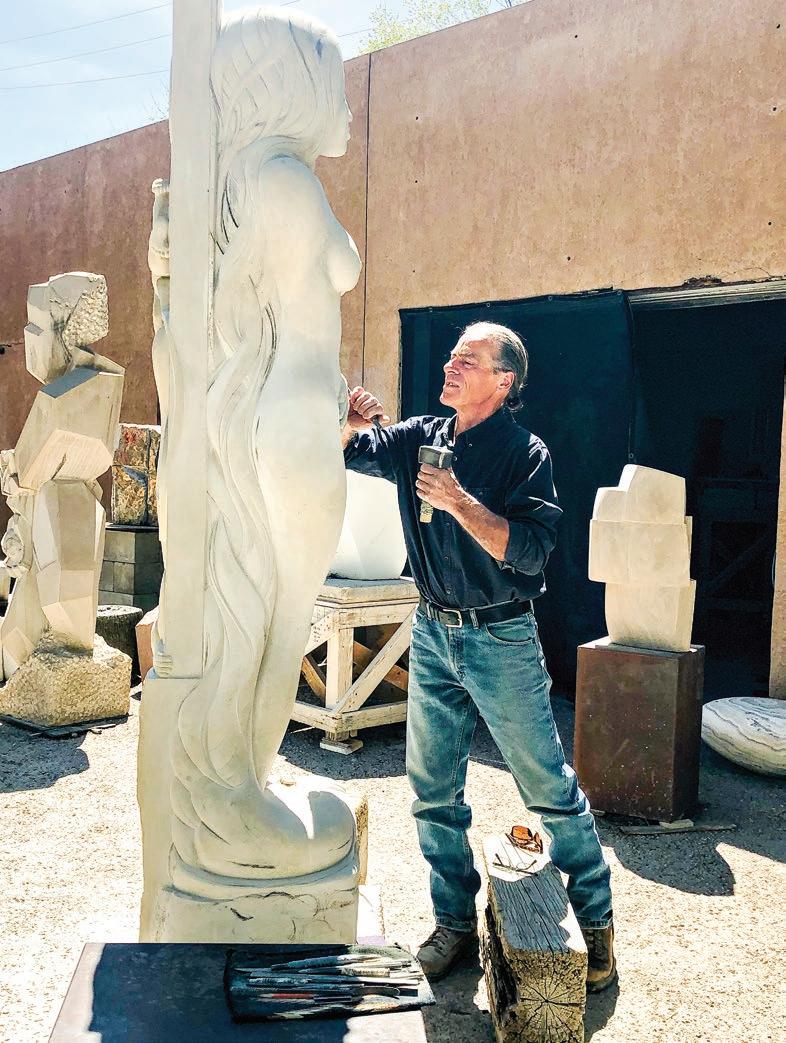 Miracle of Life and Death, 90”x23”x22”, Texas limestone;
Bottom right: Mother and Child, 28”x23”x21”, Indiana limestone;
Bottom left: Work in progress, 85”x12”x12”, Indiana limestone
Miracle of Life and Death, 90”x23”x22”, Texas limestone;
Bottom right: Mother and Child, 28”x23”x21”, Indiana limestone;
Bottom left: Work in progress, 85”x12”x12”, Indiana limestone
destefanosculpture.com | 505.670.2381 | Santa Fe ADVERTISEMENT
sculpts
stone imagined through vision, form, and honesty.
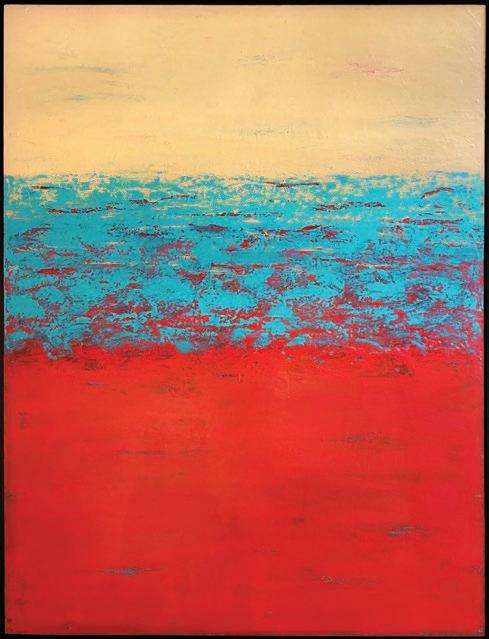
‘Southwestscape 3’ 36” x 48” www.marystrattonart.com marystrattonart@aol.com 575-770-0760 • 102 Dona Luz, Taos, NM 87571 (West of the Taos Plaza) Also represented by Royal Street Fine Art • Aspen, Colorado
Q uartet
A photographer and four area artists make beautiful music in the studio
 BY GUSSIE FAUNTLEROY PHOTOGRAPHY BY AUDREY DERELL FOR TREND
BY GUSSIE FAUNTLEROY PHOTOGRAPHY BY AUDREY DERELL FOR TREND
What sparks the creative process? We think of an artist looking around at the world or inward in reflection and feeling inspired to produce something. But just as often, the tools, media, and the artmaking itself become the engine. Even the studio space can be part of the equation, perhaps filled with bits and pieces, and odds and ends that work their way into art. Or it can be spare but well designed, stocked with all the tools for encouraging the creative flow. Wherever they work, artists are wired to use whatever they have at hand in the moment to translate materials and techniques into color, movement, and form.

Photographer Audrey Derell spent time with four Santa Fe-area artists exploring their lives and art. At different stages in their careers and working in a variety of media and styles—from animal assemblages to mural painting—the four have little in common. All were born in or drawn to Northern New Mexico. And all say that when they make art, they shift between following intuition and intentionally harnessing artistic knowledge and skills. Yet what emerges for each artist is magically unpredictable in its distinctive way.
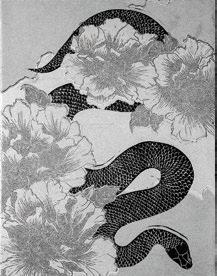
 Clockwise, from top left: Michael McCabe, Conor Flynn (2021), monotype portrait on archival paper; Geoffrey Gorman, The Rust King and Queen (2016), mixed media and found objects; Estrella Encinias, Only One (2021), archival relief print; Shakti Kroopkin, Menagerie Escapes (2022), sumi ink on archival paper.
Clockwise, from top left: Michael McCabe, Conor Flynn (2021), monotype portrait on archival paper; Geoffrey Gorman, The Rust King and Queen (2016), mixed media and found objects; Estrella Encinias, Only One (2021), archival relief print; Shakti Kroopkin, Menagerie Escapes (2022), sumi ink on archival paper.
170 TREND art + design + culture 2023




171 trendmagazineglobal.com
171 trendmagazineglobal.com
Four artists, four media and methods, and four distinctive kinds of art. Clockwise, from top left: Estrella Encinias in her studio, Las Vegas, New Mexico; Geoffrey Gorman in his studio, Santa Fe, New Mexico; Michael McCabe displays his Raven Letter (2022), monotype with Chine collé on archival paper; Shakti Kroopkin paints en plein air in Cerrillos, New Mexico, in 2022.
Michael McCabe
Years after graduating from the Institute of American Indian Arts in Santa Fe, Michael McCabe ran into his first printmaking instructor. McCabe asked his teacher why he had waited until his students were at the highest level of printmaking before teaching them monotype, which produces one-of-a-kind prints on a smooth, nonabsorbent surface. His reply: If students learned monotype in the first semester, they’d be so enamored with it that they wouldn’t want to learn anything else.
In McCabe’s case, that’s probably true. For almost 40 years he has been exploring monotype, all in his expressive style. Much of his focus has been viscosity printmaking, which allows the printing of multiple colors on a single plate. After learning it in 1986, McCabe pushed the technique into ever-changing combinations of inks, materials, and methods. Moving confidently in his neatly laid out studio, he enjoys the tactile feeling of mixing inks and rolling them out, not too thin or too thick.
He also delights in teaching workshops and classes. As a master printmaker living in Santa Fe since 1973, he has printed the works of acclaimed artists, including Forrest Moses, Jaune Quick-to-See Smith, Emmi Whitehorse, and Edgar Heap of Birds.
Born in Fort Defiance, Arizona, on the Navajo Nation and
raised in Las Vegas, Nevada, and Santa Fe, McCabe held his culture close as a young man. While he was inspired by artists in his family and encouraged by art teachers who recognized his talent, his strongest early artistic influences were abstract painters like Cy Twombly and Robert Motherwell.
Then, a few years ago, a relative searching through government archives found the only known photograph of McCabe’s nomadic great-grandfather. The printmaker now includes the photo in his layered, collaged works, along with such elements as raven imagery, Asian calligraphy, and parts of circa-1800s handwritten letters and cast-off papers. “I’m putting my greatgrandfather in environments he would never have seen in his life, like taking him on trips,” he says.
The viscosity process allows the collaged items to show through two to four thin layers of colored inks, all printed in a single pulling. McCabe uses inks with diverse properties, including some that resist or attract one another; different papers; and a variety of plates, with copper, aluminum, and plexiglass among them.
“I can plan, but there’s also a margin for unexpected outcomes, which is one of the great things about it,” he says. “It’s always a surprise and there’s always something new.”

172 TREND art + design + culture 2023

173 trendmagazineglobal.com
McCabe at work in his Santa Fe studio taking printmaking in striking new directions.
Opposite: McCabe’s mastery with one-of-a-kind monotype printing is reflected in this 2022 untitled work with Chine collé.
Michael McCabe died on April 3 of this year, just a few months after he was interviewed and photographed for this article. He will be deeply missed by family, friends, students, and art lovers in Santa Fe and beyond.
Geoffrey Gorman
The space in and around Geoffrey Gorman’s Santa Fe studio is crowded with mostly castoffs—rusty metal, inner tubes, wire, pieces of canvas, bundles of sticks—which he has been assembling and transforming into enigmatic and oddly compelling animal figures for almost 20 years.

Yet one material—wood—has been at the heart of Gorman’s creative life since his childhood. Growing up in rural Maryland, he explored woodlands, played in chestnut log barns, and, whenever he had paper or canvas, drew and painted trees. “I absolutely love wood. In a past life, I’m guessing I was a tree,” he jokes. Along with art studies at the Maryland Institute of Art, the Boston Museum School, and Franklin College in Switzerland, Gorman attended furniture making school in Vermont.
Decades later in his studio, he combines materials in ingenious ways. Unlike found-object art in which the identity of the original parts remains clear, these materials are deftly transmogrified—bike tire rubber carved into an antelope’s hoof or a half-covered penny as an anteater’s heavy-lidded eye.
Gorman also produces some pieces entirely in wood, including carved birds inspired by early species collections—
birds killed and labeled by ornithologists in the name of science. “I’ve been thinking about the duality of beauty and death. You open a drawer of bird specimens and they’re very beautiful, but it’s also very morbid,” he says.
Part of the beauty in Gorman’s carved wood art is its surface quality—rich colors, distressed finishes, or an almost ceramic-like polished luster. While much of his art is freestanding, he also produces wall-mounted works, including a series of wooden, fanned-out bird wings. Datura, which resembles wings and is part of the series, followed a rafting trip on the San Juan River in Utah. On his journey Gorman was captivated by the datura flower’s beautifully stark shape and deadly poisonous aspect—the intertwined existence of beauty and death.
Having spent time in southeastern Alaska, he has long been fascinated by whales. But it took him 17 years to gain the confidence to carve the seemingly simple-shaped creature. Then a neighbor’s gift of a large piece of apricot wood coincided with his sense of readiness, and a series of tabletop-scale carved whales emerged. He smiles. “That’s the serendipitous life of an artist,” he says.
174 TREND art + design + culture 2023




175 trendmagazineglobal.com
In Gorman’s hands found objects and mixed media become marvelous creatures. Clockwise, from top left: Hove Lands (2019); collage of the artist’s hands and tools; Diving Deeper (2018); Little Anteater (2020).
Opposite: Gorman surveys his quizzical multimedia menagerie.
Shakti Kroopkin
In Hinduism, Shakti represents primordial cosmic energy. The name, given to Shakti Kroopkin (she/they) 25 years ago by a dear friend, suits her well. A sense of underlying creative energy and musical rhythm animates her paintings, produced in oils or sumi ink.
Kroopkin grew up on Chicago’s South Side and graduated from the School of the Art Institute of Chicago in 1998.
She still remembers the moment she fell in love with abstraction. As an art student, she was using a palette knife to paint a cityscape when her professor suggested she take a two-inch square of the image and enlarge it to make it the entire painting. Which, of course, instantly transformed it from representational to abstract—and swung open a door in Kroopkin’s mind. “It was one of those never-going-back moments. There was so much joy and curiosity in the sensation of wonder, letting the mind go and the eyes flow,” she says.
Following graduation, Kroopkin lived for three years in a Volkswagen van, traveling around the United States with the goal of shedding her South Side upbringing and experiencing “what life is really about.” She returned to Chicago and taught art in inner-city schools, and in 2005 settled in New Mexico, where the urban imagery of her past merged with inspiration from the Southwest’s vast landscape and sky.
Today the artist lives south of Santa Fe near Cerrillos with her son, Malachi, two dogs, and chickens. In December 2022 she opened Mad Contemporary Gallery and Art Center in nearby Madrid.
When Kroopkin sets out to make art, she lets her energy flow between spontaneous, feeling-led expression and a more intentional approach that taps her compositional knowledge. She often uses oil stick, ebony pencil, and etching as additive and subtractive tools. Increasingly drawn to multiple media and collaboration with other artists, she delights in exploring new creative paths. “There are no mistakes; there is only progress,” she says. “I just keep pushing through and asking questions and seeing what works.”

176 TREND art + design + culture 2023
Kroopkin wears her art as a dress, 2022.



177 trendmagazineglobal.com
Internal energy flows when Kroopkin picks up a brush. Clockwise, from top: Leans In/Listen (2022), acrylic on panel mural in the Santa Fe Railyard district; Kroopkin painting a new mural in 2022; Dreaming in the Chrysalis (2022), oil on canvas.
Estrella Encinias
Estrella Encinias is just in her early 20s with a newminted BFA in painting from New Mexico Highlands University. But it’s already abundantly clear that she is an artist. She already carries a rich trove of influences and experiences to draw from in making art, including a musical father and a mother who liked to take things apart and put them back together to see how they worked.

Because her father was a park ranger, Encinias grew up in beautiful Villanueva State Park, southwest of Las Vegas, where the cottonwood-lined Pecos River winds beneath sandstone cliffs. Her young life was full of animals—softshell turtles and fish in the river, snakes, and the family’s dogs. The small Spanish Colonial village of Villanueva was just up the road and the park provided places to gather for extended family and friends, with New Mexican food and local musicians.
At college in Las Vegas, Encinias had strong support from the Highlands art faculty and generous studio space with a virtual candy box of materials. She tried them all: painting in oils, acrylics, and watercolor; ceramics; sculpture; jewelry-making; and printmaking in woodblock, etching, and lithography. For now, with a small artmaking space in her Las Vegas home, she focuses on painting. But her ideal studio: “Oh my gosh,” she says. “It would be big enough to work in all mediums.”
Animals have made their way into Encinias’s art, including Asian-influenced woodblock prints of koi fish featured in the 2020 Highlands University virtual art exhibition, Between the Lights. More recently, her large-scale oil portrait, I’ll Always Love You, was featured in the 9th Annual New Mexico Painters’ Exhibition at Highlands. The classically posed young man holding out a flower reflects her use of paint to express emotion. He is “sad because he’s heartbroken,” the artist says. “Men don’t always express. They just go it alone. This is in support and love for men out there who are struggling.”

Warm and thoughtful, Encinias sparkles with the excitement of being at the beginning of her artistic career with multiple potential directions ahead. She enjoys working quickly in acrylics to jumpstart ideas, switching to oils for the final painting.
Lately she has been exploring surrealism for conveying difficult-to-communicate experiences—like the pressure of ocular migraines depicted as eyes floating in a fishbowl. Still, most of her art suggests joy through nature imagery and vibrant colors. And she finds relaxation in the artmaking itself. “My expression just flows out through my fingertips and straight onto the medium,” she says, adding, “I just want to try it all.” R
178 TREND art + design + culture 2023

179 trendmagazineglobal.com
Encinias, a gifted, young artist, experiments. Koi (2022), print relief on archival paper. Opposite, from left: Encinias at work; Cosmic Harmony Ouroboros (2022), lithograph with gold leaf and recycled material.

ABIQUIU Lake Abiquiu Frozen in February photo by gerd j. kunde, analog - capture.com abiquiuguide.org | abiquiustudiotour.org | abiquiunews.com


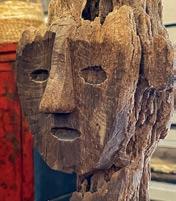
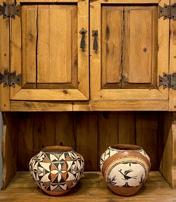
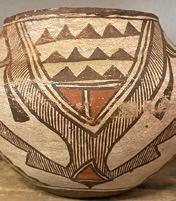
bosshard Art • Antiques • Furnishings 35 Years of the Best from Around the World and the Southwest Abiquiu, NM • Up the Hill • Next to O’Keeffe 10–5 Every Day • (505) 685-0061
JIM WOODSON

Above: Rising Entropic Predictions, oil on canvas, 36” x 48”, 2023; exterior of gallery Opposite counterclockwise: Entropic Rising Predictions, oil on canvas, 30” x 30”, 2023; Entangled Entropic Enfoldments, oil on canvas, 36” x 36”, 2023; Descending Entropic Transitions, oil on canvas, 36” x 48”, 2023
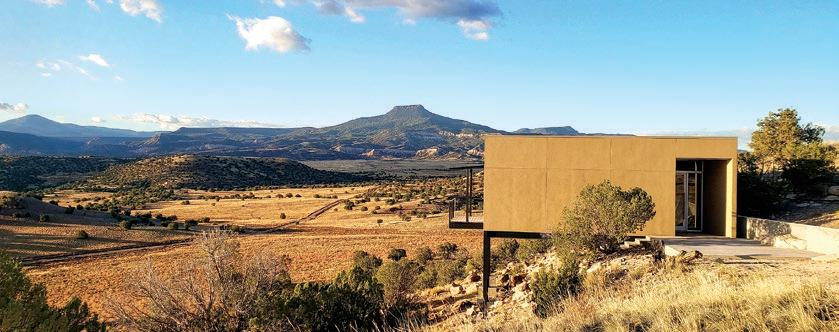
182 TREND art + design + culture 2023



183 trendmagazineglobal.com jimwoodsonart.com jimwoodsonart@gmail.com | 505-929-7489 | studio visits by appointment | Jim Woodson - vimeo.com/435924503 ADVERTISEMENT




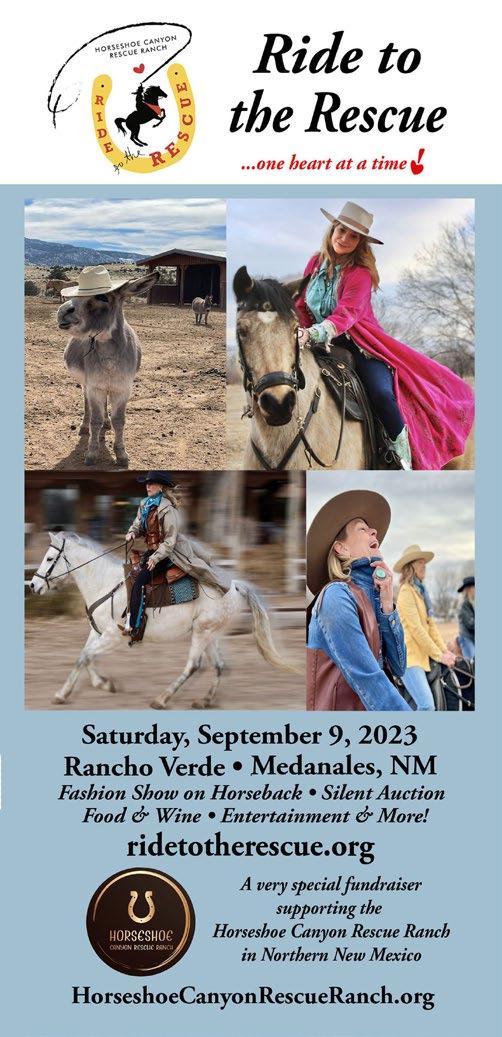
nest a collection of inspirational ARTISAN CREATED WORKS cla y .glass.wood.fibe 1 C ounty R d 166 Abiquiu NM 87510 abiquiunest.com for directions and hours Instagram @abiquiunest
HEBÉ GARCÍA FINE ARTS

Hebé García, a painter and sculptor from Puerto Rico, has been living and working in Abiquiu since 2015. She studied painting and etching at Louisiana State University, graduating cum laude with a BA in Fine Arts, before returning to Puerto Rico to begin her career as a painter. “I have painted all my life,” she says, “and that was what I became known for in the Puerto Rican art world; clay was something I was drawn to explore later on.”
In 2013 she and her husband visited Abiquiu for the first time. “I had never been to New Mexico and immediately felt at home here,” she recalls. Two years later, she and her husband moved to Abiquiu, building a house and studio on top of a scenic mesa with stunning 360-degree views. “We love it here,” she says. “The multicultural society is very much like Puerto Rico, and the artistic community has been welcoming and supportive—and, of course, the landscape is stunning and inspiring.”
Focusing on aspects of our human life journey is central to García’s work in her painting and sculpture. She specializes in series of works around a single theme with such simple titles as The Walk, The March, or The Conversation. “I use that as a teaser to draw people in,” she explains. “Everyone interprets art based on their own experiences. People see what they see, and I’m always encouraging people to look more deeply into each piece to find their own story.”
185 trendmagazineglobal.com
hebegarcia.com | 52 Corona Rd, Abiquiu, NM 87510 | by appointment only | 505-690-9888
ADVERTISEMENT
And I Stood Still in Your Silence, oil on Ampersand Gessobord, 24” x 24”, 2023
HEBÉ GARCÍA FINE ARTS

Her painting and sculpture highlight texture and form. They feature mainly female figures. That, she believes, is because she comes from a family of formidable women. “My grandmother was one of the first women professors at the University of Puerto Rico, who also played the piano, made clothes, and painted a bit. I also have three older sisters, and now I have two daughters as well.” She says her family is always present in her artwork; a group of four women represents herself and three sisters; her mother would be the fifth.
“I feel that my work has evolved since moving here,” she says. “It’s stronger, more mystical maybe, exploring themes of identity, culture, [and] psyche, weaving together stories that drift between real and unreal. I hope it encourages people to look for light, to find peace and the strength to keep going whatever the circumstances.”
Hebé García’s work is on permanent display at NOSA Inn in Ojo Caliente and Nest Gallery Shop and Showroom in Abiquiu. She has a solo show opening at the Abiquiu Inn at the beginning of August that will run through September.
186 TREND art + design + culture 2023
Bee KIND; sculptural clay, engobe, oxide and underglaze; 12” x 33” x 9”; 2023
Thoughts



187 trendmagazineglobal.com ADVERTISEMENT
Clockwise from top left: Work in Process, oil on Ambersand Gessobord, 24” x 24”, 2023
& Memories Container No 4_Detail; sculptural clay, engobe, oxide and underglaze; 13.5” x 7.5” x 7”; 2022
Solo Guardo Recuerdos Tuyos; sculptural clay, engobe, oxide and underglaze; 17” x 6” x 6”; 2022
Jim Baker is a mixed-media New Mexico artist with a unique field of expertise. He takes antique Bibles from around the world and transforms them into devotional pieces of art. Some are combined with ancient religious artifacts, crosses, clay sculptures, and spiritual symbols, transforming them into sacred works that can be passed down from generation to generation.

Baker’s vision was inspired by his years as a pastor, during which time he became interested in collecting old Bibles. “I ended up with a vast trove of them, gathered from estate sales, flea markets, garage sales, in many different languages and varying states of disrepair,” he says. “It occurred to me to give them a new life and a new purpose by turning them into enduring pieces of art.”
Baker is completely self-taught, except for taking some classes in bookbinding and working with clay. His technique involves carefully separating the pages of each worn and weathered Bible and sewing them back together with an ancient Ethiopian Coptic stitching. “My inspiration comes from the word ‘religion,’ derived from the Latin ‘re-ligio,’ meaning to rebind,” he says. “It is used in Scripture to reflect God’s desire to reconnect us to Him, to our true selves, and to others.”
Baker’s artworks can be found in the collections of religious institutions, universities, hospitals, and churches, as well as galleries, homes, and businesses. He also accepts commissions from people with old family Bibles who would like to preserve them as heirlooms by turning them into pieces of sacred art. You are invited to visit Jim’s home studio and gallery, just a few miles from scenic Abiquiu, NM. Personal tours are available by appointment.
188 TREND art + design + culture 2023
sacredstructuresart.com | Medanales, New Mexico | 505-685-4851 | jim@sacredsructures.org
JIM BAKER
Jim Baker in his studio
Clockwise, from top left: The Great Physician, mixed media, 18” x 24” x 4”
Making a Difference in Two Worlds, mixed media, 20” x 30” x 5”
Come Unto Me, mixed media, 21” x 30” x 6”
Seraphym Sacred Art Gallery I Santa Fe, NM 833-HOLYART I seraphym.com



Benedictine Monks of Taos Gift Shop, Taos, NM 575-751-8531 I benedictinemonksoftaos.org
Jemez Fine Art Gallery I Jemez Springs, NM 575-829-3340 I jemezfineart.com
ADVERTISEMENT
In the Garden
A miraculous suite of art photos grounded in the nurture and intimate observation of a wild and wonderful New Mexico Garden
 BY LUCY R. LIPPARD | PHOTOGRAPHY BY NANCY SUTOR AND LONNIE SCHLEIN
BY LUCY R. LIPPARD | PHOTOGRAPHY BY NANCY SUTOR AND LONNIE SCHLEIN
190 TREND art + design + culture 2023
The garden that inspires most of Nancy Sutor’s art is wild and comforting in its rambling beauty. The art that it has inspired is more complex. While the garden appears to have its own way, the photographs/art are clearly made by a very skilled hand. If you like cut flowers in your house, move on up to these stunning images that will last a lot longer.
Sutor’s latest work bypasses realism, although its manipulated subjects are always recognizable in their dazzling variety: the delicacy of grasses and pine needles, icicles, sensuous closeups of plump petals, snow on bare branches and on green leaves, brilliant autumn reds, oranges, yellows, and pinks, bright berries, vegetables, fat and fuzzy succulents—a celebratory succession of gifts from the garden.
Everything Sutor makes is, to some extent, a measure of time, but not necessarily linear time. She cites the Greek concepts of Chronos (our clocks) and Kairos (natural time, as in seasons). The latter, of course, operates within the natu-
ral cycles surrounding and underlying us, however often we demean and attack them. Circles and their offspring are prominent in her new work, expressing both transformation and permanence. The spirit of the seasonal growth and decay is, at its heart, from flowers, herbs, shrubs, and trees to compost.
For years Sutor has self-imposed the rule that all her images must emerge from this patch of property, this “wild” garden. Even the remains of an old fence have a place in her recent work. The queen of her realm is a handsome mature apple tree that she describes as her shelter and her muse, especially when she was recovering from a car accident, cycling back to normalcy. In Illuminated Apple Tree, images of branches and the tree form are photographed through a scrim, more and less abstracted in translucent monochrome, mounted on birch panels, and hung in groups, suggesting the way blossoms cluster on a branch.
Thus, place plays a dominant role in this work, perhaps imperceptible to the viewer but literally underlying

191 trendmagazineglobal.com
Sutor’s light-filled studio with installations of two recent series, Moon Flowers and Second Nature (2022-2023). Opposite: Sutor’s garden contains many grasses, which provide shelter for wildlife, food for birds, and beauty in every season. Here, the artist prepares to divide Pink Muhly grass (photos by Lonnie Schlein).
everything, like the actual and figurative soil in which her art germinates and proceeds through life and death.

The garden is the artist’s most intimate domain, but her rooted world extends to Agua Fria Village, where she has lived since 1991 with her husband, Rosario Provenza, an art director and production designer, and to Reunity Resources, a regenerative farm where she is on the advisory board. Ruins and the past are integral, if usually invisible, elements of the present in New Mexico. Another part of Sutor’s world is the nearby remains of Pindi Pueblo (1150-1400), one of the earliest Ancestral Pueblo communities in the area.
Pre-Europeans tended to picture food sources and medicinal herbs often abstractly, but flowers have been a prime subject of Western art since its Europeanization for the same reasons that Sutor’s glorious blossoms attract us in their altered forms. Her work is a classic example of collaboration between nature and culture. The borders between the two become ambiguous.
She was 16 years old in 1970 at the advent of Earth Day, and it sparked a lifelong obsession with observing the world and how it was organized before humankind got a stranglehold on it. One of her photographic series, called Second Nature, reflects the ways in which our gardens and parks imitate and alter nature, since we are all too often threatened by nature in the raw.
Despite her decision in the early 1970s to forgo objects
in favor of environmental activism, objects and images prevailed, albeit in new forms, while she lived the hippie life in southern New Mexico. In 1996, Sutor and artist Chris Cardinale led the Refuse Vehicle Mural Project, a collaborative campaign to “decorate” Santa Fe’s garbage trucks. They turned them into mobile art shows featuring bugs, abstractions, and, most importantly, portraits of the workers—a worthy successor to Mierle Laderman Ukeles’ groundbreaking work with the New York City Department of Sanitation. Sutor was quoted at the time in the Albuquerque Journal: “Trash is definitely an artistic resource,” precursing by decades her current compost series, Compose Decompose
In the process of living within her garden, Sutor has come to see decay as compelling as growth and blooms. Compost, too, varies, depending on the season. An unexpected recent addition is pieces of her father’s old, plaid wool shirt, woven and sewn by her grandmother. Where most of us treasure inherited objects on display in our interiors, Sutor introduces the material of family history to its source in nature. The wool is cut into squares and planted in the compost, where it merges with more perishable food and materials even as it absorbs the soil, changes colors, and eventually disintegrates.
Nature is not timeless, but it evades clock time with its own temporality. Artists from Vivaldi to Sutor have cele -
 From left: October 26, 2022 (with asters), archival pigment print, from the series Moon Flowers. The dates are the titles of these ritual compositions made using plants, water, and objects to commemorate full moons and other significant events. Karl Foerster reed grass at the garden fountain, where birds and insects find habitat, feed, and water (photo by Lonnie Schlein).
From left: October 26, 2022 (with asters), archival pigment print, from the series Moon Flowers. The dates are the titles of these ritual compositions made using plants, water, and objects to commemorate full moons and other significant events. Karl Foerster reed grass at the garden fountain, where birds and insects find habitat, feed, and water (photo by Lonnie Schlein).
192 TREND art + design + culture 2023
brated the seasons. It’s harder today as climate chaos mixes up things, forcing wildlife and vegetation to flee or perish. The phases of the moon are probably the natural cycle most familiar to us, and the moon is a major player in one of Sutor’s series. In Moon Flowers, circles reappear in the unobtrusive round bowls in which flowers are nested. The fact that the moon’s cycles are related to different brain chemicals seems to have been understood intuitively by indigenous societies who adopted practices about the right time to do anything, such as planting seeds at the new moon.

I last wrote on Sutor’s art some 20 years ago, when the photograms/cyanotypes she called “my beloved non-
silver photographic processes” reversed figure and ground, negative and positive, presence and absence, stillness and movement, confusing our assumptions about photography itself. The photograms were almost monochromatic, with varying tones. And like the recent work, they reversed the ways we see. The current images burst with color, a much brighter palette; celebratory icons, they glow and simmer with reality even as they are manipulated in almost imperceptible mirror images, folding in upon themselves to create new incarnations.
If you are someone who likes to read clouds (hey, that looks like a dog!) you will have even more fun with
193 trendmagazineglobal.com
February 6, 2023 (with egg), archival pigment print, from the series, Moon Flowers


194 TREND art + design + culture 2023

195 trendmagazineglobal.com
Golden Ray sunflowers in front of the studio. Opposite, from top: Sutor holds a toned cyanotype photogram from the series, Absence/Presence. On the wall is a work from the series, Illuminated Apple Tree (photo by Lonnie Schlein); milkweed, sunflowers, and cosmos (photo by Lonnie Schlein).
July 9, 2022 (with rainbow chard), archival pigment print, from the series, Second Nature

196 TREND art + design + culture 2023

197 trendmagazineglobal.com
The prolific peach tree in artist Sutor’s garden as the sun sets over the Sangre de Cristo Mountains. This well-loved tree is watered with rainwater collected in several cisterns on the property and produces bushels of fruit each August.
Clockwise, from top: September 9, 2022 (with domino and marigold), from the series, Moon Flowers; December 12, 2022 (with grasses); December 17, 2022 (with hawthorn berries). Both are transformative images of plants through the seasons from the series, Second Nature.



198 TREND art + design + culture 2023
these bouquets. Faces, ominous masks, vulvic suggestions, appear and disappear. Shadows play a role as memento mori, loss and rebirth, inherent in watching nature move through the year.

Long a science aficionado, Sutor worked at the New Mexico Museum of Space History in Alamogordo in the 1970s. One of her past series is called Who Owns Science? These days she is fascinated by neurobiology, which partly explains why her images are so effective; she intuitively understands our unnoticed needs and desires. The conventional five senses (taste, smell, vision, hearing, and
touch) have been expanded to a possible 33, including equilibrioception (balance) and proprioception that helps us understand where we are in space and chronoception (the passing of time). (This is all news to me.) A recent study revealed the therapeutic mechanisms of fresh flower arrangement, which has proved to reduce negative emotions, especially in young women, as well as increasing concentration and relaxation in older adults. (Another reason to have a Sutor in your house.) Nature, even when transformed as it is in her art, can challenge and confuse and also heal with light and time. R
199 trendmagazineglobal.com
April 15, 2022 (with daffodils) from the Moon Flowers series. What is available in the garden always changes, telling the story of the seasons, the weather, and even the artist’s life.
TRANSFORMING THE HOME
Fine Cabinetry • Renovations

505-992-8382
dmaahsconstruction.com
Showroom by Appointment
1570 Pacheco St. Suite C-1
DESIGNsource
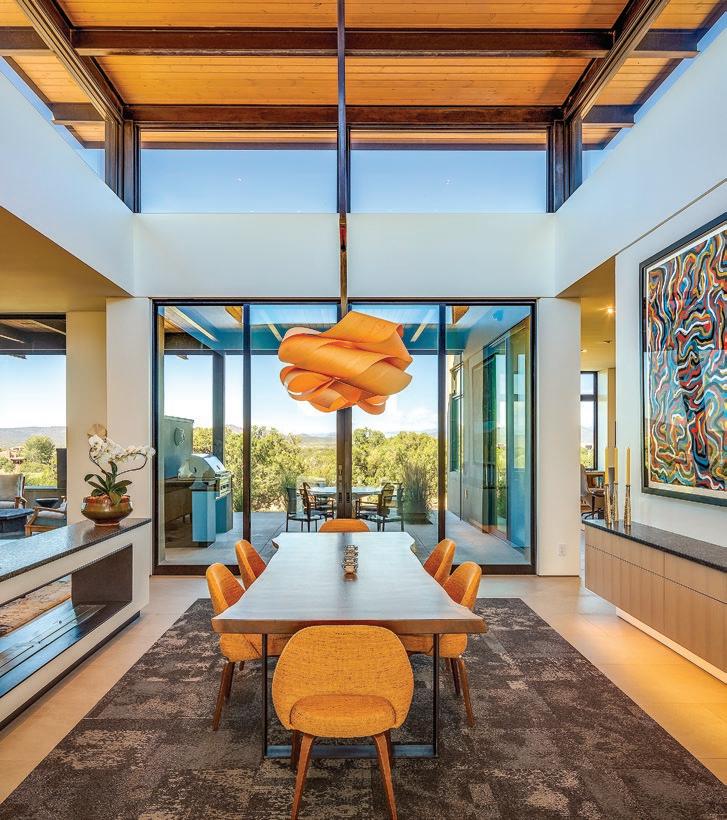

Inspired partnerships inform Santa Fe’s built environment SPECIAL DESIGN SECTION trendmagazineglobal.com 201
The airy dining room at the Torcasso residence in Santa Fe, designed by Larry Speck in 2012 (photo by Robert Reck).
RESIDE HOME
A FULL-SERVICE INTERIOR DESIGN FIRM AND RETAIL HOME FURNISHINGS SHOWROOM
If walking into a home conveys its inhabitant’s essence, then perhaps colors, textures, and patterns are a creation of the heart. Connecting to the center of that heart through innovative design is exactly the gift that both Thea Mason and Trish Spencer of Reside Home bring to Santa Fe.
Thea and Trish create unimaginably sophisticated spaces through Reside Home, a full-service interior design firm and retail home furnishings showroom. One walk through a Reside 100-year-old Santa Fe home may upend beliefs about what masterful design can do, be, or evoke.
Decades of their integrated creativity offer stunning aesthetic balances, complements, contrasts, and cohesion. Trish loves the feeling and energy that rich color awakens. Thea appreciates the serenity and the possibilities that clean spaces allow. Whether a space is a crafted through a paintbox of color or subtle sophistication, the discovery of finding the most honestly expressed version of their clients’ individuality is what gives Reside Home—and Trish and Thea’s interior design services— purpose and joy.

202 TREND art + design + culture 2023


1233 Paseo de Peralta | Santa Fe | 505-780-5658 | howyoureside.com ADVERTISEMENT 203 trendmagazineglobal.com


A cultural experience you won’t want to miss Offering a unique collection of imports from around the world, including rugs, pottery, home decor, architectural elements, custom furniture, and much more! 345 Camino del Monte Sol Santa Fe, NM 87505 (505)986-0340 Santakilim.com shop@santakilim.com

HOOPES+ASSOCIATES ARCHITECTS 505.986.1010 | HoopesArchitects.com | 333 Montezuma Avenue Santa Fe, NM 87501 | studio@hoopesarchitects.com WELCOME HOME.
Robert Reck and the Rise of Southwest Regional Modernism
A master photographer and architectural historian help us understand how old adobe evolved into some of the most striking contemporary architecture in the West

206 TREND art + design + culture 2023
BY ELMO BACA PHOTOGRAPHY BY ROBERT RECK
Robert Reck has enjoyed several decades of success and renown as one of the Southwest’s preeminent architectural photographers. During this time, Reck’s keen eye and lens have recorded a remarkable transition in New Mexico building arts and tradition as well as in photography itself. As the ancient and historic use of adobe in New Mexico has diminished, the techniques of film and darkroom photography have yielded to digital cameras and computer imaging technology.
About 50 years ago, New Mexico and other western states began to experience dramatic increases in migration and population that would transform urban centers such as Albuquerque and Santa Fe, introduce suburbanization to a state proud of its rural community lifestyles, and import modernist aesthetics to New Mexican architecture and interior design.
Modernism, the essential theme of Reck’s photo suite, is a 20th-century style and lifestyle philosophy that was slow to blossom in New Mexico, first arriving by the 1920s with iconic artists such as Georgia O’Keeffe and John Marin,
writers such as D. H. Lawrence and Willa Cather, and tastemakers such as Mabel Dodge Luhan. In architecture, the sleek Minimalism beloved by modernists had to contend with an old and beloved adobe building tradition that stood the test of time, colonialism, and the elements.

These same early modernists were quick to appreciate the malleability of New Mexico’s unique aesthetics to modernist concepts and trends, especially the affinity of adobe architecture to Cubism, the naked power of the dramatic and exotic landscape, and the rich, sometimes abstract cultural expressions manifested in the area’s deep Indigenous and Hispanic folk arts.
The art of architectural photography in New Mexico is, of course, heavily influenced by Ansel Adams. His astounding 1930s images of Taos churches and Taos Pueblo, as well as the unforgettable Moonrise Over Hernandez, NM, radiated with a love of sunbaked mud textures, infinite cloud-filled skies, and the dramatic effects of natural lighting. The solitary building in the vast, temperamental landscape is an Ansel Adams trope that Reck has utilized to great effect in his career.
207 trendmagazineglobal.com
Dramatic inside-outside contrasts at the Eddie Jones-designed Reimers residence (Missoula, Montana, 2011). Opposite: The house displays a sampling of the new materials, including reinforced concrete and Corten Steel, that are used in some of New Mexico’s modernist architecture.
The transition from Pueblo architecture to Spanish Colonial residential and religious forms and the AngloAmerican Territorial style in the 19th century introduced many innovations, but the essential elements of adobe’s massive minimalist walls and restrained window and door openings has endured. Architect John Gaw Meem became a master at adapting the ancient adobe forms in the 1930s and 1940s to modern materials, and his techniques influenced a generation of designers after World War II.
Sadly, earthen architecture in New Mexico has declined within the past 50 years as labor costs, material technologies, and stylistic and lifestyle preferences (large kitchens and bathrooms, for example) have favored more regional modernist design aesthetics. Adobe bricks have yielded to gypsum board or poured concrete. Wooden door frames and lintels have been replaced by structural steel. And modern glass in generous expanses provides daylighting
and views of nature and city much more generous than ever before.
Besides adobe, rubble-stone masonry was utilized to awesome, monumental effect by Ancestral Puebloan builders at sites such as Chaco Canyon. The rustic rubble masonry vernacular style is also common in Northern New Mexico, especially in utility buildings such as barns and stables.
In a dramatic new Santa Fe residence by architect Timothy V. Blonkvist of Overland Partners, precisely fitted sandstone walls contrast beautifully with brushed stainless steel, gleaming against a cerulean sky. Reck’s masterful twilight composition of the Blonkvist house showcases the enchanting lighting effects of the “neo-farolito” lanterns in the xeriscaped garden.
Another image of a residence in Missoula, Montana, designed by Eddie Jones, illustrates the new palette of materials that is transforming contemporary architecture

208 TREND art + design + culture 2023
In his Torcasso residence (Santa Fe, New Mexico, 2012), Larry Speck exploits the cube to achieve Zen-like quietude and harmony.


209 trendmagazineglobal.com
A bedroom in Speck’s Torcasso residence is backed by a toned concrete wall that evokes the subtly colored New Mexico landscape. Top: The Torcasso living room is understated, except for its massive, many-colored, stunningly modernist fireplace.


210 TREND art + design + culture 2023

211 trendmagazineglobal.com
Clockwise, from top left: The fitted sandstone entrance to the Davis house (Santa Fe, New Mexico, 2009) designed by Timothy V. Blonkvist; Reck’s image of the Davis house at night demonstrates how he uses lighting to its best effect; the exquisite reflecting pool at the Story residence (Keerville, Texas, 2013), designed by Brian Korte.


212 TREND art + design + culture 2023


213 trendmagazineglobal.com
Clockwise, from top: A wide-angle view of Terry Kilbane’s DiCarlo house (Santa Fe, New Mexico, 2011); looking up to the second floor from the entrance of the Student Union Building at New Mexico Highlands University (Las Vegas, New Mexico, 2013) designed by Diamond Schmitt Architects and Studio Southwest Architects; the living room at Blonkvist’s Davis residence in Santa Fe.
in the West. The sculptural plasticity and rustic textural finish of reinforced concrete nicely enhances rusting Corten Steel in a multilevel house, which offers a counterpoint to the surrounding landscape. A stunning Reck perspective of an angular hallway captures the do-si-do of ethereal green grass and timber and the imposing gravity of tile and concrete.
The photographer also shows us how architect Larry Speck exploits precise harmonies of cubical geometry in the spectacular Torcasso residence overlooking Santa Fe. The perfect form of the cube provides the underlying logic and structure of the Torcasso’s interior floor plan, openings and views, furnishings, and decorative flourishes. Not only does it offer a visual counterpoint to the dramatic views beyond the glass and patio but it also creates a Zen-like ambience inside.
Reck fully exploits this creative tension with deep, focused images that evoke the ever-changing palette of New Mexico’s light, land, and sky while caressing the subtle gradations of toned concrete and wood. A brilliant view of the Torcasso living room showcases an iconic and

monumental fireplace articulated by intense chromatic cubes, a playful modernist expression in an otherwise disciplined design statement.
Diamond Schmitt Architects (DSAI) of Toronto partnered with Albuquerque’s Studio Southwest Architects to create one of Northern New Mexico’s most advanced LEED certified buildings at the Student Union Building (SUB) of New Mexico Highlands University in Las Vegas in 2013. The imposing glass and Corten Steel of the building’s exterior dominate the town’s historic Zion Hill site and surrounding neighborhoods of Victorian Queen Anne-style houses.
For lead design architect Martin Davidson of DSAI, transparency and the SUB’s relationship to the town were key. “The city is a remarkable place and this is the gateway to the university, so we developed a design language and chose materials that blend the historic and the new,” he explained. Reck’s abstracted perspective view of the SUB’s grand stairwell illuminates the central transparency theme while evoking the curvilinear earthen-colored forms sometimes seen in Spanish Colonial-era churches.
214 TREND art + design + culture 2023
The striking window-lined living room of the Davis house in Santa Fe.


215 trendmagazineglobal.com
A Craig Hoopes-designed living room (Alto, New Mexico, 2020).
Top: DiCarlo house dining room (Santa Fe, New Mexico, 2021) designed by Terry Kilbane.


216 TREND art + design + culture 2023
Glass and mirrors in a bathroom designed by Zydeco 66 (Santa Fe, New Mexico, 2021).
Top: A New Mexican ceiling lends a traditional note to the Horn residence (2011).
Through Reck’s lens we see how Zydeco 66’s richly layered and textured bathroom design also interprets transparency effects of glass and mirrors in a recent Santa Fe residence. A traditional New Mexican ceiling of vigas and latillas lends a timeless craftsmanship to the complex materials palette of marble, tile, tigerwood, and porcelain, balanced elegantly by Reck’s framing and lighting in a warm, inviting photograph.
A 1986 Reck photograph of architect Antoine Predock’s Troy House north and west of Taos, nestled in a field of sagebrush, captures some of the essence of Reck’s work in its dramatic juxtaposition of home and mountain, earth, and indigo sky.

“My initial fondness for New Mexico and fascination with the place is, I think, what has captivated others, including great scholars like Bainbridge Bunting and Chris Wilson, and designers like Antoine Predock—it’s the tricultural heritage,” Reck noted. “I’ve enjoyed seeing the evolution and transformation of adobe architecture from mud buildings to its contemporary vernacular expressions, and how the buildings still express the idea of ‘living on the land,’ a value which is dear and precious to all New Mexicans.” R

217 trendmagazineglobal.com
Robert Reck is one of the most respected architectural photographers in the US. He served for 25 years as staff photographer for Architectural Digest and has contributed to the most noted architecture magazines. His books include Santa Fe Style (Rizzoli, 1986), The Small Adobe House (Gibbs Smith, 2001), and most recently The Power of III (Trinity Properties, 2016). Top: An iconic shot of the Troy house (Taos, New Mexico, 1986) designed by Antoine Predock.






Care
❦ E xperienced field crews backed by a support team with over 100 years combined horticultural experience ❦ Preferred status for access to garden enhancements, container plantings and irrigation repair ❦ “Enhanced Service” program available if you desire a higher level of communication and regular visits with one of our garden gurus 505-983-0130 www.clemensandassociates.com Bespoke Garden Care You know the name and you know the quality... Exceptional Landscape Maintenance L OVEOURTREES SAVEOU R RETAW SEEBRUOTROPPUS Trend Mag 4.10.2023.pdf 1 4/28/2023 1:49:22 PM
Lorem ipsum











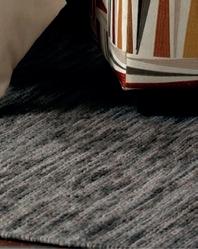
A COLLABORATION
When it comes to skill, education, and the creativity to bring imaginative spaces to life, the collaborative team (the Collaboration) of Five-Ten Architecture + Design, the Martinez Design Group, and Lisa D. Martinez Design + B Constructiv have it all. As artists, architects, designers, and contractors, our collaboration has created a design, development, and construction organization dedicated to the unique art and culture of our home, Northern New Mexico. Our interest in the natural beauty of our landscape and quality of light in the high desert is fundamental to our design roots. With an emphasis on sustainability, our designs also incorporate energy conservation measures to preserve scarce resources.
The partners of the Collaboration have a long and diverse background and are well versed in all aspects of design, development, and construction processes. With over 80 years of combined expertise and our network of consultants, we are confident our expertise places us in a unique position to support our clients as we imagine, design, and build commercial, residential, and outdoor spaces.


Our latest project, the State Employees Credit Union Mortgage and Commercial Center, will open in the spring of 2023. The design team includes the father-and-son team of Daniel J. Martinez,
Architect with Five-Ten Architecture + Design, and Co-Designer Louis Martinez of the Martinez Design Group, and Lisa D. Martinez, Co-Designer and Construction Project Manager, Lisa D. Martinez Design LLC + B Constructiv LLC. "The design collaboration between us for this beautiful project was an incredibly gratifying experience," Lisa shares.
Merging creativity with function to result in unparalleled design innovation continues to earn the Collaboration team numerous accolades and awards. In April 2023, a residential project from the Martinez Design Group and Five Ten Architecture + Design was recognized in a feature story in Su Casa magazine. In 2022, Lisa D. Martinez Design + B Constructiv won "Best Design" for the B Fit Rx Studio in the 30th Annual Santa Fe Area Homebuilder's Association Haciendas A Parade of Homes.
We've designed and built everything from the traditional Northern New Mexico-style home to the contemporary office or home, working for celebrities, CEOs of Fortune 500 companies, and our friends and families. Imagination and functionality must merge for architecture to become art. Architecture blended with construction should be a craft of expansive possibilities.


ADVERTISEMENT
505.470.7888
SPECIALIZING IN: Commercial Multifamily Custom Residential Over 80 years combined experience www.mtzarchitecture.build














Intelligence, LLC
ci4usantafe.com
Fe By Design Suite D101 505.988.4111 santafebydesign.com
PARK
Craftsmen, LLC
Window Coverings, Ltd. Suite A101 505.820.0511 cwcsantafe.com
Design Suite A104 505.983.7055 annieocarroll.com Victoria at Home Suite A103 505.365.2687 victoriaathome.com An Energized Community of Creatives One Stop for Shopping, Design Sourcing, Dining, Wellness and Much More!
Luz Artful Lighting
C203
laluzsf.com L a L uz artful lighting 1512 Pacheco St, Ste D206 • Santa Fe, NM 87505 505.780.1159 • Offi ceSpaceSantaFe.com • @ pachecoparksf Tierra Concepts, Inc. Suite D206 505.989.8484 TierraConceptsSantaFe.com Archaeo Architects Suite A105 505.820.7200 archaeoarchitects.com Stacy Nixon Contemporary Fine Art Suite D207 619.204.1632 StacyNixonArt.com
Windows & Doors Suite D107 505.474.4112 pellabranch.com
Counter
Suite C204 505.988.4007
Santa
PACHECO
H and S
Suite C204 505.988.4007 handscraftsmen.com Custom
Interior
La
Suite
505.954.1149
Pella



MAX VASHER ARCHITECT AIA unique • contemporary • architecture (505) 615 • 0696 13 MARTIN ROAD, PLACITAS, NEW MEXICO www.maxvasherarchitect.com




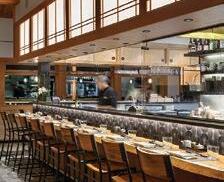






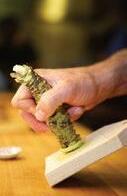



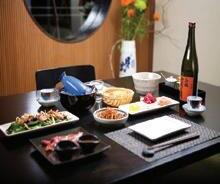





SPA reservations 505.982.9304 www.tenthousandwaves.com japanese spa & lodging SPA FOOD LODGING izanami ten thousand waves dining
Passion Palate of the NEW







MEXICO’S CULINARY INSPIRATION
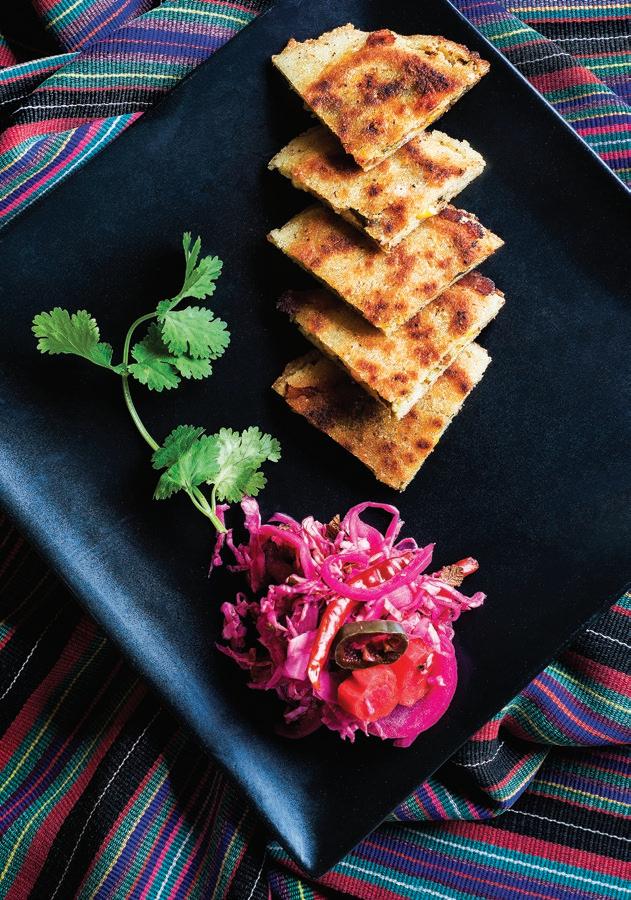
 Napo’s Pupusa appetizer at Cafe Pasqual’s is served with pickled vegetables
Napo’s Pupusa appetizer at Cafe Pasqual’s is served with pickled vegetables
trendmagazineglobal.com 225
(photo by Kitty Leaken).
Off-the-Beaten Plate
You’ve heard of the Enchanted Circle around Northern New Mexico? Very scenic. But here’s something for people who’d rather eat their way around the Sangre de Cristo Mountains.
No sane person would turn down the chance to dine at a sophisticated Santa Fe restaurant. Showcasing the distinctive new cuisine of the Southwest, they rank among the best in the country.
Sometimes, though, many of us would rather eat at more modest places that are beloved by locals, tucked out of the way along our beautiful highways and byways. One tour de table featuring such eateries starts in Las Vegas, about 60 miles northeast of Santa Fe, and ends someplace in Albuquerque, depending on where Wolf ‘n’ Swallow, a cool craft charcuterie place, pops up next.
The historic Castaneda Hotel by the train tracks in Las Vegas has a burnished old bar where a wide range of New Mexico types stop, from professors at the town’s Highlands University to cowboys from the ranch who come in to stock up at Tractor Supply. The menu is at once homey and sophisticated because of Sean Sinclair, the award-winning chef who also started the celebrated Legal Tender in Lamy. When he took over the kitchen at the Castaneda a few years back, he raised the culinary bar in Vegas by a mile. He also gave free meals to some 750 firefighters and evacuees a day at the height of last year’s devastating Calf Canyon/Hermits Peak fire.
During happy hour (3:00–5:00 p.m. Wednesday–Sunday) Sinclair’s food is as good as ever but particularly easy on the wallet. The menu changes periodi-
cally. Think sommelier-selected wine and craft beer, tasty green chile stew, crispy onion rings, and knock-out Harvey Smashburgers, each under $10. There’s no charge at all for the friends you make at the bar or hide away from in the bathroom.
Cleveland is about 35 miles north of Las Vegas along the Mora River Valley and State Road 518. Old Spanish landgrant country with cattle spreads on the endless plains to the east. It’s easy to miss Teresa’s Tamales because it looks like a shack. But no, it’s a palace where the king is hand-tied tamale, made under her mother’s tutelage since the eponymous Teresa Olivas was a girl. She started cooking for the wide world around 1990, enlisted family members to help, and the rest is local history. Finally last fall Teresa decided to sell the restaurant, fortunately to folks with longtime roots in Mora County, Amanda and Erika Regensberg and Matilda Chavez. They have pledged to retain Teresa’s original recipes while adding pastries and sweets.
You can eat in the spare front room of the restaurant, at tables out front, or take your food on the road in a plastic box. Just grab a lot of napkins because there’s nothing messier than smothered tamales, steak and/or chicken enchiladas, and BBQ pork sandwiches.
By the time you get to Taos on 518, you’ll have traversed the Sangre de Cristo Mountains and, doubtless, started thinking about something else to eat, preferably sweet. So, it’s a good thing
BY SUSAN SPANO
that Taos Cow, home of some of the best ice cream in the Southwest, is opening a new shop a little south of town. Taos was an ice cream desert until a couple of entrepreneurs, including Jamie Leeson, opened the first Taos Cow in 1993 in Arroyo Seco on the way to Taos Ski Basin. It still does big business in pre-ski bagel and burrito breakfasts, Reubens, beans and rice, and green chile stew. But, honestly, the point is ice cream made from such New Mexican delicacies as Las Cruces pecans, Alamogordo pistachios, and organic lavender from Abiquiu. When Leeson mixes them, the result is a delirium of flavors: Mexican chocolate with chocolate chunks and cinnamon; pistachio and white chocolate chunks; Coco Loco featuring coconut, piñon nuts, and more chocolate chunks. Next stop: the Blue Heron Brewery in Embudo southwest of Taos on State Road 68 and one of the most dramatic stretches of the Río Grande in New Mexico. It makes sense to work up a thirst (and appetite) by going for a hike or rafting trip in nearby Río Grande del Norte National Monument before hanging out at Blue Heron, where Scottish Ale, Ladybug IPA, and Raspberry Rye are favorites on tap. Kristin Hennelly began brewing beer in 2009 and opened this second branch of the taproom (the first is in Española) just last year. Her dad, Patrick Johnson, and uncle, Michael Johnson, started award-winning La Chiripada Winery in nearby Dixon, so there’s no run-
Passion Palate of the
226 TREND art + design + culture 2023
BAR CASTANEDA
AT THE CASTANEDA HOTEL 524 Railroad Ave., Las Vegas, NM 505-434-1005
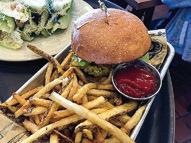
TERESA’S TAMALES 3296 NM 518, Cleveland, NM 575-387-2754


TAOS COW 485 NM 150, NM 575-776-5640
RINCONADA TAP ROOM at the Blue Heron Brewery 2214 NM 68, Embudo, NM 505-579-9188



WOLF ‘N’ SWALLOW 517-667-8355, for pop-up locations: facebook/Wolfnswallow


 Bottom, from left: Teresa’s magnificent hand-tied tamales (photo courtesy Teresa’s); pizza Margherita at the Blue Heron Brewery (photo courtesy Blue Heron); pizza dough headed for the oven at the Blue Heron (photo courtesy Blue Heron). Center, from left: ice cream flavors at Taos Cow (photo by Susan Spano); an artisanal charcuterie plate at Wolf ‘n’ Swallow (photo courtesy facebook/Wolfnswallow); Sean Sinclair’s award-winning Harvey Smashburger at the Castaneda (photo by Susan Spano). Top, from left: There’s more than ice cream on offer at Taos Cow (photo by Susan Spano); Chef Ryan Houlihan with one of his nonpareil charcuterie boards (photo courtesy Wolf ‘n’ Swallow); the friendly bar at the Castaneda Hotel (photo by Susan Spano).
Bottom, from left: Teresa’s magnificent hand-tied tamales (photo courtesy Teresa’s); pizza Margherita at the Blue Heron Brewery (photo courtesy Blue Heron); pizza dough headed for the oven at the Blue Heron (photo courtesy Blue Heron). Center, from left: ice cream flavors at Taos Cow (photo by Susan Spano); an artisanal charcuterie plate at Wolf ‘n’ Swallow (photo courtesy facebook/Wolfnswallow); Sean Sinclair’s award-winning Harvey Smashburger at the Castaneda (photo by Susan Spano). Top, from left: There’s more than ice cream on offer at Taos Cow (photo by Susan Spano); Chef Ryan Houlihan with one of his nonpareil charcuterie boards (photo courtesy Wolf ‘n’ Swallow); the friendly bar at the Castaneda Hotel (photo by Susan Spano).
trendmagazineglobal.com 227
Passion Palate of the
ning out of its signature Río Embudo Red either.
Hennelly keeps Embudo’s menu simple, starring thin-crusted, artisancrafted pizzas made the way they should be—in an oven lined with ceramic tiles. Choices include Margherita, pepperoni, sausage, and so on, plus bread sticks with marinara sauce, caprese salad, and a tasty antipasto plate.
Finally, for something completely different: Wolf ‘n’ Swallow, a pop-up restaurant in Albuquerque solely devoted to artisanal charcuterie. Ryan Houlihan, who also goes by the name Chef Houla, opened about a year ago after moving to New Mexico from New Orleans. He has worked in restaurants since he was 14 years old and someday wants a place of his own. For now, he focuses on catering and bringing his special handcrafted charcuterie boards to bars in the Albuquerque area; on Saturday nights he’s usually at Still Spirits, a stylish downtown drinking spot.
Houlihan learned how to can, preserve, and cure from his grandmother, though he puts his own twists on the old recipes, like pickling pineapples and cherries, a combo people say tastes like pineapple upside-down cake. He makes bread and relishes, and his meats are usually from local farms. Only the cheese, seafood, and dried fruit are out-sourced.
Charcuterie used to mean cured meat and paté, but Houlihan has gone way beyond the old French formula, offering vegan and vegetarian boards along with the popular Half & Half, featuring two cured meats and two cheeses, along with home-baked bread, relishes, and pickles.
Wolf ‘n’ Swallow puts a nice finale on the Insatiable Circle, but rest assured that there are many other surprising, delicious, off-the-beaten-plate places to find in New Mexico. The only thing you need is an appetite. R

1807 2nd St #1, Santa Fe, NM 505-955-9055 | backroadpizza.com PIZZA • SALADS • SOUPS BEER • WINE • POOL TABLES Santa Fe’s #1 Best Pizza for 20 years running! KATE RUSSELL PHOTOGRAPHY
228 TREND art + design + culture 2023
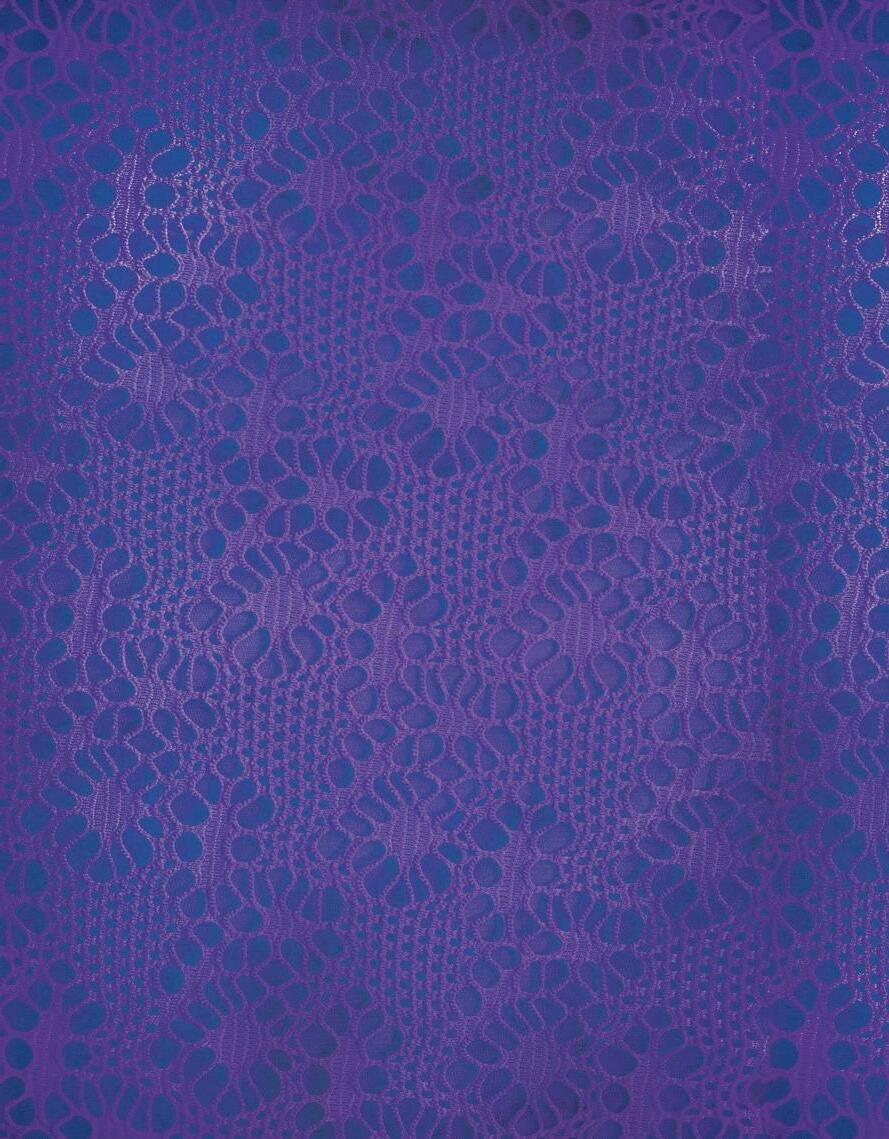





saveur means taste, and the name says it all 204 Montezuma, Santa Fe, New Mexico a Breakfast, Lunch, and Catering Open Mondays through Fridays a 8:00am to 2:30pm a 505-989-4200 After 19 years, Saveur is still going strong. With 51 years in the restaurant business, our work is our passion and we love our community. Saveur Bistro Gourmet Breakfast & Lunch
Chef Olea’s Legacy

GRACE, DEDICATION, AND PASSION PROVE TO BE HIS LIFE’S SECRET INGREDIENTS
BY VANI RANGACHAR PHOTOGRAPHY BY DANIEL QUAT FOR TREND
Passion Palate of the
230 TREND art + design + culture 2023
He’s dedicated, effortlessly creative, resilient, and as warm as his signature Sopa de Amor made of green chile, crab, amaretto foam, and a seductive touch of chocolate. And we’d all be better off if we had a bit of Fernando Olea in us.
No chef in Santa Fe is as beloved and well-known as Olea, thanks in part to his ever-present cowboy hat and the fact that he looks a lot like actor Robert Duvall.


For more than 30 years Olea has been giving the “city different” a cuisine unlike any other. In 2022 he won both a coveted James Beard Award and Chef of the Year honors from the New Mexico Restaurant Association.
But it hasn’t all been an easy ride. A fire closed his renowned restaurant Sazón in 2019. Then the pandemic forced another shutdown, so he switched to a takeout menu of Mexican street food like tacos, flautas, and tostadas. And just last fall, he suffered a stroke.
Olea was at the restaurant when he felt dizzy, so he went home. “I tried to put on my boots and couldn’t balance, so we called 911,” he says. A helicopter flew him to the University of New Mexico hospital in Albuquerque, where he stayed five days submitting to “every kind of test.” He could touch his nose and say what the date was, so the doctors called it a minor stroke and released him.
He went directly to Sazón’s kitchen, with no back-frombeyond transformations. “I see life the same way,” he says. “I’m very thankful to God, and I know there is one.”
His faith is based on a traditional Roman Catholic upbringing in Mexico City. These days he doesn’t always go to church, but he prays all the time and carries a St. Michael Archangel medal around in his pocket.
Olea came to the US as a young man to manage a family-owned furniture store in Minneapolis, Minnesota, then moved to Santa Fe to sell beds and sofas for the same family. They also owned Bert’s Burger Bowl, a longtime favorite in Santa Fe, and when they retired in the early 1990s, they asked Olea to take over. “I told them I knew nothing about food and even less about the restaurant business,” he recalls. “But they said not to worry. They would teach me everything I needed to know.” He thought
Top: The chef inspects habanero peppers from Rio Lucera Farms near Taos.
Left: Olea chats with diners in front of a large painting depicting the ingredients for mole.
trendmagazineglobal.com 231
Opposite: Olea wears his signature cowboy hat at the grill. He says it helps everyone in the kitchen know where he is.


Passion Palate of the
232 TREND art + design + culture 2023
A luscious shaved and caramelized beet salad, accompanied by snow peas, roasted almonds, and piñon nuts. Top: Colossal shrimp on handmade spinach pasta in tuna sauce.

trendmagazineglobal.com 233
Aged Angus beef tenderloin with baby vegetables in a spinach sauce.
Passion Palate of the
Sazón’s stunning Princesa dessert made of egg custard (natilla), layers of light pastry, assorted berries, and piñon nuts.

234 TREND art + design + culture 2023
Santa Fe magical from the start, and then found a passion for cooking, especially when he recalled the food of his Mexican childhood. “My mum, sister, and aunt were all really good cooks and they sent me their own traditional recipes. Back then people had time to cook, and they created great food at home.”
He refers to this deeply rooted Mexican family cuisine as alta cosina Mexicana, now offered at fancy restaurants in Mexico City. Different from Tex-Mex and New Mexican food, Olea’s alta cosina Mexicana introduced diners to gourmet mole sauce, salsa that sits as a condiment in the middle of table, and other authentic Mexican dishes such as chiles en Nogada, a recipe from the city of Puebla. Made with nuts, it is reminiscent of Lebanese cuisine.
Olea opened Sazón in 2015 on the south side of downtown. The multilevel adobe-style building is adorned with bronze horse sculptures by Siri Hollander outside. Inside, large, bright, and romantic paintings by contemporary Mexican artists cover the walls. The restaurant was an immediate success. “People were starting to pay attention to Mexican culture,” recalls Olea. “It was a perfect time to open.”
Sazón’s true magic is in the food, which has evolved as Olea practices his personal alchemy on classic Mexican recipes from his family. Though he has had no formal training as a chef, his instincts rarely fail him. To the spices he gets from Mexico, he adds others from around the world. The results are the original recipes for which he’s famous, like his ever-popular stuffed zucchini blossoms. “Something whispers to me,” he says. “I think in flavors. Sometimes I dream recipes. It is all very natural, very easy.”
He makes a point of visiting each table to welcome and advise the diners, a custom common in fine European restaurants. “It’s important to connect with people on a personal level,” he says. “I like them to feel like dinner guests, instead of just customers.”
People have offered him the chance to open restaurants in other places, but Olea isn’t interested. “Santa Fe is a special town, which has really been amazing for me,” he says. “Anywhere else, I wouldn’t have been able to be inspired and to blossom as I have here. It has been my home now for the past 33 years, and I’m just so glad that Santa Fe wanted me to be here.” R
 Chef Olea at the Sazón bar, which features flights of premier Mexican tequilas.
Chef Olea at the Sazón bar, which features flights of premier Mexican tequilas.
trendmagazineglobal.com 235
Celebrating 13 Years on Museum Hill
Yes, it’s been 13 years, and still going strong, serving what we consider comfort food; simple food done well, the pictures tell the story.
So whether it’s lunch Tuesday thru Friday Or brunch/lunch Saturday and Sunday, we have your afternoons covered.


So come up to Museum Hill Cafe, 100 miles of views, one of the largest covered patios in Santa Fe, A darn good wine and beer list, and plenty of free parking.

Tuesday thru Sunday 11-3
Reservations suggested 505-984-8900
We reserve our evenings for your private parties.
Wine Wednesday with Weldon & Friends

Follow Us:








MUSEUM HILL CAFÉ
710 Camino Lejo, Santa Fe, NM 87505 505.984.8900 www.MuseumHillCafe.net
13
One-of-a-kind Santa Fe home designed by renowned architect Ricardo Legorreta. Located in gated Circle Drive Compound and surrounded by incredible mountain views. Rastra construction, 3 bedroom, 3.5 baths, 5800 sq. ft., 5.7 acres. Price available upon request. LIZ




SHEFFIELD
Liz Sheffield Associates& Selling Santa Fe. All Areas. All Prices. Each Office Independently Owned/Operated- Independent Member Broker- All information contained believed to be correct- Equal Housing Opportunity. 130 Lincoln Ave, Santa Fe NM 505-983-5151
OGILVIE
| Keller Williams Realty 505-660-4299 | lizsheffield.com
PETER
Ever Evolving: The Cuisine of New Mexico

Four dynamic restaurants prove that nothing ever stands still when it comes to food and fine dining in and around Santa Fe

 BY ESTHER TSENG | PHOTOGRAPHY BY PETER OGILVIE FOR TREND
BY ESTHER TSENG | PHOTOGRAPHY BY PETER OGILVIE FOR TREND
Passion Palate of the
trendmagazineglobal.com 239
NOSA
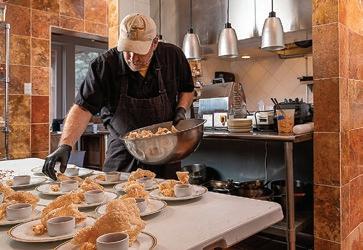

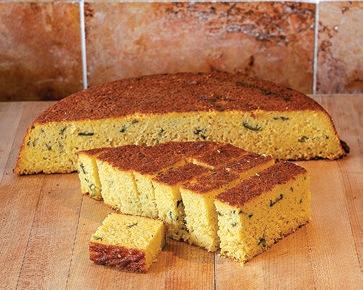



Palate of the
Passion
Clockwise, from top left: NOSA chef-owner Graham Dodds chops scallions in his kitchen; Ojo Farms sunshine kabocha squash with black-eyed peas and pecans; the chef finishes off chicharrónes; green chile cornbread; “Bowl of Red” chili with crème fraîche, scallions, and white cheddar; pimento cheese and hot sauce for chicharrónes. Opposite: Farm-to-table, prix-fixe meals in an elegant setting near Ojo Caliente, New Mexico. Previous page: Festively topped pozole at Katharine Kagel’s Cafe Paqual’s.
240 TREND art + design + culture 2023
On paper, Graham Dodds might appear to be a newcomer to Northern New Mexico. After all, he arrived in Santa Fe from Texas in 2021, having cheffed at Bolsa, Wayward Sons, and Central 214, all in Dallas. But he says he’d been drawn to the Santa Fe area since his first visit in the ’90s. So, he bought, renovated, and began operations at NOSA Restaurant and Inn near Ojo Caliente mineral springs last July. “This is such an upgrade. I love it.”
NOSA—simultaneously slang for North of Santa Fe” and an evocation of the feminine singular Spanish word for “ours”—is a 30-mile drive from the City Different. Overlooking the Jemez Mountains, it occupies what was originally a bed-and-breakfast with a Relais & Châteaux distinction. “They were the only ones in the Southwest,” says Dodds.
The B&B’s original owners built the restaurant so that their guests would have a place to have dinner in an area without many options for eating out. Now with Dodds in the kitchen, single-handedly cheffing stellar farm-totable, prix-fixe meals, NOSA is set to become a Northern New Mexico star, attracting people not just for special occasions but also for exploring an area full of culture and natural beauty.

When the restaurant first opened, Dodds hadn’t obtained his liquor license yet, so he provided only lunch service and nonalcoholic beverage pairings. Now, almost unanimous praise peppers the reviews of his five-course lunches and dinners, which source local products and are themed to whichever cuisine or ingredient inspires him at the moment. “I tend to change up the menus often and try to make it so people can’t put me in a category,” he says. “But there’s typically a common thread or kind of a narrative to the menu.”
Showcasing local bounty in his internationally focused cooking is Dodds’ m.o. “Seems miraculous that they can grow this stuff out here,” he says. He has been sourcing sunshine kabocha squash, garlic, and radicchio from Ojo Farm in Ojo Caliente, as well as autumn frost squash and hakurei turnips from Vagabond Farmers in La Puebla.
The restaurant and four-room inn are reasons themselves to visit, but just 12 miles to the north are Ojo Caliente Mineral Springs Resort & Spa and Ra Paulette’s stunning Windows of the Earth cave sculpture. Eighteen miles west is Georgia O’Keeffe’s Ghost Ranch, open for tours, hiking, and horseback riding. All of which makes NOSA a great spot to get to know wild and wonderful Northern New Mexico.
trendmagazineglobal.com 241
THE COMPOUND
Mark Kiffin has been the owner of The Compound since 2020. But the storied restaurant’s history goes back to 1966, when it was the centerpiece of the McComb Compound, a secluded getaway for industrialists, movie stars, and socialites. Today the restaurant has the same cachet, a world-class menu under Kiffin, and—as of last summer—Weston Ludeke, who relocated from Charlottesville, Virginia, to become executive chef.
That it took two years to find just the right person for the position says a lot about the high regard Kiffin has for Ludeke. He says that he wanted Ludeke’s unique talents to come to the City Different. “He’s one of the best cooks I’ve ever had an opportunity to work with,” says Kiffin, who won a James Beard award in 2005.
Before his arrival at The Compound, Ludeke was chef de cuisine for Marigold at Keswick Hall, near Charlottesville, Virginia, a restaurant created by the preeminent French chef, Jean-Georges Vongerichten. He brings the experience and discipline required to maintain the high quality expected at The Compound. Kiffin and Ludeke estimate that 75% of their customers are not only lo -
cals but also regulars. Some even have a favorite table they reserve for the same time and the same day every week. Their frequent visits make them so in tune with the menu’s seasonality that they’ve come to anticipate changes about every 90 days.
The menu is international. “We’re really drawn to Italy, France, and Spain,” says Kiffin. At the same time, The Compound is a contemporary American eatery with a clear focus on seasonality.

What’s showcased at The Compound throughout the seasons? The best produce and products wherever they are found. “It’s better to get great ingredients that are indigenous,” says Kiffin. That means morels from Oregon, chanterelles from Washington, foie gras from New York’s Hudson Valley, and sturgeon from California’s Sacramento River tempering local ingredients like potatoes, stone fruit, and corn—when it’s best.
With a new chef, the restaurant is on course to continue wowing loyal, gourmet-loving locals as well as visitors to Santa Fe. At The Compound on storied Canyon Road both can enjoy a fantastic meal—plate by plate, season by season.
Passion Palate of the
242 TREND art + design + culture 2023



 Clockwise, from top left: The Compound’s new executive chef Weston Ludeke; the chef wields his knife on a piece of duck; the duck goes into the sauté pan; duck confit served at The Compound.
Clockwise, from top left: The Compound’s new executive chef Weston Ludeke; the chef wields his knife on a piece of duck; the duck goes into the sauté pan; duck confit served at The Compound.
trendmagazineglobal.com 243
Opposite: A special dining room at The Compound designed by Alexander Girard with his Sun sculpture.
ESCONDIDO
Fernando Ruiz, chef and owner of Escondido, slated to open this fall, is a star who started cooking in the Santa Fe kitchens of Rio Chama, La Boca, and Santacafé. Then came TV cooking competitions like Guy’s Grocery Games and Chopped: Beat Bobby Flay, which he aced. But Ruiz doesn’t have the air of a smug TV personality; he leads with the humility of a man who has a second lease on life.

Before Ruiz, who grew up in Phoenix, had his run of TV cooking show wins, he did time for trafficking drugs and guns and worked in prison kitchens. After his release, he studied at the Scottsdale Culinary Institute in Arizona. Old affiliations with unsavory characters would have given him valid reasons for keeping out of the public eye. But thanks to the everlasting encouragement of his wife, Michelle Romero, Ruiz went on to win on every Food Network show in which he appeared. Never mind his sketchy past. “All the people I grew up with—they’re all dead or doing life in prison,” says Ruiz.
It has been a bumpy road to Escondido, but thanks to
Ruiz’s partnership with Vince Kadlubek—cofounder of Meow Wolf, the immersive art and entertainment showcase started in Santa Fe and now expanded to Las Vegas and Denver—there’s every reason to believe that the restaurant will rule.
Ruiz is planning a menu that draws upon the influences of his hometown, Guyamas, Mexico, on the Sea of Cortez. Seafood will be a focal point. Think fresh fish and cockles delivering bright and crisp notes countered with hot platters slathered in complex, comforting, and tradesecret sauces.
And because his grandfather owns a cattle ranch in Sonora, expect top-notch carne asada. “I want to do tacos, ceviches, and moles with a little twist here and there.” Mexican spirits like tequila, mezcal, bacanora, and sotol will also be featured at Escondido.
There’s plenty to look forward to. It’s an auspicious start for a new Santa Fe restaurant, and for a future in which Ruiz will be able to control his destiny and reap the rewards of his success.
Passion Palate of the
244 TREND art + design + culture 2023



trendmagazineglobal.com 245
Clockwise, from top left: classic shrimp and scallop ceviche; Chef Ruiz grills a steak for his signature tacos; steak tacos “but with a little twist here and there,” according to Ruiz. Opposite: Ruiz chops greens for tacos.
CAFE PASQUAL’S
It is no overstatement to say that since its beginnings in 1979, Cafe Pasqual’s, a block off the Plaza, has evolved into a bona fide culinary and cultural tour de force in Santa Fe’s dining and art scene. The mission is simple, says Katharine Kagel, the cafe-restaurant’s founder and chef. “Make the best possible food with the best possible ingredients, but without attitude. We want to make it joyful and nourishing, and make people feel good,” she says.
Kagel’s commitment to using as many organically sourced ingredients as possible reflects her uncompromising attitude toward health. She estimates that 98% of her menu’s offerings, like the Durango omelet with red or green

Passion Palate of the
246 TREND art + design + culture 2023



trendmagazineglobal.com 247
Clockwise, from top: Cochinita Pibil Yucatan-style, wrapped in banana leaves and accompanied by plantain chips; Kagel’s rich and nourishing pozole; hearty, healthful cornbread accompanies pozole. Opposite: Cafe Pasqual’s owner-founder Katharine Kagel serves pozole from a mica-rich pot made by ceramic artist Felipe Ortega.
Trend magazine is celebrating 25 years in print in 2024.


400 plus pages and will also be offered as a hardbound book.
Looking back and celebrating the art + design + culture that is our legacy
To order a special first-print, hardbound copy of our June 2024 25th anniversary issue, mailed to your home in the US. Send a check to Trend for $250.00 to P.O. Box 1951, Santa Fe, NM 87504.

Passion Palate of the



chiles, tostada with seared Arctic char, and asadero cheese chile relleno, are made of organic ingredients. “Some people say, ‘I can’t afford organic food,’ and I say, ‘You can’t afford not to. It’s your health; you’re going to taste the difference and feel better.’” Also nourishing to the senses are the murals by Leovigildo Martinez Torres that line the cafe’s walls. Kagel met the artist 30 years ago in Oaxaca, Mexico, and was inspired to ask him to paint them and expand the restaurant into a gallery. “We always eat with our eyes first,” says Kagel, who is a mixed-media artist working in monoprint, collotype, lithography, ceramics, painting, and drawing. Also featured in the restaurant-
gallery is mica-rich local clay cookware made by Felipe Ortega, who is a medicine man with Jicarilla Apache and Hispanic heritage. His clay cook pots can rest directly on top of flame and infuse food with a subtle sweetness you don’t get with metal cookware. Kagel puts them in the Moroccan oven that Ortega built in her backyard. Sharing these cooking methods through the art of pottery is integral to the restaurant’s mission.
In the end, it all comes down to fostering an understanding about where food comes from. “The arc of people understanding their food is fantastic and I’m thrilled that people are demanding the best,” says Kagel. R
248 TREND art + design + culture 2023
A luscious pomegranate martini is among the specialty cocktails served at Cafe Pasqual’s.




trendmagazineglobal.com 249
Of Farm Stands and Food Security
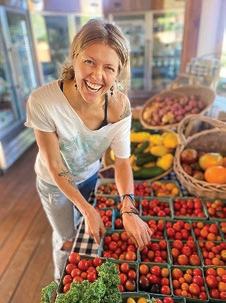 BY SUSAN SPANO
BY SUSAN SPANO
Take wood mulch and some raw food waste (the stuff in the trash that once was alive), pump air into it, or, in an alternate process, add worms (red wigglers preferred) and let it sit for a few months. Voilà! Really good soil.
That’s basically what they do in the Soil Yard at Reunity Resources, a not-for-profit in Agua Fria Village, on the west side of Santa Fe. It sells gold-standard compost to landscapers and home gardeners who prefer it to synthetic commercial brands.
The yard was established in 2016 by Juliana and Tejinder Ciano and is managed by Trevor Ortiz in the belief that high-quality soil is central to sustainable food production. It enriches our farms and gardens, and stores carbon dioxide underground rather than in the atmosphere where it contributes to global warming. Juliana admits that collecting raw food waste from schools, restaurants, and individuals to compost at Reunity is gnarly business. But reusing it for soil keeps the food production cycle
local and avoids the release of methane in landfills.
“You don’t need a PhD to compost successfully,” says Juliana, who—go figure—got her bachelor of arts in theater but looks quite at home in a flat, muddy field with big, brown steaming mounds of compost-in-the-making.
Reunity’s methods are relatively cheap and simple enough for anyone to execute: pumping air into the mulch-waste mixture while it sits, heating up, or alternatively, letting worms loose on food scraps with compost as a result.
The game changed this spring when they introduced a new approach, producing a super-soil supplement that has the umph of a strong immune system. The key, based on recent, globally recognized soil research by David Johnson, a molecular biologist at the Institute for Sustainable Agricultural Research, New Mexico State University, Las Cruces, is a heightened fungal-to-bacteria ratio.
As it turns out, the science of soil is way more complicated than the simple
art of composting. “There’s a great deal we don’t know about how soil works. It’s like the deep ocean,” Juliana says.
The Soil Yard is just one Reunity program aimed at changing the way we produce, distribute, and consume food. Responding to its location in a USDAdesignated area with low food access, the not-for-profit created a community fridge and pantry. The pantry is open 24/7 to anyone, no questions asked. And when the two-acre urban garden yields produce, the Reunity Farm Stand opens, welcoming everyone who needs food or wishes to donate. In season, field volunteers help in the garden, further supplying the Farm Stand and fridge.
Education, especially for children, starts this month with Reunity’s Farm Camp for Kids, an acclaimed program
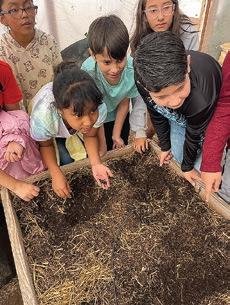

Local not-for-profit Reunity Resources is finding new ways to improve our soil, food, lives, and planet
250 TREND art + design + culture 2023
Kids inspect a bin with red wiggler worms and compost-in-making; Moxie Bauschke at Reunity’s Farm Stand; during Farm Camp for Kids youngsters learn about sowing, harvesting, and healthy eating (photos courtesy of Reunity Resources).
that gives youngsters aged 4 to 10 a chance to participate in a variety of agriculturerelated activities—from sowing, transplanting, and harvesting to natural dyeing, fort-building, and making pollinator hotels—all in the outdoors. This summer Reunity offers junior camp counselor and counselor-in-training programs for teens as well.
And all summer Reunity stages cultural events, concerts, and workshops,
Farm Stand
spreading the word about how everyone can contribute to improving food security and the environment around us. The organization that started in 2011 to recycle used cooking oil as biodiesel fuel now has two dozen seasonal workers and is 85% financially self-supporting. Juliana has a moving way of explaining why she and Tejinder started Reunity. “We asked ourselves what does the community need? What do I need? What can I do?”
April through September: Monday to Friday, 8:00 a.m. to 4:00 p.m.; Saturday, 9:00 a.m. to 1:00 p.m.
October through March: Monday to Friday, 9:00 a.m. to 4:00 p.m.; closed weekends.
Doorstep Compost Collection for the Soil Yard can be arranged by calling 505-750-4764 or at https://www.reunityresources.com/doorstep.html.
Drop-In Volunteer Days: Thursday and Saturday from 9:00 a.m. to noon. RSVP online at https://www.reunityresources.com/volunteer.html.
Farm Camp for Kids, ages 4–10, June 5–August 18, weekdays from 9:00 a.m. to 3:00 p.m.
Farm Camp Counselor-in-Training, ages 15–7, same dates and hours as Farm Camp for Kids.

Junior Counselor Training, ages 10–14, June 19–30 and July 10–21, 9:00 a.m. to 3:00 p.m.
Note: Farm Camps fill up fast; if the one you’re interested in is full, put your name on the waiting list: farmcamp@reunityresources.com.
Concerts, Festivals, and More Creative movement for 3–6-year-olds, June to August, Sunday, 10:00 a.m. to 10:45 a.m.
Singalongs for Children, June to September, second Sunday of the month, 10:45 a.m.
Andy Mason Music for Families, June 2, 6:00 p.m.
High Desert Trio, Summer Concert Series, June 9, 7:00 p.m.
Medium Bird, Summer Concert Series, June 16, 7:00 p.m.
Ugly Music Day with we.grow.eco, June 22, 6:00 p.m.
Half Broke Horses, Summer Music Series, June 30, 7:00 p.m.
Santa Fe Review, Summer Music Series, July 8, 7:00 p.m.
Storytelling with Joe Hayes, July 9, 16, 23, and 30, 7:00 p.m.

Ugly Music Day with we.grow.eco, July 27, 6:00 p.m.
Rose's Pawn Shop, Summer Concert Series, August 5, 7:00 p.m.
Korvin Orkestar, Summer Concert Series, August 18, 7:00 p.m.
David Berkely, Summer Concert Series, September 8, 7:00 p.m.
Fall Festival, September 23 and 24, 3:00 p.m. to 6:00 p.m.
Reunity Resources, 1829 San Ysidro Crossing in Agua Fria Village, is open from June to September, Thursday to Friday, 3:00 p.m. to 8:00 p.m., Saturday to Sunday, 9:00 a.m. to 1:00 p.m., and on weekends, in October. For more information, consult the website: https://www.reunityresources.com.
trendmagazineglobal.com 251
ANTIQUES, HOME FURNISHINGS, RUGS & ACCENTS
Bon Marché bonmarcheonline.com; 505-995-1000.................................33
Bosshard 505-685-0061....................................................................181
Claiborne Gallery 505-982-8019......................................................................70
The Collective thecollectivesantafe.com; 505-230-7000......................14–15
Double M / Mattress Mary’s Taos Lifestyle taoslifestyle.com; 575-758-5885.................................158–159
Reside Home howyoureside.com; 505-780-5658...........................202–203
The Rugman of Santa Fe therugmanofsantafe.com; 505-988-2393..........................256
Santa Fe Rockers sfrockers.com; 505-490-9003.............................................26
Santa Kilim santakilim.com; 505-986-0340......................................... 204
Sleep & Dream Luxury Bed Store mysleepanddream.com; 505-988-9195.............................219
Victoria at Home victoriaathome.com; 505-365-2687............................16, 222
Violante & Rochford Interiors vrinteriors.com; 505-983-3912..........................................2–3
ARCHITECTS & DESIGNERS
Annie O’Carroll Interior Design annieocarroll.com; 505-983-7055......................................222
Archeao Architects archaeoarchitects.com; 505-820-7200..............................222
Clemens & Associates Inc. clemensandassociates.com; 505-983-0130......................218
Hoopes + Associates Architects hoopesarchitects.com; 505-986-1010...............................205
Lisa D. Martinez / B Constructive LLC mtzarchitecture.build; 505-470-7888.........................220–221
Martinez Architecture Studio martinezarch.com; 505-989-4958.............................220–221
Max Vasher Architect maxvasherarchitect.com; 505-615-0696..........................223
Palo Santo Designs palosantodesigns.com; 505-988-7230................................44
Reside Home howyoureside.com; 505-780-5658............................202–203
Samuel Design Group samueldesigngroup.com; 505-820-0239.......................46–49
Tierra Concepts tierraconceptssantafe.com; 505-989-8484........................222
Victoria at Home victoriaathome.com; 505-365-2687............................16, 222
Violante & Rochford Interiors vrinteriors.com; 505-983-3912..........................................2–3
Woods Design Builders woodsbuilders.com; 505-988-2413....................................IFC
ADVERTISERS
ARTISTS & GALLERIES
Alvaro Cardona-Hine cardona-hinegallery.com; 505-629-9241.......................76–77
Andrea Fisher Fine Pottery andreafisherpottery.com; 505-986-1234............................ 93
Art Is Gallery artisgallerysantafe.com; 505-629-2332...............................92
Bette Ridgeway Studio ridgewaystudio.com............................................................19
Bill Hester Fine Art / Sean Wimberly billhesterfineart.com; 505-660-5966.......................62–63, BC
Canyon Road Contemporary / Phyllis Kapp / Mark Bowles Lydia Piper / Dena Tollefson canyoncontemporary.com; 505-983-0433 ...............106–109
Cara Romero Photography cararomerophotography.com............................................136
Charlotte Shroyer charlotteshroyer.com; 575-751-0375 .................................28 Claiborne Gallery 505-982-8019......................................................................70
David DeStefano destefanosculpture.com; 505-670-2381............................168
Diego J. Velázquez diegojvelazquez.com; santafemetal.com...........................118
Eye on the Mountain Art Gallery eyeonthemntgallery.com; 928-308-0319...........................249
Faust Gallery faustgallery.com; 480-200-4290.......................................6–7
Hat Ranch Gallery hatranchgallery.org; 505-424-3391......................................41
Hebé García Fine Art Studio hebegarcia.com; 505-690-9888................................185–187
Jaira Stewart jairaandglass.com; 505-795-3865.....................................251
Jim Baker sacredstructuresart.com; 505-685-4851...................188–189
Jim Woodson jimwoodsonart.com; 505-929-7489..........................182–183
Kay Contemporary Art / Kate Rivers kaycontemporaryart.com; 505-365-3992............................23
Keshi the Zuni Connection keshi.com; 505-989-8728....................................................31
Kevin Box Studio origamiinthegarden.com; 505-471-4688..............................22
La Mesa of Santa Fe / Christopher Thomson Ironworks lamesaofsantafe.com; 505-984-1688..................................37
Lew Allen Galleries / David Rothermel lewallengalleries.com; 505-988-3250..................................18
Manitou Galleries / Ethelinda manitougalleries.com 505-986-0440, 505-986-9833.......................................12–13
Mary Stratton marystrattonart.com; 575-770-0760..................................169
Nest abiquiunest.com; 520-289-0656........................................184
Niman Fine Art / Dan, Arlo, and Michael Namingha namingha.com; 505-988-5091.............................................21
Patricia Carlisle Fine Art / David Pearson carlislefa.com; 505-820-0596...........................................4–5
Pie Projects Contemporary Art pieprojects.org; 505-372-7681......................................90–91
Pop Gallery popsantafe.com; 505-820-0788.........................................45
Prescott Gallery prescottstudio.com; 505-424-8449..............................74–75
Somers Randolph somersrandolph.com; sculptr@aol.com......................71–73
Stacy Nixon Contemporary Fine Art stacynixonart.com; 619-204-1632......................................222
Stan Berning’s Art Box stanberningstudios.com; 928-460-2611.............................8–9
Thom Tex Wheeler thomwheeler.com; 575-737-1260.........................................29
Tierra Mar Gallery / Jarrett West Sculptures tierramargallery.com; 505-372-7087 43 Webster Collection webstersantafe.com; 505-954-9500..................................25
Wiford Gallery wifordgallery.com; 505-577-0888..........................17, 65–67
Yenny Cocq yennycocqsculpture.com; 505-670-6053...........................64
BUILDERS, LIGHTING, FIXTURES & MATERIALS Counter Intelligence, LLC handscraftsmen.com; 505-988-4007 ..............................222
Custom Window Coverings cwcsantafe.com; 505-820-0511......................................222
Douglas Maahs dmaahsconstruction.com; 505-992-8382.........................200
H and S Craftsmen handscraftsmen.com; 505-988-4007...............................222
La Luz Artful Lighting laluzsf.com; 505-954-1149...............................................222
Palo Santo Designs palosantodesigns.com; 505-988-7230................................44
Pella Windows and Doors pellabranch.com; 505-474-4112.......................................222
Santa Fe By Design santafebydesign.com; 505-988-4111...............................222
Tierra Concepts tierraconceptssantafe.com; 505-989-8484........................222
Woods Design Builders woodsbuilders.com; 505-988-2413...................................IFC
CITY SERVICES, EDUCATION, EVENTS & MUSEUMS
Abiquiu Studio Tour / Abiquiu News abiquiuguide.org; abiquiustudiotour.org; abiquiunews.com .............................................................180
City of Santa Fe Environmental Services santafenm.gov/public-utilities/trash-and-recycling 505-955-2200...................................................................218
Museum of Contemporary Native Arts iaia.edu/mocna; 505-983-8900.........................................137
Ride to the Rescue horseshoecanyonrescueranch.org; ridetotherescue.org 575-638-5041...................................................................184
252 TREND art + design + culture 2023
32 SUNFLOWER DRIVE. This sophisticated and contemporary residence in Las Campanas Estates was built by architect/builder Seth Anderson and is perfectly sited on the 2.32 acre property to take advantage of the Sangre de Cristo Mountains and the vast westerly views. Lovely antique accents intertwine with modern, artistic finishes in this exquisite 4,400 sq. ft. home with 3 bedrooms, 2 1⁄2 baths, sitting area, office, and state- of- the- art kitchen. Enchanting outdoor spaces blend into the residence, creating an indoor/outdoor living space for enjoying all the wonderful seasons of Northern New Mexico. $4,185,000
1395 BISHOPS LODGE ROAD, A & B. This splendid Tesuque property, adjacent to the river and the Acequia Madre, offers both a main house (3,432 sq. ft., 3 bedroom, 3 bath) and guest house (3,014 sq. ft., 3 bedroom, 3 bath) sitting on three parcels of land, 2.66 acres in total. Both homes are traditional Northern New Mexico style, with pitched metal roofs, and big divided windows and doors. Inside, wooden beam and plank ceilings create tall, open, airy rooms, while wooden plank floors mimic the warmth of the ceilings. This property is gorgeous with tall pines, blue spruce, and a variety of deciduous trees, green grass and gardens everywhere. $4,500,000
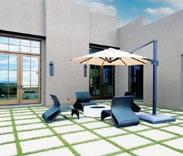
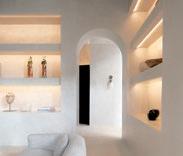

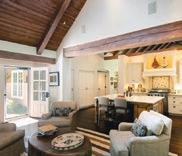


433 W. San
Street, Santa Fe, NM 87501 tel: 50 5. 98 9.7741 • www . dresf . com A Full Service Real Estate Brokerage
Francisco
Visit us on the web at www.dresf.com or www.Leverage RE.com. opening doors in santa fe for over 33 years ... expect more. contemporary or classic?
126 East Palace Avenue, Santa Fe, NM 505.982.8972 | gustermansantafe.com
ADVERTISERS
Santa Fe County santafecountynm.gov; 505-986-6200.....................................................257
Santa Fe Wine & Chile Fiesta santafewineandchile.org; 505-438-8060.................................................255
Site Santa Fe sitesantafe.org; 505-989-1199................................................................119
EYEWEAR, BEAUTY & HEALTH
Quintana Optical 505-988-4234...........................................................................................24
FASHION, JEWELRY & ACCESSORIES


The Golden Eye goldeneyesantafe.com; 505-984-0040......................................................34
Grace wearyourgrace.com; 505-780-5611............................................................1
Gusterman gustermansantafe.com; 505-982-8972...................................................254

John Rippel U.S.A johnrippel.com; 505-986-9115...................................................................27
Keshi the Zuni Connection keshi.com; 505-989-8728.........................................................................31
Nest abiquiunest.com; 520-289-0656.............................................................184
Toko Santa Fe tokosantafe.com; 505-470-4425...............................................................20
Wear Abouts wearaboutssf.com; 505-982-1399..........................................................249
PHOTOGRAPHY
Cara Romero Photography cararomerophotography.com.................................................................136
Gerd J. Kunde analog-capture.com; 505-920-9424...................................................68–69
REAL ESTATE
Dougherty Real Estate Co. LLC dresf.com; 505-989-7741.......................................................................253
Giorgetti Real Estate / Studios at Parkway / Keller Williams studiosatparkway.com; 505-670-7578.....................................................44
Liz Sheffield / Keller Williams Realty lizsheffield.com; 505-660-4299...............................................................238
Pacheco Park officespacesantafe.com; 505-780-1159.................................................222
Webster Collection / Sotheby’s International Realty webstersantafe.com; 505-954-9500.........................................................25
RESTAURANTS, FOOD, DRINK & LODGING Back Road Pizza backroadpizza.com; 505-955-9055.........................................................228
Coyote Cafe coyotecafe.com; 505-983-1615...............................................................11
Museum Hill Café museumhillcafe.net; 505-984-8900................................................236–237
Santacafé santacafe.com; 505-984-1788..................................................................10
Saveur Bistro saveurbistro.com; 505-989-4200............................................................229
Ten Thousand Waves tenthousandwaves.com; 505-982-9304.................................................224
WENDY MCEAHERN PHOTOGRAPHY

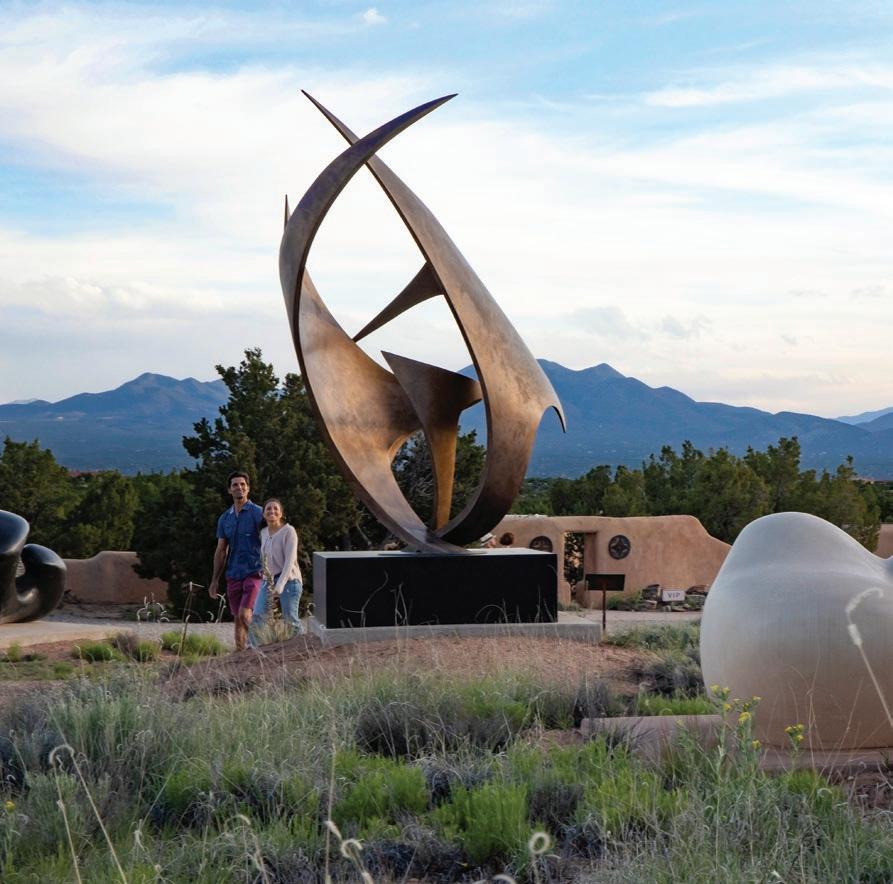


130-A Lincoln Avenue 505.988.2393 therugmanofsantafe.com
PHOTO: © WENDY MCEAHERN FOR PARASOL
PRODUCTIONS
It’s easy to love where you live and work when you’re in Santa Fe County. In addition to its rich blend of culture, art and technology, the area offers unrivaled outdoor adventures that feed the soul and spark the creative spirit.
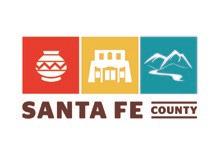


Storm over Pedernal, acrylic on canvas, 54” x 42” 613 Canyon Road Santa Fe, NM 87501 billhester@billhesterfineart.com BillHesterFineArt.com (505) 660-5966 Sean Wimberly A Magical Place Bill Hester Fine Art















 View to Pojoaque / 8 AM, watercolor/gouache, 18” x 24”, 2021 Black Mesa / Clarified, watercolor/gouache, 18” x 24”, 2023
View to Pojoaque / 8 AM, watercolor/gouache, 18” x 24”, 2021 Black Mesa / Clarified, watercolor/gouache, 18” x 24”, 2023




































 Jennifer & Kevin Box Studio & Sculpture Garden
Jennifer & Kevin Box Studio & Sculpture Garden




























 By Elmo Baca
By Elmo Baca

























 BY JANNA LOPEZ
BY JANNA LOPEZ














 Trevor Mikula
Travis Bruce Black
Trevor Mikula
Travis Bruce Black




















 Kevin Moloney, longtime photojournalist for The New York Times, now teaches media design and development at Ball State University in Muncie, Indiana (photo by Sami Hensley).
Left: Casilda Salazar Moloney, “Nana,” on Christmas Day 1959 (photo by Paul F. Moloney).
Kevin Moloney, longtime photojournalist for The New York Times, now teaches media design and development at Ball State University in Muncie, Indiana (photo by Sami Hensley).
Left: Casilda Salazar Moloney, “Nana,” on Christmas Day 1959 (photo by Paul F. Moloney).









 Spring Arabesque by Rod Hubble, oil on linen, 12” x 12”
Spring Arabesque by Rod Hubble, oil on linen, 12” x 12”




 Snowstorm over Sangre de Cristo Mountains 2020, Analog Capture on Film, Silver Halide Print on Dibond, 72" by 24"
Below: Cloud Panel 2022, Analog Capture on Film, Silver Halide Print on Dibond, 140" by 70"
Snowstorm over Sangre de Cristo Mountains 2020, Analog Capture on Film, Silver Halide Print on Dibond, 72" by 24"
Below: Cloud Panel 2022, Analog Capture on Film, Silver Halide Print on Dibond, 140" by 70"
















 BY SUSAN SPANO | PHOTOGRAPHY BY LONNIE SCHLEIN
BY SUSAN SPANO | PHOTOGRAPHY BY LONNIE SCHLEIN

 At a market high in the Peruvian Andes about 20 miles north of Cusco, Chinchero village women prepare feasts for visitors.
Top: A street-food chef grills mouthwatering beef and chicken skewers in the red-hot shopping and entertainment district of Myeong-dong in Seoul, South Korea.
At a market high in the Peruvian Andes about 20 miles north of Cusco, Chinchero village women prepare feasts for visitors.
Top: A street-food chef grills mouthwatering beef and chicken skewers in the red-hot shopping and entertainment district of Myeong-dong in Seoul, South Korea.




 Beraku,
Beraku,

 A worker strolls past a stone arch along the banks of the fabled Li River in Guilin, China, known for its otherworldly karst mountains and terraced rice paddies.
A worker strolls past a stone arch along the banks of the fabled Li River in Guilin, China, known for its otherworldly karst mountains and terraced rice paddies.




















 SIR KENNETH CLARK
SIR KENNETH CLARK
 CARLOS FUENTES
CARLOS FUENTES



 LUCIAN FREUD
LUCIAN FREUD






 BY SIMON ROMERO | PHOTOGRAPHY BY ERIC DRAPER FOR TREND
BY SIMON ROMERO | PHOTOGRAPHY BY ERIC DRAPER FOR TREND




 Miranda Sanchez, 26, proudly shows off her Day of the Dead costume during the annual Albuquerque Marigold Parade.
Miranda Sanchez, 26, proudly shows off her Day of the Dead costume during the annual Albuquerque Marigold Parade.











 ~ Alberto Giacometti
~ Alberto Giacometti












































 BY CYNDY TANNER | PHOTOGRAPHY BY KATE RUSSELL
BY CYNDY TANNER | PHOTOGRAPHY BY KATE RUSSELL











 The completed glass sculpture, what TIME TRAVEL feels like, sometimes, holds pride of place in Wanenmacher’s studio, a converted auto repair shop.
The completed glass sculpture, what TIME TRAVEL feels like, sometimes, holds pride of place in Wanenmacher’s studio, a converted auto repair shop.















 Miracle of Life and Death, 90”x23”x22”, Texas limestone;
Bottom right: Mother and Child, 28”x23”x21”, Indiana limestone;
Bottom left: Work in progress, 85”x12”x12”, Indiana limestone
Miracle of Life and Death, 90”x23”x22”, Texas limestone;
Bottom right: Mother and Child, 28”x23”x21”, Indiana limestone;
Bottom left: Work in progress, 85”x12”x12”, Indiana limestone

 BY GUSSIE FAUNTLEROY PHOTOGRAPHY BY AUDREY DERELL FOR TREND
BY GUSSIE FAUNTLEROY PHOTOGRAPHY BY AUDREY DERELL FOR TREND


 Clockwise, from top left: Michael McCabe, Conor Flynn (2021), monotype portrait on archival paper; Geoffrey Gorman, The Rust King and Queen (2016), mixed media and found objects; Estrella Encinias, Only One (2021), archival relief print; Shakti Kroopkin, Menagerie Escapes (2022), sumi ink on archival paper.
Clockwise, from top left: Michael McCabe, Conor Flynn (2021), monotype portrait on archival paper; Geoffrey Gorman, The Rust King and Queen (2016), mixed media and found objects; Estrella Encinias, Only One (2021), archival relief print; Shakti Kroopkin, Menagerie Escapes (2022), sumi ink on archival paper.











































 BY LUCY R. LIPPARD | PHOTOGRAPHY BY NANCY SUTOR AND LONNIE SCHLEIN
BY LUCY R. LIPPARD | PHOTOGRAPHY BY NANCY SUTOR AND LONNIE SCHLEIN


 From left: October 26, 2022 (with asters), archival pigment print, from the series Moon Flowers. The dates are the titles of these ritual compositions made using plants, water, and objects to commemorate full moons and other significant events. Karl Foerster reed grass at the garden fountain, where birds and insects find habitat, feed, and water (photo by Lonnie Schlein).
From left: October 26, 2022 (with asters), archival pigment print, from the series Moon Flowers. The dates are the titles of these ritual compositions made using plants, water, and objects to commemorate full moons and other significant events. Karl Foerster reed grass at the garden fountain, where birds and insects find habitat, feed, and water (photo by Lonnie Schlein).


































































































 Bottom, from left: Teresa’s magnificent hand-tied tamales (photo courtesy Teresa’s); pizza Margherita at the Blue Heron Brewery (photo courtesy Blue Heron); pizza dough headed for the oven at the Blue Heron (photo courtesy Blue Heron). Center, from left: ice cream flavors at Taos Cow (photo by Susan Spano); an artisanal charcuterie plate at Wolf ‘n’ Swallow (photo courtesy facebook/Wolfnswallow); Sean Sinclair’s award-winning Harvey Smashburger at the Castaneda (photo by Susan Spano). Top, from left: There’s more than ice cream on offer at Taos Cow (photo by Susan Spano); Chef Ryan Houlihan with one of his nonpareil charcuterie boards (photo courtesy Wolf ‘n’ Swallow); the friendly bar at the Castaneda Hotel (photo by Susan Spano).
Bottom, from left: Teresa’s magnificent hand-tied tamales (photo courtesy Teresa’s); pizza Margherita at the Blue Heron Brewery (photo courtesy Blue Heron); pizza dough headed for the oven at the Blue Heron (photo courtesy Blue Heron). Center, from left: ice cream flavors at Taos Cow (photo by Susan Spano); an artisanal charcuterie plate at Wolf ‘n’ Swallow (photo courtesy facebook/Wolfnswallow); Sean Sinclair’s award-winning Harvey Smashburger at the Castaneda (photo by Susan Spano). Top, from left: There’s more than ice cream on offer at Taos Cow (photo by Susan Spano); Chef Ryan Houlihan with one of his nonpareil charcuterie boards (photo courtesy Wolf ‘n’ Swallow); the friendly bar at the Castaneda Hotel (photo by Susan Spano).














 Chef Olea at the Sazón bar, which features flights of premier Mexican tequilas.
Chef Olea at the Sazón bar, which features flights of premier Mexican tequilas.












 BY ESTHER TSENG | PHOTOGRAPHY BY PETER OGILVIE FOR TREND
BY ESTHER TSENG | PHOTOGRAPHY BY PETER OGILVIE FOR TREND











 Clockwise, from top left: The Compound’s new executive chef Weston Ludeke; the chef wields his knife on a piece of duck; the duck goes into the sauté pan; duck confit served at The Compound.
Clockwise, from top left: The Compound’s new executive chef Weston Ludeke; the chef wields his knife on a piece of duck; the duck goes into the sauté pan; duck confit served at The Compound.

















 BY SUSAN SPANO
BY SUSAN SPANO

















